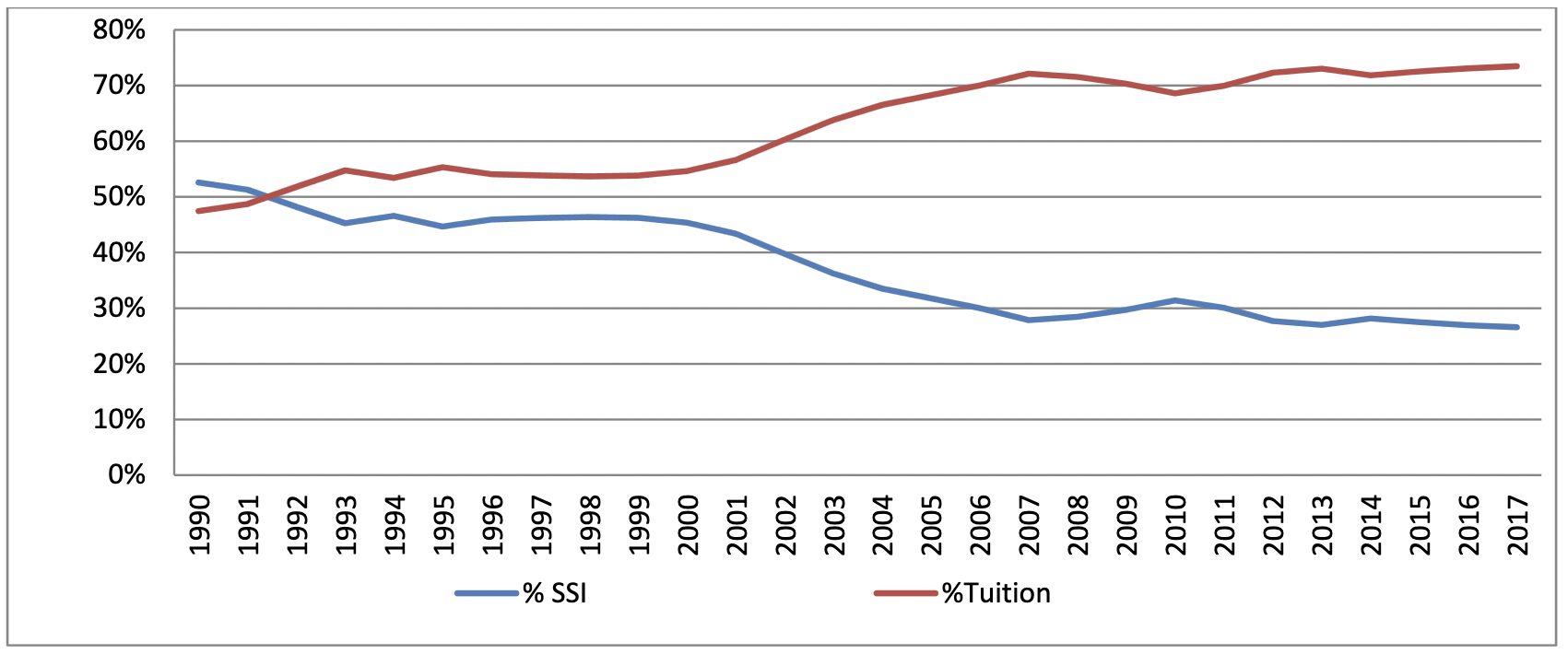
Higher Learning Commission
Multi-Location Visit Institutional Report
Instructions
Send the completed report as a single electronic file (in PDF format) to HLC at accreditation@hlcommission.org
, as well as to the peer reviewer assigned to conduct the visit. Brief
evidentiary materials may be included if they are necessary to support information provided in the report. The report is due 30 days prior to the visit.
Overview Statement
1. Provide a brief overview statement about current additional locations, and about the institution’s general approach to off-campus instruction. List the current approved active additional locations. Be sure to include with each location the full address and all academic programs offered at the location.
The purpose of Ohio University's regional campuses and additional locations is to provide students throughout Ohio with access to the same quality of educational experience they would receive at the Athens campus. Five regional campuses and four additional locations help meet that mission. Students, traditional and non-traditional alike, choose to study at a regional campus or additional location for a variety of reasons. Many are working full- or part-time, some are single parents, some have limited economic means, others want to improve their job opportunities or want to advance within their current careers, while some simply want to live where they reside while earning an associate’s, bachelor’s, or more recently, a variety of advanced degrees. OHIO's regional campuses and additional location students experience a vibrant, student-centered learning environment characterized by small class sizes, highly qualified professors, and appropriate uses of instructional technologies. Because Ohio University has a single curriculumfor all six campuses and four locations, the educational experience students receive is expected to be equivalent, and established learning outcomes are expected to be met, wherever the course is delivered and whatever mode of instruction is pursued.
-
Cleveland, 4180 Warrensville Center Rd., Cleveland, OH 44122
o Doctor of Osteopathic Medicine
-
Dublin, 6775 Bobcat Way, Dublin, OH 43016
o Doctor of Osteopathic Medicine
o Master of Physician Assistant Practice (MPAP)
o Master of Science in Nursing (MSN)
o Doctor of Nursing Practice (DNP)
o Master of Science and Dietetic Internship (MSDI)
o Master of Science in Athletic Training Program (MSAT)
o Master of Public Administration (MPA)
o Master of Business Administration (MBA)
o Master of Accountancy (MAcc)
-
Pickerington, 12933 Stonecreek Drive NW, Pickerington, OH 43147
o General education coursework provided
-
Proctorville, 111 Private Drive 516, Proctorville, OH 45669
o General education coursework provided
OHIO’s two newest additional locations, the focus of this multi-location review, were initially established from existing partnerships and relationships developed by our Heritage College of Osteopathic Medicine with Ohio Health (Dublin location) and the Cleveland Clinic (Cleveland location) and were initially created to recruit students from Central and Northeast Ohio who want to stay in those regions to train and practice medicine. Building upon this the Dublin location began serving the same purpose for other healthcare fields, and more recently, serving students that wish to purse advance degrees in public administration and business. The Dublin Executive Oversight Committee develops and implements a coordinated and comprehensive plan for maximizing the opportunities presented by the Dublin Extension campus including vetting, expanding, and strengthening the academic offerings; develop and implement a cohesive and comprehensive engagement plan for the fostering of the University's relationship with the City of Dublin and the surrounding communities; ensure continued stewardship and smooth and efficient operation of the Dublin Extension Campus; and shepherding the implementation of the Dublin campus master plan. This includes appointing appropriate points of contact for various projects, relationships, and initiatives, as well as for operational oversight of Dublin.
The Ohio University Heritage College of Osteopathic Medicine (OU-HCOM) offers the Doctor of Osteopathic Medicine (D.O) degree. The program is fully accredited by the American Osteopathic Association (AOA) Commission on Osteopathic College Accreditation (COCA). While the main site is located in Athens, Ohio, students can opt to train at either the Dublin or Cleveland locations for the D.O. degree. The Dublin location’s first class of 50 medical students began their classes in the 2014-15 academic year and graduated in May 2018. The Cleveland location welcomed its inaugural class of 50 students in the 2015-16 academic year and will graduate its first class in spring, 2019.
The Ohio University College of Health Sciences and Professions offers part or all of several graduate programs at the Dublin location: the Master of Physician Assistant Practice (MPAP), offered fully and solely at the Dublin location; the Master of Science in Nursing (MSN) and Doctor of Nursing Practice (DNP), both offered substantially online, but with students coming to the Dublin site (or Athens campus ) generally one time per semester for testing, workshops or "boot camp" type immersions for 3 to 5 days; the combined Master of Science and Dietetic Internship (MSDI) program, in which students complete their first two semesters at the Dublin location; and Post-Professional Master of Science in Athletic Training Program (MSAT), in which students may do their practica in either the Columbus area or the Athens area, and coursework is offered at both locations, with most coursework being taught on the Athens campus and delivered via PolyCom to students at the Dublin location (as a travel convenience for those doing practica in the Columbus area).
The Ohio University Voinovich School of Leadership and Public Affairs utilizes the Dublin location for the Executive Master of Public Administration degree. Based upon the geographic location of the Dublin location, the Voinovich School’s Executive MPA program (OEMPA) is designed for working professionals. Like the traditional MPA program, the OEMPA program combines theory with practice and introduces students to the fundamental elements of public policy and administration. The program is a unique opportunity for professionals to earn a degree in two years by taking web-based and web-enhanced classes and attending residential class meetings. In addition, the Voinovich School also offers noncredit professional development/continuing education training opportunities at the Dublin location.
The Ohio University College of Business utilizes the Dublin location to offer the Professional Master of Business Administration (PMBA) and the Professional Master of Accountancy (PMAcc) with plans to offer the Professional Master of Business Analytics (PMBAn) and the Professional Master of Science in Management (PMSM) within the next five years.
2. What future growth does the institution anticipate (e.g., in the next six months, three years, 10-20 years) for additional locations?
Ohio University's access mission requires that it be responsive to the needs of communities in Ohio, especially southeast Ohio. Oftentimes the University is asked to provide classes or degree programs to meet a particular need, such as to a local school district. Ohio University has an enrollment management plan (attached as Appendix A) that calls for "smart, sustainable growth," which will occur mostly through Regional Higher Education (RHE) and distance education. Additional locations are established only if the University can provide the same quality instruction as it does at its main campus. The University's Curriculum Council and academic colleges and departments oversee instruction at all locations. Graduate degree programs in which 50 percent or more are delivered at a physical location and the remainder of the program is delivered online are approved by the Outreach Graduate Committee. The Committee confirms the program's viability and approvals, including the location to be selected. The Dublin Framework Plan (attached as Appendix B) is a planning tool that guides the future development of Ohio
University’s Dublin Campus. It provides the University’s strategic vision and creates a comprehensive approach to guide future development. In addition to the Dublin Framework Plan, each academic college or department works within the appropriate University processes to propose new academic programs, new additional locations, or to propose other growth opportunities. Adhering to the “smart, sustainable growth” philosophy of the enrollment
management plan, the following academic colleges with academic programs at the Dublin and Cleveland locations submit the following specific plans for potential growth:
Heritage College of Osteopathic Medicine
While OU-HCOM has no growth plans at this time, it has notified the COCA, its program accreditor, of plans to redistribute its current 250 students among the three training locations as shown in the table below. This redistribution of 20 students from the Athens campus, with 10 to the Dublin and 10 to the Cleveland location, enables the college to better align the strategic priorities of transformative education and provide an optimized student experience. The Dublin and Cleveland locations are both located in large urban areas, with numerous inpatient/hospital, outpatient, and other health care teaching sites, situating students near their core clinical teaching and learning venues. This redistribution also enhances the seamlessness of students’ learning experiences across the four-year continuum by keeping their assigned academic campus locations and clinical sites in the same environs.
| Campus Location | COCA Approved Class Size | Request |
|---|---|---|
|
Athens
|
140 | 120 |
|
Dublin
|
60 | 70 |
|
Cleveland
|
50 | 60 |
|
TOTAL
|
250 | 250 |
College of Health Sciences and Professions
The College of Health Sciences and Professions offers several programs at the Dublin location. The College anticipates gradual growth in its Master’s Physician Assistant Program (MPAP) from 30 students per cohort to 45 students per cohort over the next 5 to 10 years. The School of Nursing anticipates increasing enrollment in the Doctor Nurse Practice from 15 to 25 in the upcoming year and to 30 in the following year. In addition, it is anticipated that the Acute Care Adult-Gerontology Nurse Practitioner and Psych-Mental Health Nurse Practitioner programs will utilize the Dublin center in the future. (It is important to note that the School of Nursing programs are online programs and those students utilizing the Dublin site for brief periods of time do not all come to the Dublin site at the same time.) The Master of Science Athletic Training program will be proposing to offer a twelve-month Post-Professional Residency in partnership with OhioHealth Sports Medicine beginning the summer of 2020. This will be based in Dublin and will replace the current master's degree program. Enrollment is projected to be five residents in 2020-2021, increasing to a maximum of ten residents in 2021-2022.
Voinovich School of Leadership and Public Affairs
The Voinovich School offers an Executive Master’s in Public Administration (MPA) program at the Dublin location. The School plans for a sustained enrollment of 45-50 students. Students are admitted fall, spring and summer terms with the largest number of enrolled students starting in the summer. The enrollment goals are to have 25 first year students and 20 second year students over the next three years. The Executive MPA has some online educational components but differs from the fully online program in that it will always maintain a face to face component. The Voinovich School is currently exploring opportunities for expanding degree and/or certificate offerings at the Dublin location in the next five years.
The College of Business
The College of Business (COB) plans to increase enrollment for both the PMBA and PMAcc and anticipate 15-20% enrollment increase over next two years. COB is also exploring the possibility of expanding program offerings at the Dublin location in the next five years with possible overall growth from current enrollment of 100-125 to estimates of 200+. The programs being explored for offering are a Professional Master of Business Analytics and a Professional Master of Science in Management. These are all estimates, and will be adjusted as we learn more in the launch phases.
Institutional Planning
1. How does the institution ascertain that facilities at each location will meet the needs of the students and the curriculum?
Ohio University assesses the need for additional degree programs by analyzing a potential location's demographics in the central and surrounding counties, such as proportion of degree holders; the potential market, such as size of graduating classes and college going rates; and existing degree programs (if any) from other institutions. Our history has been to establish atemporary location utilizing an existing facility with appropriate furnishings (e.g., laboratory equipment). Once long-term viability is established, Ohio University seeks to establish a permanent degree center, such as we have done at Pickerington, Proctorville, Cambridge, and most recently at Dublin and Cleveland. Each college or academic department or school with academic programs at this location works within the University’s processes and oversight to manage and maintain the facilities to meet the needs of their program’s curriculum and students with ultimate oversight of all academic programs resting with the Executive Vice President and Provost.
The Heritage College of Osteopathic Medicine’s Doctor of Osteopathic Medicine degree is accredited by the American Osteopathic Association’s (AOA) Commission on Osteopathic College Accreditation (COCA). Therefore, rigorous COCA standards oversee the facilities where this degree is offered by the Heritage College. In addition, the Heritage College follows a one college three campuses operational model. The college employs video conferencingtechnologies to support synchronous teaching and learning across all locations for shared large group activities in preclinical courses. For these connected activities, it is typical for fifty percent of live instruction to originate from the Athens campus with twenty-five percent originating from each additional location (Dublin and Cleveland). For smaller group activities, each location has the necessary faculty devoted to those educational experiences (e.g., Osteopathic Manipulative Medicine and anatomy labs). The offices of Curriculum, which includes faculty development, and Information and Learning Technologies work closely together to ensure the effective delivery and the continuous improvement of instruction to all Heritage College students.
All of the College of Health Sciences and Professions (CHSP) programs offered wholly or in part at the Dublin site are accredited by a professional/programmatic accreditor currently, or are being considered for initial accreditation (Doctor of Nursing Practice program will have a Commission on Collegiate Nursing Education site visit for initial accreditation consideration November 2018). As such, stringent accreditation standards govern the facilities offered by the program. In addition, classroom facilities and technologies at the Dublin location are similar to those offered in Athens. Some examples include classrooms and small conference rooms with mobile tables and university internet and video-conferencing technology, wireless computer access, computer laboratory space, small study rooms, human examination rooms, cadaver lab, manual therapy equipment lab, skills laboratories, and student lounge space. Students have access to a full-timeCHSP technical coordinator based at Dublin as well as remote access to the Athens-based IT help desk.
2. What is the process through which the institution assesses and adjusts, as necessary, funding and staffing for locations?
Ohio University has a long history of providing quality off-campus academic offerings. Regional Higher Education at Ohio University has over 50 years of experience in managing undergraduate education at our additional locations. It has been a model of efficiency and effectiveness within the state of Ohio. It has been innovative in the use of instructional technology, deliveringinstruction through traditional and electronic means via satellite and compressed video.
Regional Higher Education operations and budget staff track revenues and expenses at each site. Demand analyses provide information on enrollment projections for each academic program. Tuition and state subsidy revenues are estimated. Oftentimes new academic programs are not self-sustaining at the outset. These programs are supported by RHE until they can be self-sustaining within a goal of about five years. However, RHE guarantees that programs that are established may be completed by all students who matriculate.
While undergraduate education operates under the centralized Regional Higher Education model, graduate level programs at the Dublin and Cleveland additional locations have a similar yet decentralized model, where each academic college or department delivering academic programs at the location manages operations. Each college or academic department provides budgeting and staffing oversight for the academic programs they are responsible for delivering at each location.
The Heritage College of Osteopathic Medicine’s budget is planned in accordance with meeting the accreditation standards of the COCA. The College continually monitors and updates a five-year rolling budget forecast, for each of the three Heritage College campus locations (Athens, Dublin, and Cleveland). Multi-year staffing forecasts are included as part of the budgetingprocess. The financial projections may include several revenue and expense scenarios. Current year budget forecasts are monitored on a monthly basis, and future year forecasts are reviewed on a regular basis by Ohio University and College leadership. All budgets are approved by the University Board of Trustees.
Programs offered in part by the College of Health Sciences and Professions (CHSP) at Dublin are subject to the CHSP budgetary processes, and are not considered separately from the counterpart location in Athens. Thus, the planning processes are multi-location and holistic per program. Funding and staffing are adjusted per student need/demand at Dublin vs. Athens for those programs that utilize both locations. Faculty, staff, and student feedback is incorporated into any plans for necessary changes to staffing and funding as well. Because the MPAP is accredited by ARC-PA, there are stringent guidelines that must be met and reported on regarding staffing and facilities (and thus funding of same). This is the only CHSP program offered solely atDublin and this program goes through the same budgetary processes that all CHSP programs undergo.
Like all other academic programs offered by the Voinovich School of Leadership and Public Affairs, those programs delivered at the Dublin location are put through the same budgetary processes. Funding and staffing is dependent on enrollments. The Executive MPA classes are capped at 30 students per class. Exceeding that cap on a regular basis will require the leadership to consider adding more class sections and adjusting staffing levels.
Facilities
1. How does the institution ensure that the facilities at each location meet the needs of students and the curriculum?
The University treats its additional locations as part of its comprehensive physical plant. Facilities Management provides custodial and maintenance support. Ohio University complies with all state and federal laws regarding accessibility and safety. University Facilities Management works together with Regional Higher Education and the academic colleges and departments to ensure that educational facilities at additional locations are comparable to those of the main campus. Each college or academic department/school delivering academic programs at the Dublin or Cleveland locations work with Facilities Management and the Dublin Executive Oversight Committee to maintain the facilities to meet the student and curricular needs of their programs.
The Heritage College of Osteopathic Medicine (HCOM) has a continuous assessment process that reviews all facility resources needed to achieve the college’s mission and educational objectives. HCOM provides a full time Director of Facilities Management, along with Facilities Coordinators at each of the three locations who are dedicated to overseeing maintenance, furnishings and the physical environment of the college. In addition, there is a Space Advisory Committee with representation from each location that meets on a monthly basis to review facilities and space needs, allocate space and conduct space planning. The campus Deans and administrators monitor any facilities needs and take direct steps to meet the needs of the curriculum. HCOM prides itself on utilizing cutting edge classroom technology and distance learning. Adequate classrooms, small group learning rooms, learning resource centers, anatomy and osteopathic manipulation laboratories, clinical training and assessment centers and study spaces are provided at all locations and designed to support the delivered curriculum.
In addition, because disciplinary accreditation standards very clearly indicate facilities requirements, the programs offered by College of Health Sciences and Professions at Dublin are committed to adhering to accreditation expectations. Furthermore, those programs offered in part in Dublin and in part in Athens are committed to offering facilities that are comparable to thoseoffered in Athens. Facility needs for the programs offered by the Voinovich School of Leadership and Public Affairs are monitored by the dean and administrators and take direct steps to meet the needs of the curriculum. Student course evaluations are reviewed every term for feedback regarding student needs as related to the facilities and the curriculum.
Instructional Oversight
1. How does the institution ensure that promotion, marketing and enrollment for the additional location stay in balance with the institution’s actual resources and technical capabilities?
For undergraduate education Ohio University's Regional Higher Education (RHE) division manages additional locations, which currently include five regional campuses and two additional locations. RHE manages and directs fiscal resources for additional locations. For graduate level education the Dublin Executive Oversight Committee ensures continued stewardship and smooth and efficient operation as well as operational oversight of the Dublin location. Additional locations are established only if instructional capacity is available and resources are sufficient for sustaining newly established programs. In addition to these institutional processes for instructional oversight each academic college has additional processes.
The Heritage College of Osteopathic Medicine’s Offices of Admissions and Student Affairs grew when it began offering the Doctor of Osteopathic Medicine (DO) degree at both the Dublin and Cleveland locations, and it now includes staff at both of those additional locations who have primary responsibilities for connecting with potential students and enrolling them in the DO program. They work with admissions staff at the Athens campus to collectively recruit to all locations. Admissions and Student Affairs staff work closely with communication staff in the college’s Office of External Relations to produce marketing communications plans and materials to assist with promotion and marketing the college to potential students. Digital and printresources include brochures, web sites, social media sites, videos and events, among other efforts. The college’s Office of External Relations works with outside communications consultants as needed to produce some materials such as videos.
The College of Health Sciences and Professions (CHSP) also has a marketing team and an enrollment management team aimed at consistency across programs, and balance of resources across locations. Therefore, the CHSP programs that utilize both Dublin and Athens for program delivery do not market or enroll students independently. Budgeting for staff and technology resources is a holistic process across program delivery locations. For the MPAP, delivered solely at Dublin, the School Director works with the CHSP Chief Financial & Administrative Officer to determine the balance between resources and enrollment. The MPAP also has a dedicated Recruitment and Admissions Coordinator and a Clinical Training and Assessment Center (CTAC)Coordinator.
In the College of Business, the Graduate Programs Team is a centralized team responsible for marketing, enrollment, and operations of Dublin and Athens-based programs. Enrollment targets are established based on resource capacity and market conditions, with operations planned two years in advance.
2. How does the institution effectively oversee instruction at an additional location?
Program and course learning outcomes are established by the academic department regardless of location. Program outcomes assessments are aligned with the National Institute of Learning Outcomes Assessment Transparency Framework, are housed centrally in the University’s Assessment Clearinghouse ( https://ohio.edu/instres/assessment
) and are reported annually. All programs are evaluated through the University’s academic program review process every seven years, which incorporates assessment of student learning outcomes. In addition, most of the academic programs offered at the Dublin and Cleveland locations are accredited by disciplinary accrediting agencies and must adhere to regular reviews through those accreditors, and
therefore, provide additional documentation of student academic performance. In addition, oversight of instruction also occurs at the academic college or department level following the same procedures as the Athens campus.
The oversight of the Heritage College curriculum is guided by a philosophy of “one college, three campuses”. An intentional structure of centralized governance and assessment of the curriculum with distributed faculty and student support has resulted in consistent instruction and outcomes at
all locations. The college has a Dean’s Council comprised of the campus deans, and all associate deans that meets weekly with the official charge to promote and maintain consistency of the curriculum, the student experience and communications across the three locations. A single Associate Dean of Curriculum leads a curricular leadership team of curriculum directors,
instructors of record, and course teams who are distributed across all three locations and function as a unit. Similarly, the singular Committee on Student Progress has membership from all three locations and is responsible for the creation and implementation of academic policies. The committee also adjudicates all student progress issues in a consistent manner across all three
locations. The results of all student assessments are analyzed promptly and have demonstrated that student performance at all locations has no significant variation. Student access to leadership is consistent at all locations. Each campus has representation on the Curriculum Advisory Committee and the Associate Dean of Curriculum conducts regular and mandatory “Associate
Deans Hours” where all students can have any concerns heard, and critical communications are delivered using videoconference technology.
Each College of Health Sciences and Professions (CHSP) program offered wholly or in part at Dublin undergoes the same types of instructional oversight as every program within the college. Each program, regardless of location, is under the direction of a school director or department chair. Monitoring of faculty workload, oversight of appropriate credentials/experience for newfaculty hires, annual assessment of faculty, including student evaluation of instruction, are under the oversight of the chair/director. For those programs offered at both Athens and Dublin, there is consistency of curriculum and instructional activities across locations. Data from the annual program outcomes assessment plan inform any changes to the curriculum.
The College of Business (COB) Dublin faculty are not separate from COB Athens faculty. The processes for evaluating instruction encompasses both Athens and Dublin locations and includes student course evaluations, program entry/exit surveys, monitoring of grades and student success. In addition, each program has a Faculty Program Director that oversee the program.
Institutional Staffing and Faculty Support
1. What evidence demonstrates that the institution has appropriately qualified and sufficient staff and faculty in place for the location?
Academic programs offered at Ohio University's additional locations are managed by the academic colleges and departments that deliver programs at these locations. Off-campus additional locations are initiated by full-time Ohio University faculty. Academically, the staffing plans and qualifications are the same as those used at the main campus and abide by both the Ohio Department of Higher Education and Higher Learning Commission’s faculty qualification guidelines. The same guidelines for the use of full- and part-time faculty are used. In addition to institutional processes for ensuring appropriately qualified staffing each academic college has their own policies and processes.
In the Heritage College of Osteopathic Medicine qualifications of faculty and staff candidates are reviewed by the hiring supervisor, University Human Resources representative, and search committee conducting the search. Search committees for faculty positions consist of appropriately trained and qualified faculty, as well as the chair of the academic department. The expertise of such a search committee ensures that only qualified faculty are hired to train and mentor our students. Additionally, the credentials of all clinical faculty (paid and volunteer) are confirmed through primary source verification, to ensure that the faculty who teach our students in a clinical setting are appropriately qualified. Faculty adequacy is reviewed from the perspective of teaching needs, research initiatives, and clinical education needs. Faculty numbers are adjusted accordingly.
Qualifications of staff candidates are reviewed carefully by University Human Resources, as well as the search committee conducting the search. Members of these search committees include subject-matter-experts in the related field, who have knowledge of the skills, abilities, and other qualifications needed for success in the position. Additionally, positions are reviewed, mapped, and graded by our University Compensation team, to ensure that they are aligned with industry benchmarks. Staff adequacy is reviewed from the perspective of departmental, college, and campus needs, adjusting for changes in processes and programs.
Because of stringent programmatic accreditation standards, all programs offered by the College of Health Sciences and Professions wholly or in part at the Dublin location adhere to strict credentialing expectations. The PA program is accredited by the ARC-PA which includes standards that require the program to have appropriate faculty and staff to implement the
program. Specifically, the institution’s approach to allocation of faculty resources is determined by the CHSP workload policy (primarily teaching responsibilities), accreditation standards, enrollment, and comparison to metrics from each profession. Each clinical faculty at 60% teaching load should teach about 27 total credit hours for an 11-month contract. The criteria used in the selection of faculty include the candidate's credentials and type of degree, license and/or certification and experience working in clinical practice, precepting students or other areas of higher education. Once the program has identified the need for a faculty position, it is reviewed and approved by the Dean of CSHP and the Executive Vice President and Provost. Allocation of
resources for staff positions is determined based on department size (number of faculty and students), complexity, and departmental budget. Because the PA program is located solely in Dublin, the college leadership has approved additional administrative positions including the Recruitment and Admissions Coordinator and the Clinical Training and Assessment Center (CTAC) coordinator because sharing of staff resources in Athens is not possible.
For the Nursing programs, there is currently only one full-time faculty member located at Dublin, as well as one adjunct faculty member. Additional faculty recruitment is underway, and will, of course, utilize standards of credentialing commonly accepted in the discipline and expected by the accrediting body, CCNE. Faculty from both Athens and Dublin routinely travel back and forthbetween the two locations.
For the Master of Science and Dietetic Internship (MSDI) program, the program director is located on the Dublin campus and is a 100% FTE. The program director is a Registered and Licensed Dietitian, holds a Master of Science degree and 12 plus years of clinical experience. This program director meets all of the accreditation requirements to serve in this role. In addition,administrative support is available through the Athens staff and a second internship faculty member is available on the Athens campus who provides support to the Dublin faculty as needed.
In the Athletic Training Post-Professional program, all eight full-time faculty are licensed to practice Athletic Training in Ohio. All eight faculty hold doctoral degrees and each faculty member has at least five years of experience in higher education. The sole faculty member in Dublin has 22 years of experience as a teacher, clinical educator, and administrator in higher education.
2. What evidence demonstrates the institution supports and evaluates personnel at off-campus locations? Consider the processes in place for selecting, training and orienting faculty at the location.
Degree programs offered at any of Ohio University's additional locations are initiated and administered by full-time faculty. New faculty orientations, instructional support, and professional development are available. Part-time faculty at additional locations are selected, trained, and oriented as they would be at the main campus. All University class sections are evaluated by students, and all instructors are evaluated by their academic departments. All University staff participate in the institutional performance management process through University Human Resources. In addition to these institutional processes for supporting and evaluating personnel, some academic colleges have additional processes in place for personnel support and management.
In addition to the university performance management process, the Heritage College of Osteopathic Medicine (HCOM) has in place several processes for each phase of the personnel management process. Physicians who teach and mentor third and fourth year students (preceptors) are chosen by the physician administrators of the HCOM in the geographic area of the practice or are suggested by students interested in a rotation with that physician. In either case, the physician’s credentials, employment and standing are verified by HCOM. All preceptors are made aware of the university and college compliance and regulatory requirements. On-line resources are available for the preceptors’ access providing instructional resources. Following the preceptors’ rotation completion, the preceptor is required to complete an evaluation of the student’s effort and the student completes an evaluation of the preceptor’s effectiveness. Those evaluations are monitored by the clinical education staff in the local area of the rotation as well as centrally within HCOM clinical education.
The Master in Physician Assistant Practice (MPAP) program is housed within the School of Rehabilitation and Communication Sciences in the College of Health Sciences and Professions (CHSP) on the Athens campus. The MPAP program is accredited by the ARC-PA, which involves standards that require the program to have an ongoing process of self-assessment, including
having processes for annually evaluating faculty performance. The School Director, in conjunction with the MPAP Program Director is responsible for the yearly assessment of the faculty which includes assessing the quality of the instruction and the annual evaluation of the administrative support staff. This is the same process that is used on the main campus for other program
evaluation. For CHSP programs delivered at both Athens and Dublin, faculty are hired and oriented through Athens. They undergo the same faculty performance evaluation process, and have the same opportunities for orientation, training, and professional development, regardless of location. Technology, such as PolyCom and Zoom (or similar) may be used to ensure that meetings, professional development programs, etc. are readily available to Dublin-based faculty.
Student Support
1. What evidence demonstrates that the institution effectively delivers, supports and manages necessary academic and student services at off-campus locations?
All university services are available to all students, regardless of location. In addition to university services, each academic college and department has administrative staff at Dublin and Cleveland to provide direct student services support, manage location activities, and collaborate with their affiliated campus to provide appropriate and relevant academic programming. As dictated by student interest and need, academic offerings are added and removed to offerings each academic term. Students can also receive professional academic advising from location staff.
Ohio University’s Heritage College of Osteopathic Medicine (HCOM) has a full complement of staff at each of its campuses that ensures the requisite support necessary for student success, both academic and personal. This support includes learning services specialists to support the students in their academic pursuits. In addition, there are student affairs personnel on eachcampus to assist the students with regard to access to the resources needed for personal and professional growth and success. These resources include, but are not limited to, mental health resources, student organizations, extra-curricular and co-curricular activities, financial aid, and other programmatic opportunities and resources.
Students’ satisfaction with access to various services is reflected in the annual surveys that the college conducts to collect confidential feedback from students at all locations.
In addition to university services and for those students in College of Health Sciences and Professions’ programs offered solely at the Dublin location, assistance is readily available via internet, phone, Zoom and similar technologies. Students who experience their program primarily online have availability of a full range of services via online interconnectivity. Those CHSP
programs in which students spend part of their time in Athens and part of the time in Dublin also may connect with personnel and services remotely when needed. There are ample faculty and staff onsite in Dublin to assist students with questions, concerns, or to help the student connect to a service or personnel in Athens. The university recently launched WellTrack, a self-guided
interactive online therapy program. It’s free and confidential for all Ohio University students. The Physician Assistant program also brings in a local mental health provider, Syntero, at orientation to speak with students about their services.
The Voinovich School of Leadership and Public Affairs’ Executive Master in Public Administration (OEMPA) program offered at the Dublin campus has their own independent administrator who assist students with a variety of needs. The OEMPA program is administered by the Master in Public Administration (MPA) Director and assisted by the Manager of Enrollment and Student Services. Students are encouraged to give feedback on the program and services each term through regular evaluations which are used to continually improve the classes and program services.
In addition to the Faculty Program Director, students in any of the College of Business programs offered at Dublin have a dedicated point person for each of the following: recruiting and admissions, academic advising and student support services, career advising, academic technologies support. COB Dublin-based students are part-time and typically working professionals. Student support staff respond to requests via email and phone as quickly aspossible whether during or outside of normal business hours. Entry and Exit surveys are completed to evaluate support and adjust to students' evolving needs.
2. What evidence demonstrates that the institution provides students with sufficient access (in person, by computer, by phone, etc.) to admissions, registration/student records, financial aid and job placement services?
Admission for students attending Dublin or Cleveland is managed by each academic program; however, on-site administrative staff members are available to help students navigate and understand the process. Dublin and Cleveland students’ academic records are maintained in the student information system in the same manner as all other OHIO students, under the direction of the Office of the University Registrar. Dublin and Cleveland staff have the ability to access student records in order to assist students with questions related to their academic record: registration, academic standing, portal navigation, etc. Students accessing financial aid are served by staff at their respective location and through the Office of Financial Aid andScholarships in Athens.
Students enrolled at an OHIO location can access university library services through their affiliated regional campus or through the Athens campus: online and in person. Other student services (career services, counseling, etc.) are also available to students through their affiliated regional campus or through the Athens campus. In addition to institutional level student support services, each college also provides services at each location.
The Heritage College of Osteopathic Medicine (HCOM) has admissions personnel on each of the locations that are available via in person visits, telephone consult, or online/e-mail access, to assist with questions regarding the HCOM program, the admissions process, and various aspects of the HCOM experience. The HCOM financial aid office is located on the Athens campus and is accessible to all HCOM students via telephone, e-mail/computer correspondence, video or skype conferencing, and in person visits if on the Athens campus. HCOM has a full time person, the Assistant Director of Medical Career & Professional Development, that provides career counseling, activities and programming related to residency readiness and the match process, as well as providing individual residency match process counseling to each HCOM student via in person meetings, video conferencing /skype connection, e-mail, or telephone. The annual college surveys of students provide useful feedback in this area.
The College of Health Sciences and Professions (CHSP) via internet-available services, provides virtually all university conducted business to its students and alumni around the globe. A great example is the services of the Career and Leadership Development Center (CLDC), offering a platform to students and alumni for career development needs via Handshake. The CHSP also
has an Assistant Director of CLDC dedicated to working with CHSP students, which Dublin students could access as needed for career development and planning. In addition, the OHIO website is geared toward efficient delivery of services and information. Program websites contain links to student service and support information. The MPAP, solely available in Dublin, has staff
available for student referrals and addressing of concern, including a dedicated recruitment and admissions coordinator.
In addition to the Faculty Program Director, students enrolled in one of the College of Business programs at Dublin have a dedicated point person for each of the following: recruiting and admissions, academic advising and student support services, career advising, academic technologies support. Student support staff respond to requests via email and phone as quicklyas possible whether during or outside of normal business hours. Entry and Exit surveys are completed to evaluate support and adjust to students' evolving needs
The Voinovich School of Leadership and Public Affairs’ Executive Master in Public Administration (OEMPA) program offered at the Dublin campus has their own independent administrator who assist students with a variety of needs. The OEMPA program is administered by the Master in Public Administration (MPA) Director and assisted by the Manager of Enrollment and Student Services. Students are encouraged to give feedback on the program and services each term through regular evaluations which are used to continually improve the classes and program services.
3. What evidence demonstrates that student concerns are addressed?
Students attending the Dublin and Cleveland centers have the same opportunities to express concerns as students who attend any Ohio University campus. Administrative concerns begin with the location program administrator and then escalate, as appropriate, to the affiliated campus
associate dean and dean. Academic concerns are first addressed with the course instructor, then to the appropriate division coordinator at the affiliated campus, then to the associate dean, and finally to the dean. Concerns that cannot be resolved are then escalated to the Executive Vice President and Provost. Concerns raised by Dublin or Cleveland students in their course and
instructor evaluations receive the same attention that is afforded concerns raised by students at the campuses, and students have recourse to the appeal processes, delineated in the Student Handbook, that have been enacted to protect students’ rights.
For concerns with services that originate out of the Athens campus, students are assisted in contacting the appropriate office and/or individual. In addition to institutional level processes for addressing student concerns the each academic college may also have additional processes in place.
The Heritage College of Osteopathic Medicine (HCOM) has required Dean’s hours each term during the academic year where students meet directly with the Executive Dean and the Associate Dean of Curriculum to address any student concerns. In addition, the respective Dean’s on both the Dublin and Cleveland campuses have regular meeting times for students to drop in and share concerns and questions. The Student Government Association also brings student concerns to the appropriate faculty and staff along with meeting with the Executive Dean once a month. In addition, HCOM has a formal grievance procedure that is in place to address student concerns. In response to student concerns related to the career counseling and theresidency match process HCOM is in the process of adding an additional administrative staff member in Student Affairs to address these very concerns.
The College of Health Sciences and Professions (CHSP) programs delivered at the Dublin location are all of a fairly small enrollments, consistent with graduate education in general, and with a great deal of contact between faculty and students. Every effort is made to ensure student success academically and personally. In addition, accreditation standards of the professional accreditor overseeing each program have explicit expectations regarding resolution of student concerns. For example, the Post-Professional Athletic Training Program is assessed and analyzed annually. The results of the analysis provide the faculty with the priorities for the subsequent year. In the past we have eliminated practicum sites based upon student feedback on assessment instruments and exit interviews. We have also added additional sections of courses (AT 5300 and AT 6210) to improve the student experience.
For the Nursing students in Dublin-based programs, which are, as previously stated, primarily online, student concerns can be addressed individually with the Associate Director at the DIEC if they prefer an in-person conference, or via an interactive webinar meeting. Student concerns that arise during assessment surveys or course evaluations are addressed through the Graduate Evaluation Committee.
Within the Masters in Physician Assistant Practice (MPAP), each student is assigned a principal faculty advisor upon entrance into the program. The advisor meets with the student at least once each semester and is available to the student for additional consultation when needed throughout the program. If a psychological or medical concern is disclosed by the student during the session, an appropriate referral is given. Student encounters are documented and kept in the faculty advising records until graduation.
Students enrolled in the Voinovich School of Leadership and Public Affairs’ Executive Master in Public Administration (OEMPA) program are asked to evaluate their experiences on a regular basis. For example, through course and program evaluations we received feedback that the Executive Masters of Public Administration (OEMPA) three day class residency weekend in Dublin was too long, and therefore, logistically challenging for students. Students had class on Fridays from 6:00-10:00p.m., on Saturday from 8:30a.m.-5:30p.m. and on Sundays from 8:30a.m. - 12:30p.m., three times per semester. In response, faculty developed an alternative class delivery format. This alternative class delivery format was presented to students and feedbackwas solicited. The new class delivery format was rolled out in the summer term of 2018. The classes are now more hybridized with shorter weekend residencies only meeting on Saturdays. They meet four times in the fall and spring terms and twice in the summer, with online work between classes. Post-implementation student feedback has been positive.
Evaluation and Assessment
1. How does the institution measure, document and analyze student academic performance sufficiently to maintain academic quality at a location?
Because all degree programs are considered Ohio University's degree programs regardless of location, there are no differences in evaluations and assessments. Program and course learning outcomes are established by the academic department regardless of location. Program outcomes assessments are aligned with the National Institute of Learning Outcomes Assessment
Transparency Framework, are housed centrally in the University’s Assessment Clearinghouse ( https://ohio.edu/instres/assessment
) and are reported annually. All programs are evaluated through the University’s academic program review process every seven years, which incorporates assessment of student learning outcomes. In addition, most of the academic programs offered at the Dublin and Cleveland locations are accredited by disciplinary accrediting
agencies and must adhere to regular reviews, which provide additional documentation of student academic performance. In addition to institutional level processes for assessment and evaluation some academic colleges, department or programs may also have additional processes in place.
To assess students’ academic performance across the program, the Heritage College of Osteopathic Medicine uses assessments created in-house (i.e., that include both direct and indirect measures) as well as profession-specific assessments from the National Board of Osteopathic Medical Examiners (NBOME) such as the Comprehensive Osteopathic Medical Self-Assessment Examination (COMSEA) exams, the Comprehensive Osteopathic Medical Achievement Test (COMAT) exam series, the Comprehensive Osteopathic Medical Licensing Examination Comprehensive Osteopathic Medical Licensing Examination (COMLEX) boards. Performance is monitored on an ongoing basis, using formative and summative assessment methods, and results are analyzed individually, collectively, and by training location. Furthermore, the assessments themselves are subject to ongoing quality review. Data from the
ongoing progress monitoring is used to inform quality improvement in a variety of areas (e.g., support for learners as well as curriculum and assessment enhancements). In addition, student performance is tracked longitudinally and any individual student performance issues are brought before the Committee on Student Progress so assistance (e.g., support from learning specialists)and/or other guidance can be provided quickly as warranted. Any issues with or anomalies noted with the assessments or students’ performance are immediately brought to the attention of the Associate Dean of Curriculum, Chair of the Curriculum Committees, or others as warranted for review and follow up as appropriate. The college’s Curriculum Office monitors and provides instrument- and course-specific data to support ongoing monitoring and assessment of the curriculum at all locations (e.g., at the end of each semester, the dean at each location receives a report that delineates the students’ exam performance at that site as well as summary data of the
respective classes overall/at all locations).
The college’s Office of Institutional Assessment and Accreditation (OIAA) houses a longitudinal database that includes record-level data for each student and uses the Nichols model for annual program review to support and inform ongoing quality improvement efforts. This model includes academic quality performance targets and accommodates comparisons of students’ performance against national norms (e.g., board exams), and results from the model are used for program quality improvement efforts. The OIAA also tracks learner outcomes via alumni indicators (e.g., GME completion and board certification) and uses this data as feedback for academic planning. Additionally, the OIAA annually analyzes broad-based performance data that specifically compares the college’s students and graduates to their national peers and areas for improvement are noted and followed up upon as appropriate. Given that performance is measured on an ongoing basis at varied times and using various instruments and methods, in both formative and summative assessment systems, any individual or group performance issues can quickly be identified and acted upon to ensure maintenance of the college’s high academic and program standards.
For those College of Health Sciences and Professions (CHSP) programs offered at Dublin and Athens, the assessment plan, assessment instruments, curricula, and courses, are identical. Students must meet the same academic performance criteria regardless of location. Expectation of assessment and use of data for program improvement are equivalent across all programs
within CHSP. Annually, assessment plans, methodology, results and use of data for improvement are reported to the university's Assessment Clearinghouse. Because CHSP has a high proportion of programs with external program-specific accreditation (with 12 external accrediting bodies),
assessment processes are quite mature and operationalized across the college.
Because CHSP’s Masters in Physician Assistant Practice (MPAP) program is offered only at the Dublin location, there is no equivalency concern. The program is accredited by the ARC-PA which includes standards that require the program faculty to actively participate in the process of evaluating student academic performance. The Program Director and all principal faculty are
involved in the evaluation of student performance during the didactic and/or clinical phase of the curriculum with program required formative and summative evaluations as an expectation of their teaching assignments. Performance is evaluated in all three domains - knowledge, skills, and
professionalism using written examinations, practical examinations, Objective Structured Clinical Examinations, and various assignments and projects as assigned.
The College of Business has an administrative appointment, Director of Graduate Assessment (DGA) that leads assurance of learning efforts for all graduate programs except accounting. The DGA, in collaboration with faculty, program directors and deans, has or will create a curriculum map for each graduate degree program which includes program goals and learning objectives, identify appropriate performance measures, collect data, and generate annual reports. In addition to using these reports for accreditation needs, the reports are used as evidence to inform curriculum changes and determine effectiveness of a degree program. This is standard for all graduate programs regardless of location.
2. How are the measures and techniques the institution uses for a location equivalent to those for assessment and evaluation at the main campus or other locations? If there are differences, why are these differences appropriate?
As explained in detail in questions #1, because all degree programs are considered Ohio University's degree programs regardless of location, there are no differences in evaluations and assessments.
Continuous Improvement
1. How does the institution encourage and ensure continuous improvement at a location?
Ohio University has been in the AQIP pathway since 2002. As such Ohio University is evaluated by the Higher Learning Commission based on the process, results and improvement model for each of the six AQIP Categories. In addition, AQIP Action projects have been chosen that encourage continuous improvement for the instituion.
Because all degree programs are considered Ohio University's degree programs regardless of location, there are no differences in evaluations and assessments. Program outcomes assessments are aligned with the National Institute of Learning Outcomes Assessment Transparency Framework, which includes a CQI component, Use of Student Learning Evidence, which requires academic programs to speak to how they are using program assessment results to make improvements in their programs. All academic programs must report on this component annually and this information is housed centrally in the University’s Assessment Clearinghouse ( https://ohio.edu/instres/assessment
). In addition, all academic programs are evaluated through
the University’s academic program review process every seven years, which incorporates assessment of student learning outcomes, and more specifically requires all academic programs, regardless of location, to respond to the following CQI set of questions:
- How are the findings from these assessments being used to make improvements in the program related to student learning?
- How are the findings from curricular assessment used to make improvements in the curriculum since the last review? Which areas still need improvement?
- How are the findings from these assessments being used to make improvements in the program related to student learning?
- How are the findings from these assessments being used to make improvements in teaching methods since the last review?
- How have findings from advising assessment been used to make improvements in advising since the last review?
- Formulate an action plan to address the main areas for improvement before the next review. Who will oversee this process? What are the benchmarks for reporting progress?
In addition to University assessment and evaluation processes, Heritage College of Osteopathic Medicine metrics regarding academic performance, including scores on COMSAE, COMAT, licensure board examinations, and GME match information are reviewed for action in a variety of settings – including the Heritage College’s Curriculum Advisory Committee and the ExecutiveCommittee. Effective communication regarding many issues, including quality improvement data occurs across locations by the dissemination of the consent agenda (unit reports) of the Executive Committee to all faculty and staff on a monthly basis. From an operational standpoint, we strive to have similar and recognizable staffing and structural unit processes across the three-campus system. This is largely the purview of the Senior Leadership Operations Team. The purpose of the newly formulated Dean’s Council is to promote and maintain consistency of the curriculum, the student experience and communication across all locations.
The College of Health Sciences and Professions programs utilizing the Dublin location consider themselves to be one program, regardless of location of delivery. The creation of assessment plans and use of results for improvement is one example of program-specific CQI. Discussion of data and assessment results at faculty meetings, use of feedback from student surveys of instruction, alumni and employer input, and more qualitative or anecdotal ongoing student feedback are examples of CQI inherent within each program. In addition, to the university’s academic program review process every seven years, the specialized accreditors' expectation of data driven decisions for improvement, ensure ample opportunity for program-level self-reflectionas well as external scrutiny.
Specific to the Masters in Physician Assistant Practice (MPAP), because it is the only CHSP program at Dublin that occurs only at Dublin, it is worth noting here, some specifics regarding program improvement practices. The MPAP Program Director and principal faculty participate in program evaluation on various occasions and at various levels. On-going program evaluation occurs during regular faculty meetings and when student academic and professional issues arise. This level of assessment is most often driven by data on student performance in courses. Annual program evaluation occurs at the yearly retreat to review larger issues regarding program quality and through an annual, anonymous electronic survey distributed to the principal faculty and
Medical Director. This level of assessment relies on course and clinical performance data from the various cohorts of students, exit evaluation from graduating students, and PANCE exams scores. Finally, the Program Director and all principal faculty participate in the ARC-PA accreditation processes through the self-study report. Data from all aspects of the program are
reviewed for the comprehensive program reviews.
Marketing and Recruiting Information
1. What controls are in place to ensure that the information presented to students in advertising, brochures and other communications is accurate?
University Communications and Marketing works in cooperation with all campus constituents and clients to assure consistency of institutional message and graphic identity. This partnership enables the entire university community to inform our various audiences with a consistent message that presents Ohio University as a focused institution with a clear vision of the future. Within each academic college or department there are offices and/or individuals who are responsible for working in partnership with University Communications and Marketing to ensure that all marketing contents digital or print is consistently representing the university brand. In addition, each academic college or department has processes to ensure marketing consistency for their programs.
The Heritage College of Osteopathic Medicine’s (HCOM) Office of Admissions and Students Affairs performs an annual review of all print and digital materials, including those used for recruitment, to ensure that college web site and other communications materials are accurate. Working with HCOM’s Office of External Relations, the college viewbook is updated annually, andAdmissions and Student Affairs review and update admissions-related web pages and materials. Both offices work closely with HCOM’s Office of Institutional Assessment and Accreditation and other units as needed to make sure information is accurate.
The College of Health Sciences and Professions’ (CHSP) Masters of Physician Practice (MPAP) program, accredited by ARC-PA, adheres to very specific standards regarding information provided to students on the program website and marketing materials. The other CHSP programs represented at the Dublin site also have their own programmatic accreditation standards regarding marketing and advertising. In addition, the CHSP Marketing team ensures that college branding, accurate information, and easy to navigate sites are the standard. Because the Nursing, Masters of Science in Athletic Training (MSAT), and Master of Science and Dietetic Internship (MSDI) programs are offered at the Athens campus as well, clear and consistent messaging regarding this information is critical. For example, all marketing materials for the MSDI clearly state that the interns spend their first two semesters at the Dublin campus and the remaining three semesters occur on the Athens campus. This ensures that prospective students have a very clear understanding of what they are applying for.
College of Business (COB) has a Marketing & Communications office with a dedicated staff member who works exclusively with Graduate Programs. This team collaboratively creates communications with the Programs Team to ensure consistency and accuracy. COB Recruiting, Admissions, and Operations staff are also centralized to ensure communications are accurateand consistent.
The Marketing Director and staff at the Voinovich School of Leadership and Public Affairs assist, review and approve any and all marketing and recruiting efforts for the Executive Master in Public Administration (OEMPA) program offered at the Dublin campus. This includes event planning, media production, website design and recruitment strategies.
Appendix A
Ohio University
Strategic Enrollment Management Plan
2017‐2023
Ohio University will be the nation’s best transformative learning community where students realize their promise, faculty advance knowledge, staff achieve excellence, and alumni become global leaders.‐Ohio University Vision Statement
Executive Summary
This document lays out a framework through which Ohio University will strive to maintain the record‐setting enrollments of the past decade while moving forward to achieve new goals identified in a yearlong strategic planning conversation involving a broad spectrum of campus participants. The paths forward are not easy ones and a series of important decisions will face university leaders in the years ahead. The rapidly changing landscape for higher education, new forms of competition, demographic changes, the commitment to affordability, and a range of external political, social, and economic factors promise to deliver significant challenges to our planning efforts. This document argues that innovation in enrollment management will be necessary as these pressures affect a university with a proud history of success as a traditional institution of higher learning. This approach, as outlined in this document will include:
- A sustained commitment to our core educational values and historical presence as a premier
educational institution; - A continued investment in efforts to enhance our educational offerings to different venues (Dublin,
Cleveland, Beavercreek), different constituencies (international students, adult learners), different
campuses (Athens and Regional Higher Education), and different modalities (traditional, hybrid, online); and, - A recognition of the critical need to further invest in the institutional capacity to successfully lead our marketing, recruitment and student success efforts as we navigate the known and unknown challenges that will occur over the life of this document.
We face rising pressures to differentiate ourselves in the rapidly changing market of higher education. To do this, we will need clarity in branding that supports vision, mission and strategy, followed by effective marketing, enhanced technologies, highly personalized services, segmented and customized communications, and expanded locations. Without the support to move these initiatives forward, and the funding to do so, we will see steep declines in our overall enrollments, revenues, and more importantly our impact and reputation as an institution. This document attempts to articulate the challenges and change necessary for OHIO to sustain its enrollment success by defining:
- The number, nature, and diversity of our desired student profile for all of venues and campuses;
- The priority of recruiting markets nationally and internationally;
- Resources, support systems and decision‐making authority required to invest in a comprehensive targeted enrollment strategy.
OHIO’s ability to achieve the enrollment goals as outlined in this document can be achieved through:
-
Brand and Marketing Enhancements
- Clarity of Brand‐ It is imperative that we clearly articulate our value proposition and hold to
our core commitments to access and success.- One voice for marketing OHIO’s brand‐ It is equally imperative that we have one voice that
delivers this consistent core proposition to the many markets in which we recruit. -
Academic Programming
- Identify the academic programs we seek to grow or highlight in the various markets and supportcollege, school and program‐specific opportunities.
- Identify and establish pathway programs from high schools and with partner universities to
augment the direct recruitment program (e.g. College Credit Plus, summer, dual‐degrees, ESL,
blended on‐line). -
Domestic and International Student Support
- Identify the additional support and academic services required for future incoming students as a more diversified student base is achieved.
-
Support for Strategic Enrollment Management to Achieve OHIO Recruitment Goals
- President Nellis’ Engagement‐ Dr. Nellis and the Office of the President have expressed a keen
desire to support recruitment, partnerships, and student success efforts wherever feasible.
Effectively using the presence of the President and the impact of his office more fully in outreach activities and student recruitment events will strengthen the enrollment process and enhance our efforts to meet the goals outlined in this document.- Effective Coordinated and Co‐Created Enrollment Efforts‐ It is imperative that central office and academic units work in tandem, in accordance with aligned priorities that are articulated and supported at all levels of leadership. This will allow us to balance most effectively the localized needs and priorities with the overall University strategy, covering all ranges of enrollment management‐‐from marketing, to communications, to student support and
matriculation.- University Support‐ The University will need to plan for and support the investment of resources necessary to meet the increasing costs associated with recruiting across all modalities in a highly challenging market‐driven competitive environment. This includes adopting a more
streamlined capacity to deftly adjust to the changing environment that is not tied to the fiscal
year budgetary process. We also need to build stronger campus‐wide recognition of the rising
costs of identifying, recruiting and retaining students.- Partner in Decision‐Making‐ As the University’s central office for enrollment planning for the
University, the Strategic Enrollment Management Office must continue to be a part of the
conversations, strategic planning and leadership decisions across the University.
OHIO has risen to national attention with its overall impact and enrollment success in recent years. This success was achieved through a very clearly co‐developed and supported strategy at all levels of the institution. The benefits of that strategy have been tangible in staff morale, student engagement, expanded footprint and institutional reputation. This document outlines the ways through which OHIO will be able to build upon a sustained national and international prominence and competitiveness as a preferred destination for higher education.
Section 1: Background of Enrollment Planning at Ohio University
1.1 Preamble
OHIO’s first Strategic Enrollment Management Plan (SEMP, 2010‐2016), outlined an array of strategies that combined to drive the University’s enrollments to record numbers in nearly every targeted category. Accordingto the Chronicle of Higher Education 1, these results placed OHIO as the 19 h fastest growing institution in the United States for the decade of 2005‐2015.
This subsequent plan builds on OHIO’s previous success, harvesting the knowledge gained in recent years to set a path for the University to follow through the immense challenges anticipated in the coming years. With the
rapid rise of highly competitive markets for both traditional and online education, the continued uncertainty of state support and ongoing upheavals in international education, OHIO, like nearly every other public university,
faces critical challenges. The goal of this plan is to offer a broad map for how to build a student body that meets these challenges while expressing and advancing our mission as an institution distinguished by its focus on access, excellence, and transformational education.
A Strategic Enrollment Management Plan is much more than a set of tactics for filling classrooms. In the pages that follow, this plan details the most important aspirations of the University as it sets forth goals and strategiesthat express and shape who we are and what we do. Access. Affordability. Diversity. Student Success. Academic Excellence. Regional Investment. Global Impact. Outreach to Adult Learners. Support for Veterans. Each of these values is a focal point in the pages that follow. Taken together, they express a vision for what OHIO wants to be and how it is going to get there.
In the end, this report will assert that OHIO must focus on its core strength and identity as a comprehensive residential university with excellent academic programs and a faculty that is dedicated to engaging our students in a transformative learning experience. At the same time, the University must both continue and hasten its expansion into new modes of instruction and new geographic and demographic markets in order to sustain and enhance our core strengths.
1.2 Strategic Enrollment Management at Ohio University
The Office of Enrollment Management, established in 2008 and re‐defined as the Office of Strategic Enrollment Management in 2015, developed the first Strategic Enrollment Management Plan (SEMP) in 2010. The 2010 SEMP articulated enrollment goals, strategic priorities, and metrics for broader University planning efforts across campus. These efforts led to almost a decade of record year‐over‐year university‐wide enrollments. The University began the process of generating a new plan for the years ahead during the 2016‐17 school year with a renewed awareness of the importance and complexity of the task before us.
1.3 The Development of this Document and the Strategic Enrollment Planning Process at Ohio University
Throughout the 2016‐17 academic year, college and University leaders, faculty and staff engaged in multiple conversations, analyzed data, and reviewed the inaugural SEMP to determine the overall structure of this document. The SEMP Advisory Committee first established an overall framework. A broader set of faculty, staff and subject‐matter experts were then organized into several sub‐committees to review data, discuss issues at hand, and develop reports relative to their areas of consideration. Throughout these conversations, the groups shared a consistent appreciation for the University’s progress since the original SEMP, a knowledge of how best to align this process with other strategic planning efforts at the University, and an acknowledgement of the highly competitive, heavily regulated challenge of recruiting and retaining students in today’s and tomorrow’s dynamic higher education environment.
Section 2: Key Historic Enrollment Metrics
2.1 Historic Enrollments at Ohio University
Ohio University’s Athens campus, regional campuses, and overall system reached record enrollments at some point during the six years covered by the 2010‐2016 SEMP (see Table 1 below). In several areas, record outcomes were exceeded in the very next year.
Table 1. Ohio University Enrollment (Fall Terms) ‐ Unduplicated
| Total | 2010* | 2011* | 2012 | 2013 | 2014 | 2015 | 2016 |
|---|---|---|---|---|---|---|---|
|
New Freshmen Total
|
3,976 | 3,883 | 3,888 | 4,244 | 4,379 | 4,423 | 4,309 |
|
New Transfer Total
|
495 | 540 | 582 | 518 | 545 | 563 | 545 |
|
Undergraduate Total –
Athens |
17,361 | 17,194 | 16,850 | 17,159 | 17,449 | 17,789 | 17,983 |
|
eLearning – undergraduate
|
3,200 | 4,315 | 5,670 | 6,150 | 5,931 | 6,015 | 6,032 |
|
Graduate‐ Athens
|
3,645 | 2,606 | 2,548 | 2,722 | 2,715 | 2,601 | 2,584 |
|
Graduate – Dublin
|
- | - | - | - | - | 39 | 100 |
|
Graduate – Outreach
|
- | 1,448 | 584 | 541 | 509 | 419 | 397 |
|
Graduate – Online
|
- | - | 1,072 | 1,480 | 1,812 | 1,965 | 2,105 |
|
Medical (all campuses
combined) |
467 | 492 | 513 | 539 | 610 | 712 | 815 |
|
Total Regional
|
8,810 | 8,310 | 8,029 | 7,592 | 7,467 | 7,332 | 6,851 |
|
Total System Enrollment
|
33,483 | 34,365 | 35,266 | 36,183 | 36,493 | 36,872 | 36,867 |
NOTE: The apparent disruption in Graduate‐Athens enrollment is an artifact of data management changes. Fall 2010 and fall 2011 are pre‐PeopleSoft data. In these terms, any eLearning graduates would be classified under Graduate Athens Main Campus (fall 2010) or Graduate Outreach (fall 2011). In fall 2010, Athens Main Campus includes: Athens Main Campus Continuing Ed., Athens off campus (Hong Kong), Pickerington Upper Division (Athens), Proctorville Upper Division (Athens). Fall 2010 eLearning includes Independent Distance Learning and Ohio University Distance Learning.
2.2 Student Retention Rate
In addition to overall enrollment, another key metric is the retention rate, the percentage of a freshman class of students who return for a second year. Retention is a focal point of university investment and a strong priority to our faculty and staff. It is also one of the clearest and most important representations of our effectiveness in helping students succeed. Strong retention rates can indicate broad student success and satisfaction.
From a financial perspective, retention increases demonstrate better stewardship of limited resources; it is less expensive to retain an existing student than it is to recruit a new one. Therefore, an institution’s retention ratecan affect not only its performance on success measures but also its financial strength.
Internal and external pressures can impact the retention rate just as they can affect new freshmen enrollments. Among the variables influencing retention are student preparedness, perceived quality of the academic and campus experience, and the affordability of the institution. Table 2 below reports the historical retention rate of OHIO’s Athens campus. Of particular note is the fact that the entering class of 2015 saw OHIO’s highest retention rate over the lifespan of the inaugural SEMP. Another noteworthy trend is the large increase in African‐American, first‐generation and international students this past year. Table 2 also includes the sophomore‐to‐junior and junior‐to‐senior retention rates, two metrics that will be tracked and analyzed along with the historic freshman‐to‐sophomore rate.
Table 2. Ohio University Athens Campus Retention Rate by Entering Class year*
| Total | 2010 | 2011 | 2012 | 2013 | 2014 | 2015 | 2016 |
|---|---|---|---|---|---|---|---|
|
Freshman to
Sophomore Retention Rate |
79.8% | 78.9% | 78.5% | 80.1% | 79.1% | 81.5% | 79.9% |
|
Sophomore to Junior
Retention Rate (of those returning as sophomores) |
91.6% | 90.7% | 91.7% | 90.8% | 92.4% | 92.4% | tbd |
|
Junior to Senior
Retention Rate (of those returning as Juniors) |
93.6% | 93.6% | 94.7% | 94.1% | 94.1% | tbd | tbd |
*part‐time and full‐time students
2.3 New Student Academic Preparedness
One key predictor of students’ future success is the academic preparedness of the entering freshman class. Table 3 below shows averages for each entering class on three key indicators of academic preparedness: ACT and SAT scores and high‐school GPA. Remarkably, OHIO has been able to attract and enroll an increasingly high‐quality student body while still growing overall enrollments to record levels.
Table 3. Ohio University Athens Campus Student Academic Preparedness‐ Entering New Freshman Profile
| Average Key Indicators | 2010 | 2011 | 2012 | 2013 | 2014 | 2015 | 2016 | 2017 |
|---|---|---|---|---|---|---|---|---|
|
Average Composite
ACT |
24.0 | 23.6 | 24.0 | 24.0 | 23.9 | 24.1 | 24.0 | 24.1 |
|
SAT Verbal + Math
|
1,105 | 1,078 | 1,096 | 1,089 | 1,092 | 1,101 | 1,103 | 1,097 |
|
Average High
School GPA |
3.38 | 3.33 | 3.40 | 3.42 | 3.43 | 3.46 | 3.48 | 3.54 |
Section 3: Significant Influences on the Enrollment Planning Process
Strategic enrollment planning is intended to help the University succeed amid the dynamic interplay ofimmediate and long‐term influences in both internal and external environments. As such, this plan is presented as a long‐term template that will be modified periodically to accommodate these changing influences. However, following are several over‐arching conditions and issues that will have an enduring effect on institutional enrollment planning.
3.1 State Share of Instruction and Enrollment Tuition Revenues
Although OHIO receives funding through means ranging from investment income to sporting‐event ticket sales, its principal revenue sources are tuition dollars and subsidy from the State of Ohio in the form of the State Shareof Instruction (SSI). These two sources combined accounted for approximately 75% of the University’s revenue budget in 2017. As such, decreases in either funding source immediately impact the university’s overall financial position and exert pressure on the other sources of income to make up the loss (see Graph 1 below). These two revenue streams tend to be interrelated, as the state government controls both allowable tuition increases and the scale and distribution of the SSI subsidy. The SSI both in real and adjusted dollars has risen slightly over the past few years at OHIO, but it is still below historical rates when adjusting for inflation (See Graph 2 below) and falls well below revenues generated from student enrollments in the form of tuition and fee dollars.
Graph 1. Proportion of University Budget Tied to Tuition and SSI

Graph 2. Ohio University State Share of Instruction (Subsidy) in Real and Adjusted Dollars
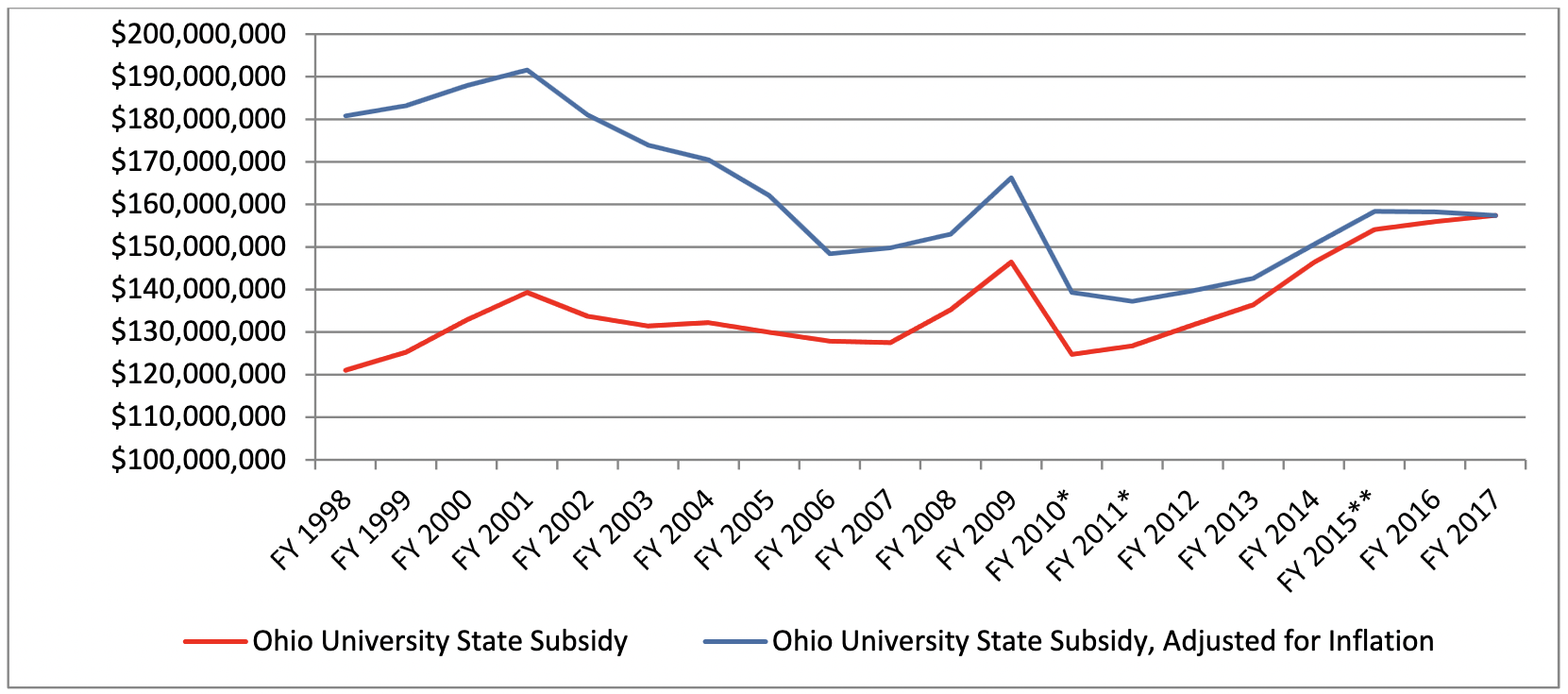
Graph 2. Ohio University State Share of Instruction (Subsidy) in Real and Adjusted Dollars
Increasing costs, along with decreasing SSI per student, have created an additional pressure to enroll and retain students. While enrollments increased to record levels between 2010 and 2016, revenue modeling and capacityanalysis suggests that it would be unreasonable to increase on‐campus enrollments at the rate necessary to meet fiscal needs. Graphs 3 and 4 below present a multi‐year projection of Gross and Net Tuition (net of financial aid), by type of student, using key drivers for financial forecasting based on the enrollment projections outlined in this document. The tuition projections include a combination of the following forecast drivers:
- Academic Activity: Headcount, FTE, or Credit Hours
- Tuition Rates
- Scholarships: Discount Rate, total amount of aid
Each student type has a unique set of forecast drivers. For example, the most appropriate measure of academic activity for tuition modeling of Athens undergraduate students is headcount, as 95% of Athens undergraduates
are full‐time students paying the full‐time tuition rate. For regional campus students, the most appropriate measure of academic activity for tuition modeling is credit hour production, as regional campuses enroll a larger
percentage of part‐time students.
Similarly, each student type also has a unique set of planning assumptions. For example, the historical implementation of state tuition caps differed for undergraduate versus graduate students. Additionally, market pressures for undergraduate eLearning programs create different planning assumptions for tuition rate increases.
The planning assumptions also include projections for New Freshmen, or New Starts. This assumption is a key driver for projecting future years’ enrollments from a budgetary perspective, as are projections of retention rates. It is important to note that these budget planning assumptions will not necessarily align with the enrollment goals and planning outlined in Section 4 of this plan. Rather, these enrollment numbers are used to build conservancy into budget models, in order to adjust for ebbs and flows in enrollment in any given year.
Graph 3. Athens Undergraduate Gross and Net Tuition
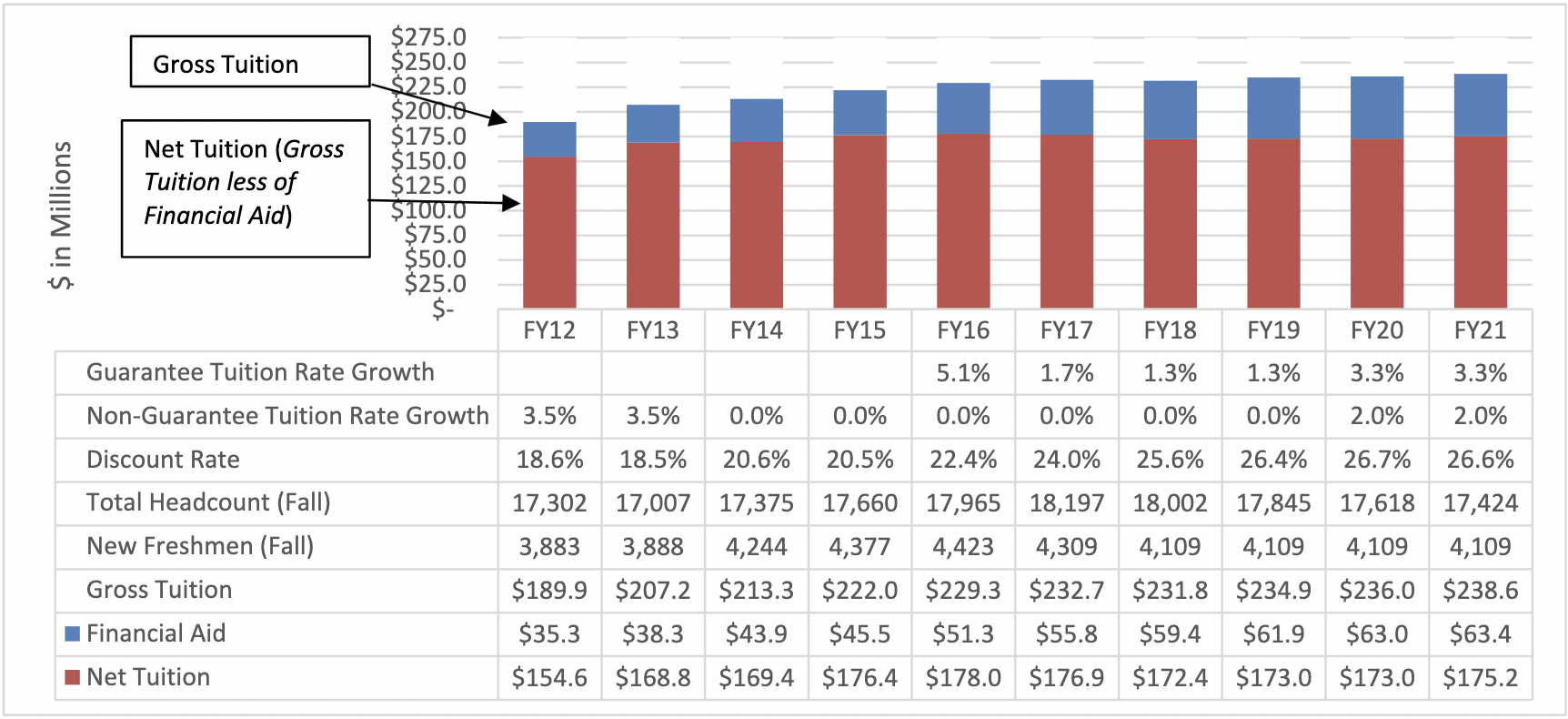
NOTE: Financial Aid and Discount Rate includes all forms of scholarship and grant aid given to students (OHIO Signature Award Program, Student‐Athletic Aid, Grant and Foundation Dollars, College Awards, Tuition Fee Waivers, Graduate Stipends, College Credit Plus Differential, etc.)
Graph 4. Regional Campus Net Tuition
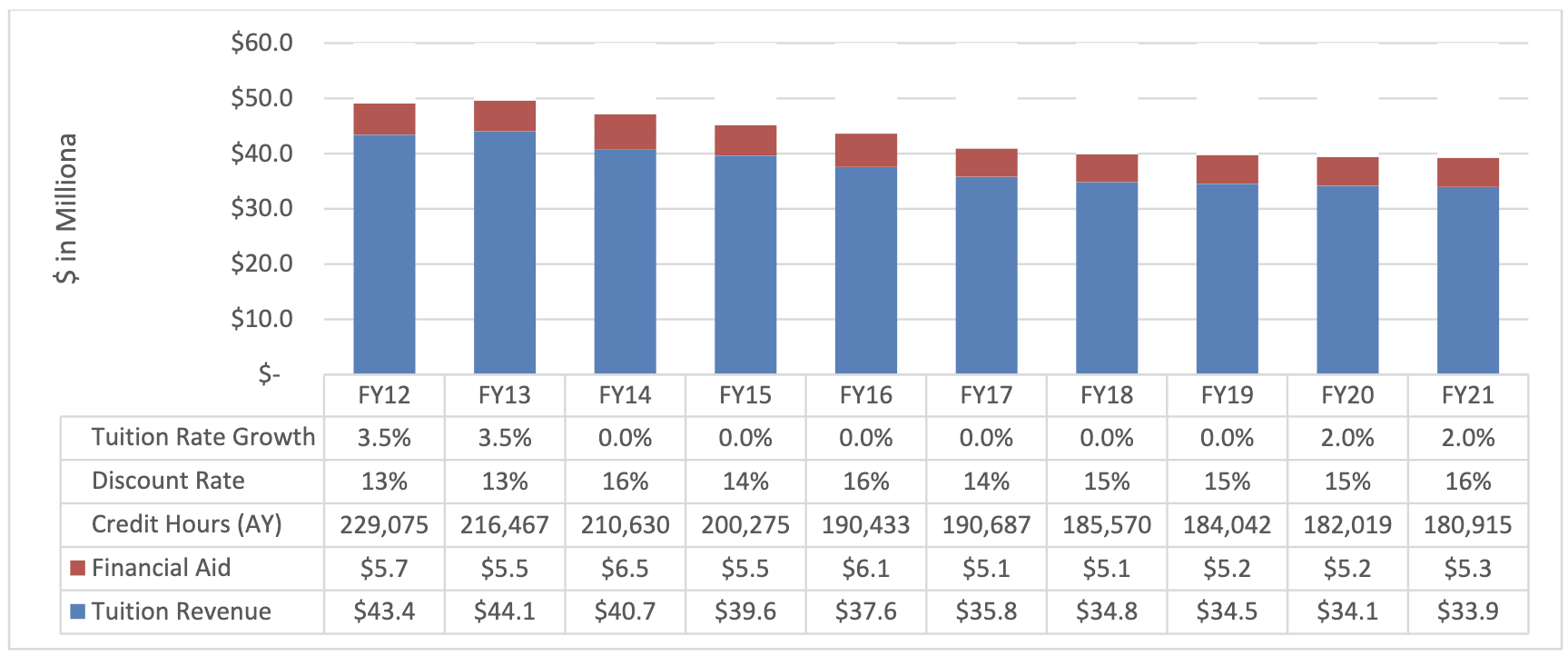
3.2 Future Demographic and High School Senior Projections
OHIO is bracing for changing demographics in the population of high school graduates. As in most other parts of the nation, Ohio’s high‐school‐age population is declining; the high‐school graduation rate in Ohio is expected to
decline by over 12% by 2030 (See Graph 5). Approximately 87% of the undergraduate population and roughly 50% of the graduate population of OHIO’s Athens campus are Ohio residents. This projection creates a series of
recruitment challenges, as all colleges and universities in Ohio—and many institutions beyond Ohio’s borders— will be developing enrollment plans to compete for a smaller pool of students.
Demographics are not destiny, however. While the projected number of high‐school is declining, mere population data do not take into account other college‐choice behaviors, such as how many of those will choose to attend college or what colleges they will ultimately choose.
Graph 5. Past and Projected State of Ohio High School Graduates, 2001‐2031
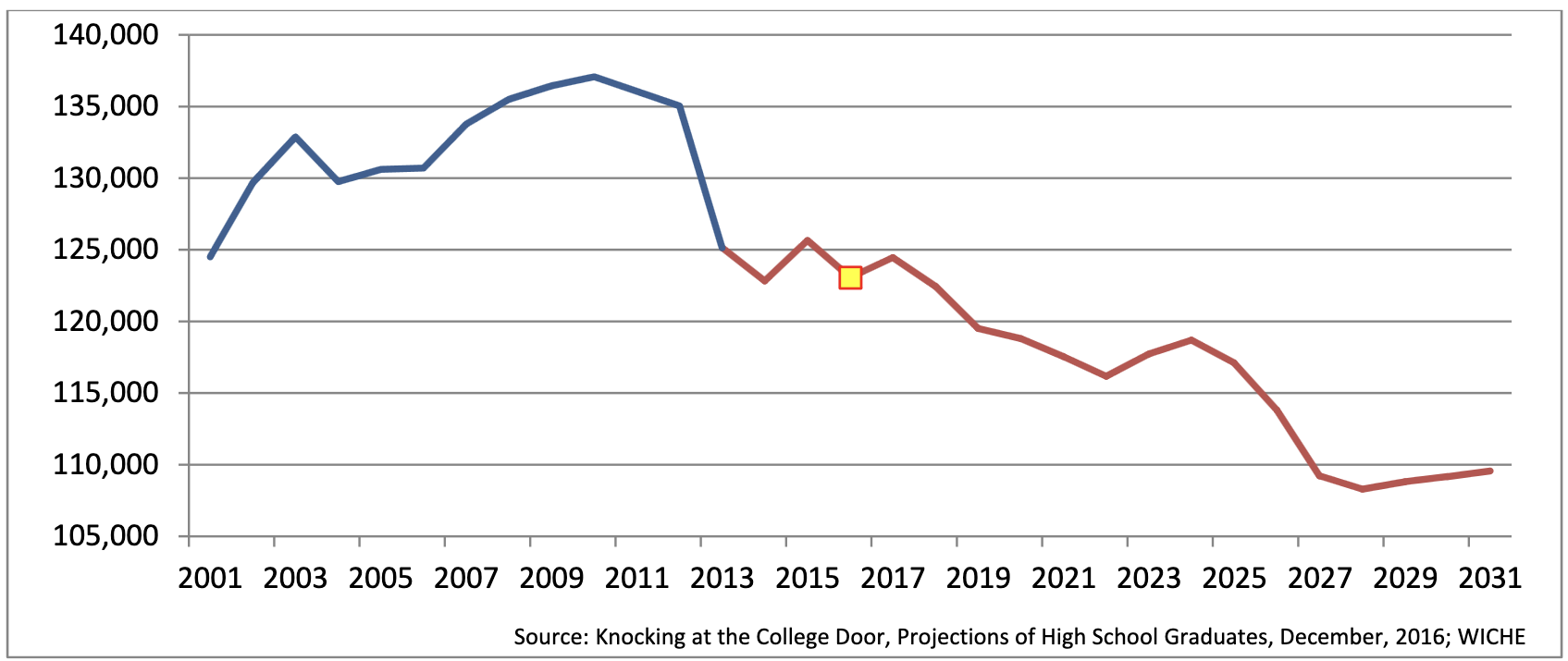
In fact, OHIO has successfully grown its overall in‐state market share over the past several years, running counter to the graduation trend. Graphs 6 and 7 below show the extent to which OHIO has been able to both grow its overall market share of available students and enroll more students per year than the trend in Graph 5 would suggest. Despite this success, however, OHIO cannot become complacent; clearly, competitive pressures, state funding challenges, and student college‐choice behaviors will continue to work against this continued success.
Graph 6. OHIO Percent Market Share of College Going First Time Students Attending Public Institutions in OHIO
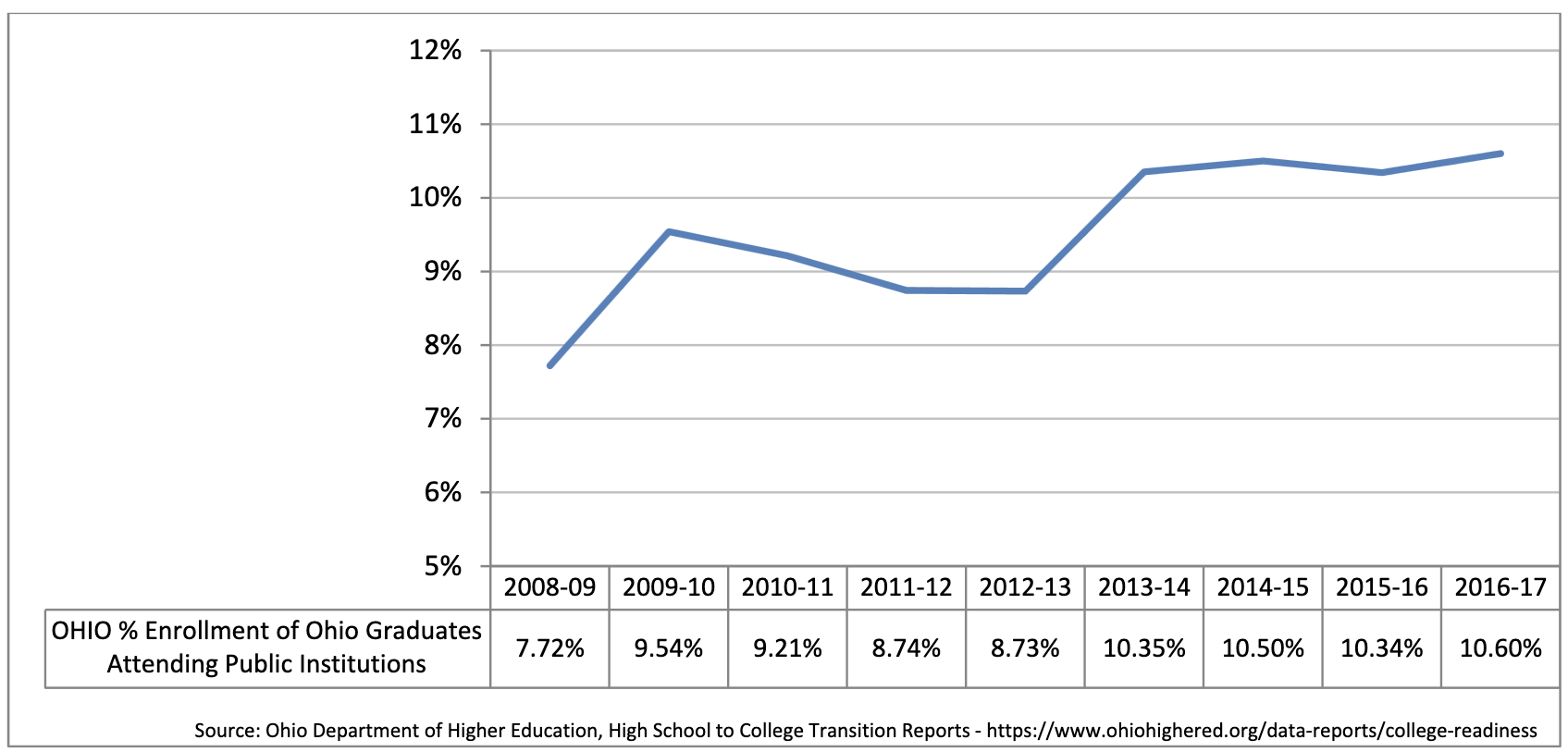
Graph 7. Projected and Actual Number of In‐State Ohio High School Graduating Seniors in OHIO’s Freshman Class, 2008‐2016
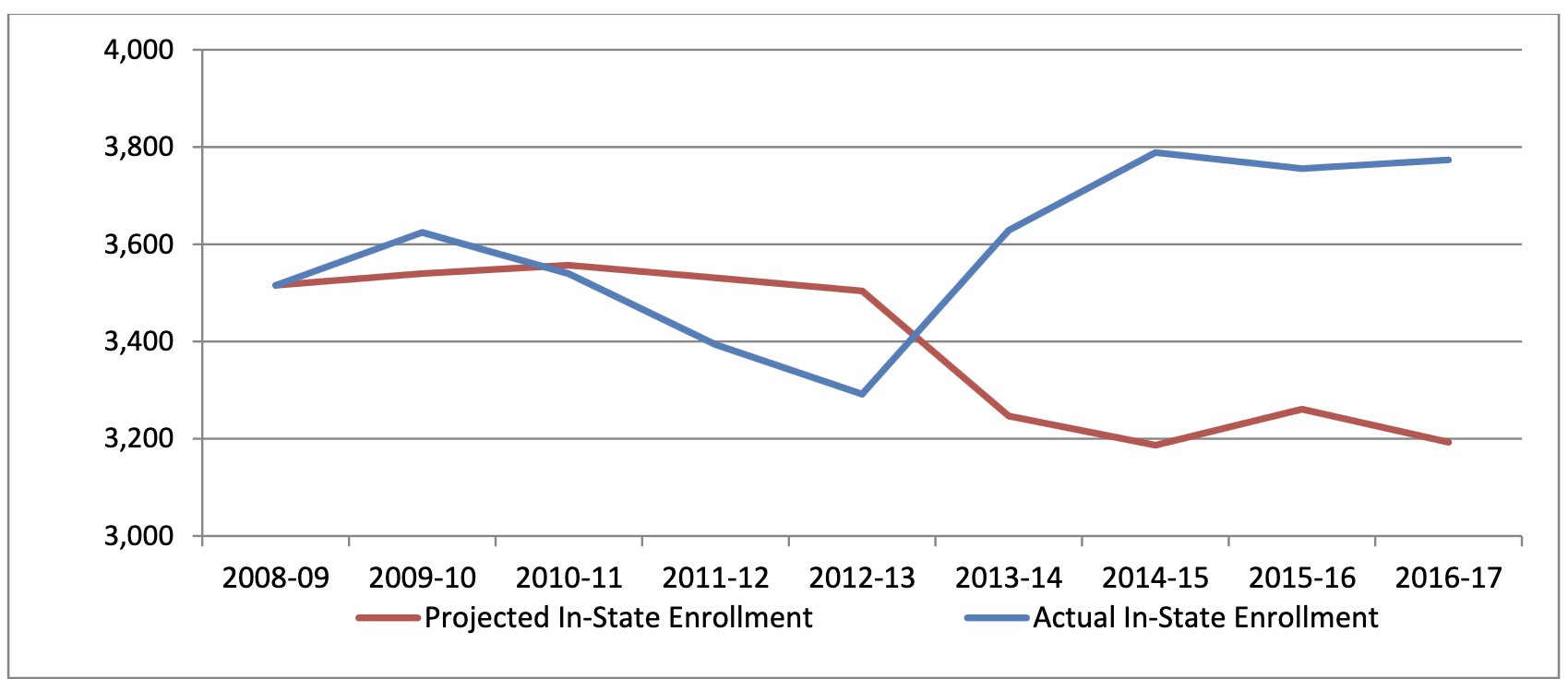
3.3 Competition
While most enrollment metrics begin with the applicant phase of the student lifecycle, there is also a need to be aware of the importance of the prospect and inquiry pools, which have been key to growing OHIO’s applicant pool sufficiently to achieve its recent record enrollments. In fact, today’s senior class prospect pool—nearly 300,000, secured through sources such as testing agencies, lead‐generation services, and anonymous web traffic—is now three times the size of the same pool a decade ago; the inquiry pool (those who have taken some action to demonstrate interest in OHIO), has more than doubled to over 100,000 high‐school seniors.
While such growth is desirable to the extent that it reflects OHIO’s extended reach, the pools now contain a more diverse and diffuse population with a more tentative affiliation to the University, and that diversity makes conversion and yield (the ratio of students admitted to students enrolled) more difficult. Additionally, the increased pool size exposes the University to more significant overlap with both historical and new competitors.
Nationally, students are applying to more colleges 2; the number of first‐time freshmen who applied to more than six institutions was 36.3% in 2015. The number of institutions attended by students who applied to OHIO but ultimately chose to attend elsewhere has grown to more than 120, and the composition of that list has shifted in significant ways (see table 16, page 31) as peer institutions have worked to increase their market share of OHIO’s typical applicant. Therefore, it is necessary to nurture affiliations and create meaningful differentiation in a crowded market in order to convert prospects to inquiries, inquiries to qualified applicants, and admits to enrolled students.
3.4 Reputation, Brand Identity, Marketing Message
Clarifying the University’s brand promise and establishing a more stable market position is an imminent challenge in our efforts to maintain OHIO’s current enrollments as well as to continue targeted growth in our core markets and strategic new growth as we seek to diversify our enrolled student population.
As OHIO’s academic offerings and modalities have diversified, and as academic units have developed college‐specific messaging and identities, the central University brand identity and, to some extent, our value proposition, has become less unified and less clear. The “It’s You” campaign has not been consistently adopted at the University beyond the freshman recruitment marketing and brand‐awareness campaign. Some graphic elements have been adopted by some units, but there is not unity of messaging around the four primary tenets of the campaign.
For the traditional population, OHIO’s entry into The Common Application is bringing applicants with less brand awareness; sophomore and junior high school recruitment efforts, on the other hand, are extending the University’s brand awareness into key markets at earlier ages (and increasing the length of time we have to maintain a marketing relationship with the traditional audience). Today, digital marketing is key to reaching existing and new audiences. Unfortunately, however, digital marketing is expensive and with limited resources requires diffusion of more traditional marketing efforts like radio and television ads, for example. In addition, the OHIO for Ohio initiative raises questions about clarity of brand identity for existing regional campuses and assertion of the OHIO brand in new communities (Beavercreek, Cleveland, etc.)
OHIO’s market position is vulnerable to significant competition from universities that are focusing on more singular assertions of their brand and currently dominate the market. The continued collaborative efforts led byUniversity Communications and Marketing (UCM) to articulate an umbrella brand for OHIO, will therefore be vital in accomplishing the enrollment goals outlined in this plan.
Though there have been significant efforts since 2006 to raise the university’s profile at the local, national, and international levels, it is important to keep in mind that those efforts were the first‐ever marketing/advertising campaigns on that scale in the University’s 206‐year history. OHIO does have a strong reputation from which it can build, and recent campaigns have contributed to brand awareness.
OHIO’s existing reputation in the marketplace, including the brand‐perception information it has, is based on traditionally targeted populations and the Athens campus. However, much of the growth opportunity for OHIO exists among new demographic and geographic populations. OHIO needs to study its market position and brand perceptions among these populations. Some of this intelligence may exist at the program level for certain online programs, but especially in the degree‐completion sphere, it will be important to understand the key drivers and core messages for this audience at the institutional level.
Reputation, especially as it relates to rankings, is a topic of increasing interest and scrutiny in the higher‐education sector. Rankings can be definitively influential in recruiting certain targeted populations, including international students. It is possible that, for some academic units that are trying to break into new geographic/demographic markets, there are many factors, real or perceived, that could present an insurmountable liability to growth.
Marketing is expensive, returns can be slow, and real or perceived competition can drive up costs in OHIO’s anticipated areas of targeted enrollment growth. Over the life of this enrollment plan, the University will need to embrace a university‐wide marketing strategy and an associated investment should be dedicated to achieve success in the multi‐faceted goals outlined in this plan. OHIO will need to determine an appropriate marketing spend‐‐sufficient to compete now for future students—and SEM and UCM will need to collaborate intensively to monitor opportunities for strategic investment, along with opportunity costs associated with lack of presence.
3.5 Price Sensitivity and Student Affordability
The need to effectively address the price sensitivities and affordability concerns of students and their families is a continuing challenge for all of higher education, and in particular public institutions. This issue continues to
receive a great deal of local, state and national attention and is one of the most important issues driving students’ college choices . In fact, in the 2016 a record 15% of new students did not feel that they could attend their first‐choice school due to affordability.
As a result of the 2010‐2016 SEMP, OHIO embarked on a comprehensive pricing analysis and worked with an outside vendor to develop a new scholarship‐leveraging program called the OHIO Signature Awards Program.
OHIO awards approximately $39.6 million per year in undergraduate merit, need‐based and athletic scholarships and grant aid from central resources. This new scholarship program builds upon the success of the former Gateway Award Program, which focused on both student access and success, by adding a differentiated award program that maximizes net tuition revenue (see Graph 3, page 12 above). This additional segmentation allowed for a more student‐centered aid program that is designed to increase student yield (the ratio of students admitted to students enrolled) by using the right amount of aid to address a student’s affordability concerns and increase the probability of enrollment. The Signature Awards Program has proven to grow overall
net‐tuition revenue because although it delivers more aid to students, it also increases enrollments in a strategically balanced manner. However, concerns related to overall discount rate due to increased aid awarding need to be watched within the context of net‐tuition revenue gains.
It will be vital to continually monitor the Signature Awards Program. These analyses should focus on the efficacy of the aid awards, as well as consider how effectively they continue to address affordability concerns. The findings will also help OHIO adjust its strategy in response to competitive pressures. Graph 8 below demonstrates the competitive position of OHIO against its direct peer set in the State of Ohio for average institutional aid awarded for entering student cohorts.
Graph 8. Average Institutional Aid for First Time, Full Time Entering Freshman*5
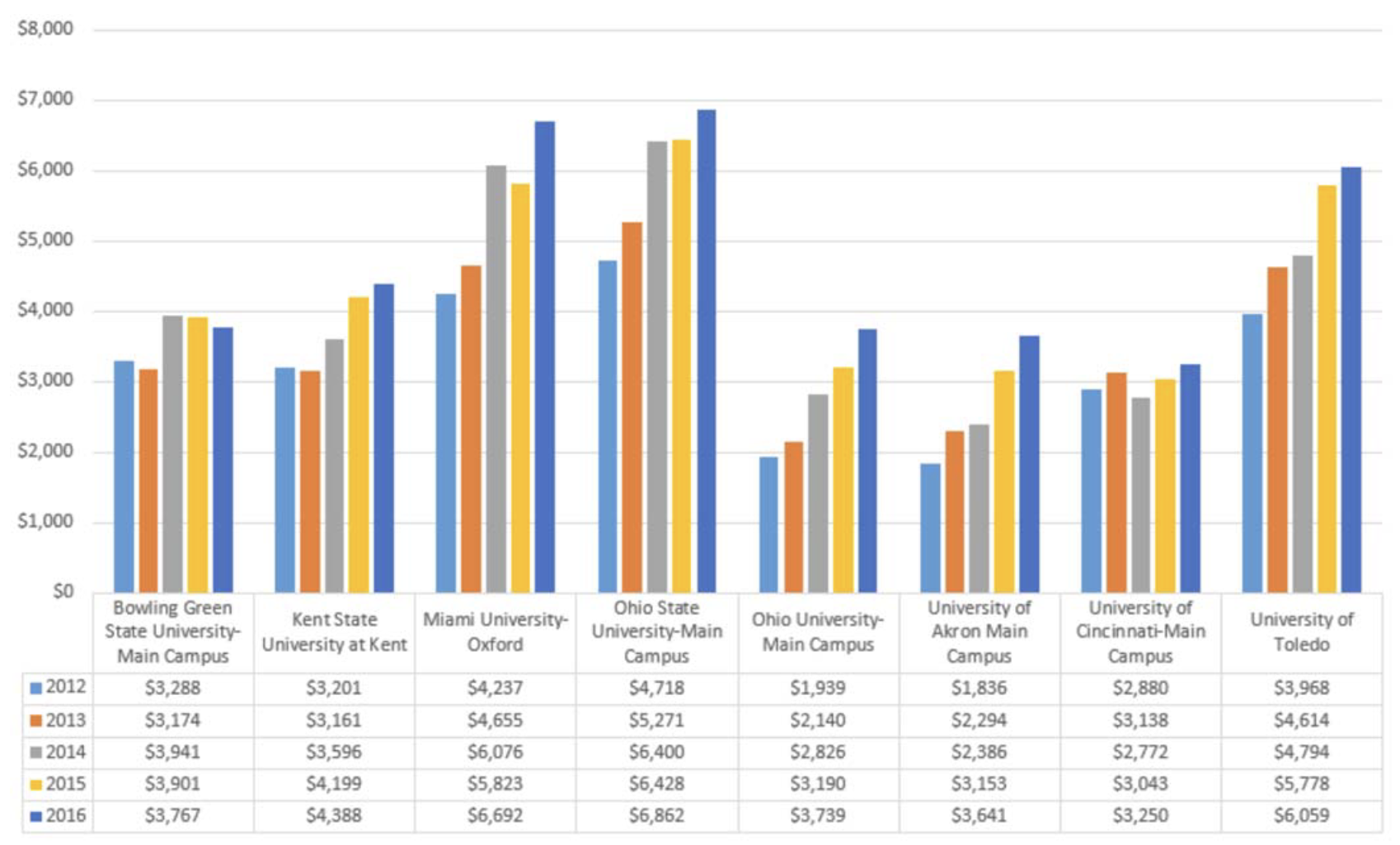
*Average aid per student of all freshman students each year by University
3.6 College Credit Plus (CC+)
The College Credit Plus (CC+) program is the State of Ohio’s mandated dual‐enrollment opportunity for eligible students in grades 7–12. The 2014 legislation establishing the CC+ program required that all public secondaryand postsecondary institutions implement the program by fall semester 2015. The legislation significantly changed the secondary education landscape in Ohio by removing barriers and encouraging more students to earn college credit while concurrently satisfying high‐school graduation requirements.
Approximately 54,000 students across the State of Ohio participated in the CC+ program in 2015–16, a one‐year increase of approximately 22,000 over the number of students who participated in the state’s former program, the Post‐Secondary Enrollment Options Program. Enrollment during the 2015–16 academic year in OHIO’s CC+ program was just under 1,200 students (see Graph 9 below) with approximately 85% of those enrollments at OHIO’s Regional Higher Education (RHE) campuses.
Graph 9. Ohio University Dual Enrollment Historic Headcount Enrollment
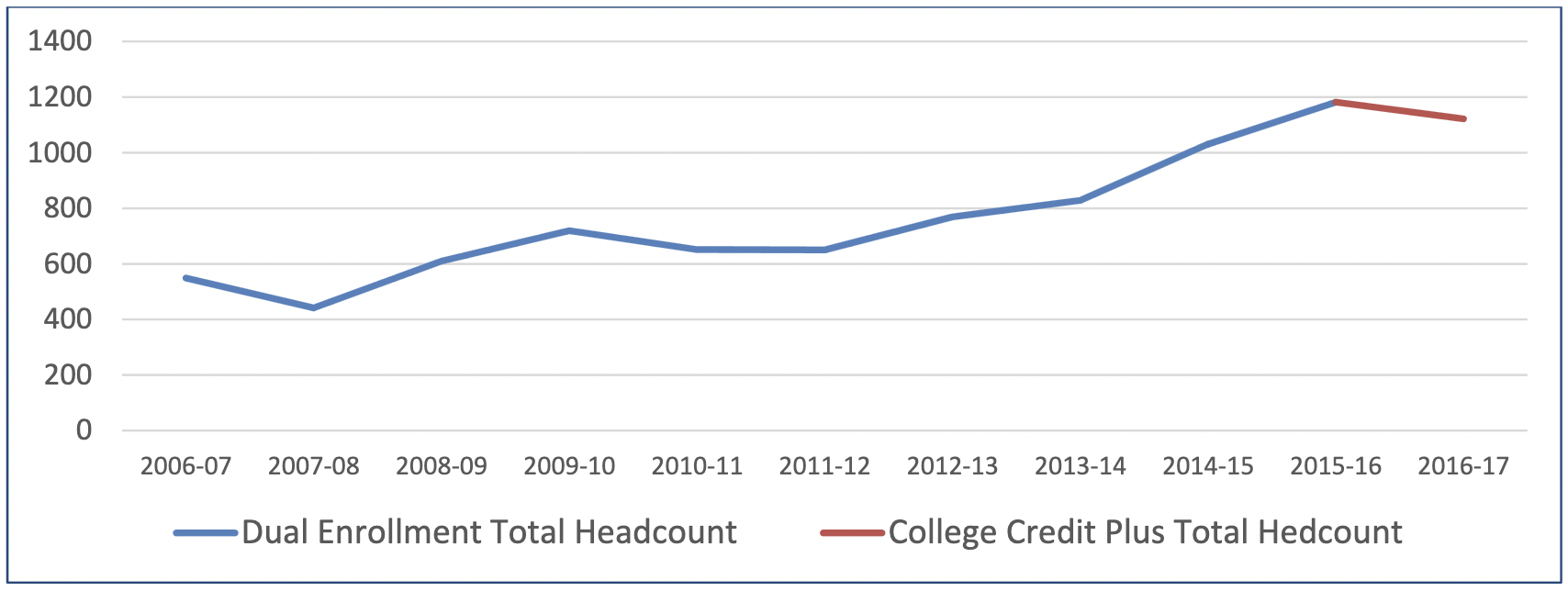
3.6.1 Student Course Enrollments as a Result of CC+
Currently 88% of OHIO’s freshman class is composed of students from the State of Ohio, so it is safe to assume that the number of first‐year students matriculating at OHIO with external credit will continue to increase withthe increased statewide participation in CC+. Based on current enrollment trends, those students, on average, will enroll with between 6 and 21 hours of college coursework. The greatest potential for impact is projected to be in courses associated with the following subject areas: Biological Sciences, Communications, English, Mathematics, Psychology, and Sociology. It will be necessary to closely monitor course‐enrollment trends and prepare for a potential reduction in demand for courses in these subject areas, especially at the introductory levels or those courses that are included in the Ohio Transfer Module (OTM) and the Transfer Assurance Guides (TAGs).
3.6.2 Student Characteristics and Behavior as a Result of CC+
The ability to predict long‐term student behavior in the CC+ program is difficult at this time, because the program is still in its infancy. However, it is likely that, as the number of former CC+ students entering OHIO with course credit increases, OHIO will see the following possible or likely scenarios:
- Students will be able to complete their undergraduate degrees in a shorter period of time and either pursue additional educational opportunities (certificates, second majors, etc.), pursue a graduate degree, or enter the workforce sooner.
- Students will continue to graduate within a typical timeframe but will take advantage of the time freed up in their schedule to either participate in additional co‐curricular and extra‐curricular activities such as study away, internships or co‐op programs, or fulfill requirements for a minor or second major.
- Students will choose to enroll in fewer credit hours per term and will graduate within normal timeframes without adding additional credentials and/or experiences.
-
Students will elect to repeat courses that they had completed while participating in the CC+ program in order to accomplish the following
- Improve the course grade and/or GPA,
- Increase their preparedness and readiness for sequential courses – or‐
- Satisfy prerequisite requirements where a specific grade is required in introductory‐level courses.
One other trend that will need to be monitored will be the diversity of transfer credit brought in by each of the incoming first‐year classes over time. Given the state‐wide rise of CC+, OHIO’s freshmen will enroll in OHIO’s course sequences with an increasing variety of foundational course sources. Because legislated statewide transfer guarantees are based on an assumption of 70% of shared learning outcomes, the increasing diversity of sources of foundational coursework may pose a curricular alignment challenge or, perhaps, a student performance risk, especially in courses that scaffold.
Section 4: Sustaining Ohio's Access and Excellence
While OHIO’s decade of record enrollments should be celebrated, sustaining the system at its current size poses increased challenges. On the strength of tuition revenue, a number of new strategic initiatives targeting infrastructure, student affordability, and program investments were developed to strengthen the University’s mission and presence. However, while this enrollment growth provided significant opportunities, it has also placed strains on the overall system. The significant factors that affect all enrollments are discussed in Section 3. However, many unique challenges and opportunities are present. These range from increased financial aidneeds to the costs of entering new markets to the management of campus capacity limitations; and they affect everything from residential housing to parking to student support to bandwidth to classroom sizes.
Therefore, a key goal of this SEMP is to articulate the balance of strategies and resources necessary to not only sustain current enrollments in the context of the limitations outlined above, but also to build momentum in order to capitalize on new opportunities and facilitate new growth.
There are three fundamental constraints shaping this strategy development:
- The Athens campus is nearing the physical and service limits of its infrastructural capacity to house more students.
- In a number of academic areas, the Athens campus has the capacity to deliver instruction to a modestly increased student body.
- Despite our recent pattern of strong growth and increased market share, the declining population of Ohio high school graduates will necessitate increased costs in the effort to sustain or grow enrollments into the future.
In an effort to bring together these three fundamental realities, the SEMP Advisory Committee examined ways by which measured growth at the Athens Campus could be achieved, while still considering additional larger enrollment opportunities throughout the system. These opportunities include undergraduate and graduate eLearning and outreach modalities, the OHIO for Ohio strategy, and our regional campus system. The tables and comments below represent the enrollment targets that are seen as both strategic and realistic, assuming appropriate ongoing investments, in achieving the goal of sustaining our current Athens success and fulfillingOHIO’s twin missions of access and excellence in our core enrollment areas.
4.1 New Freshman Enrollment Goals at the Athens Campus
As students at the Athens campus generally matriculate through the University in a linear fashion, the overall enrollments are driven by the number of new freshman students entering in any given year. Consequently, meeting overall enrollment goals requires paying close attention to the new freshman enrollment cohort. Table 4 below shows the modestly progressive freshman enrollment goals that have been established for the Athens campus given the current set of assumptions and parameters discussed in this document and anticipated fall 2017 enrollments.
Table 4. New Freshmen Enrollment Goals 2018‐2023 at the Athens Campus
| Enrollment Goals | 2015 | 2016 | 2017 | 2018* | 2019* | 2020* | 2021* | 2022* | 2023* |
|---|---|---|---|---|---|---|---|---|---|
|
In‐State Enrollment
|
3,756 | 3,789 | 3,529 | 3,627 | 3,640 | 3,650 | 3,660 | 3,670 | 3,680 |
|
Out‐of‐State Enrollment
(including international) |
667 | 535 | 516 | 565 | 575 | 585 | 595 | 605 | 620 |
|
Total New Freshmen
Enrollment |
4,423 | 4,309 | 4,045 | 4,192 | 4,215 | 4,235 | 4,255 | 4,275 | 4,300 |
*projected
4.2 New Transfer Enrollment Goals at the Athens Campus
Another key driver for new enrollments is the transfer student enrollment population. Although not seen as “new freshmen,” these students are new to OHIO and on average enter with 39 hours of undergraduate coursework completed. Transfer enrollments are impacted by enrollment trends in the community college system; state‐wide initiatives and commitments to ease the transferability of credit among the state institutions; student and family desires to achieve an affordable undergraduate degree; and the increased mobility, or “swirl,” of students between institutions as they strive to complete their degrees. This population of students represents a key opportunity for growth and fiscal stability, particularly when combined with OHIO’s onlinedegree completion program. Although this number is tracked independently representing physical transfers to OHIO, it is important to consider this in alignment with the larger undergraduate degree completion offerings (Table 11) currently offered and in development that will offer students another OHIO mode of education to pursue that might have otherwise only had the option to physically transfer or pursue their education elsewhere. Table 5 below represents the new transfer enrollment goals established for the Athens campus.
Table 5. New Transfer Enrollment Goals 2018‐2023 at the Athens Campus
| Enrollment Goals | 2015 | 2016 | 2017 | 2018* | 2019* | 2020* | 2021* | 2022* | 2023* |
|---|---|---|---|---|---|---|---|---|---|
|
New Transfer Enrollment
|
563 | 545 | 461 | 475 | 500 | 525 | 575 | 625 | 675 |
*projected
4.3 New Multicultural and Underrepresented Student Enrollment Goals at the Athens Campus
OHIO has seen record growth in multicultural and underrepresented student enrollments over the past decade. The increase in students hailing from Appalachia, as well as students from disproportionately underrepresented
groups, has improved access while also diversifying the campus community and enriching the higher‐education experience for all students. This population tends to be aggressively recruited by all institutions for those reasons. In addition to recruitment goals, the retention and success of these students must remain a University priority. Offices such as the Academic Achievement Center and OMSAR (a division of the Office of Diversity and
Inclusion concentrating on recruitment and retention of underrepresented students) serve thousands of students annually; with this type of activity, enrollment growth even at the most conservative estimates puts an immense pressure on their ability to provide adequate student support. Table 6 below shows the new multicultural student enrollment goals established for the Athens campus.
Table 6. New Ohio University Athens Campus Multicultural Enrollment Goals – Number and (Percent) of entering Freshmen Class
| Enrollment Goal | 2015 | 2016 | 2017 | 2018* | 2019* | 2020* | 2021* | 2022* | 2023* |
|---|---|---|---|---|---|---|---|---|---|
|
New Multicultural
Student Enrollment Goals |
618 (14.0%) |
609 (14.1%) |
535 (13.2%) |
564 (13.7%) |
585 (14.1%) |
596 (14.3%) |
608 (14.5%) |
619 (14.7%) |
635 (15.0%) |
*projected
4.4 New International Student Enrollment Goals
Ohio University’s Vision Statement articulates the desire that our alumni “become global leaders.” One key to achieving this vision is providing global experiences for our domestic students and attracting international students from around the globe. Efforts in this area helped OHIO reach record international student enrollments by fall 2013, but these enrollments have seen a precipitous decline in recent years. Factors in this decline include national policies, greatly increased competition, OHIO’s lack of a global online marketing presence, declines in government‐sponsored enrollments from key countries, and an overall need to re‐adjust the ways that students are recruited to come to American universities. OHIO’s new Global Strategy 2016‐2020 and subsequent recruitment strategic efforts—with an emphasis in the first phase on recovering enrollment from China—have been developed through the combined efforts of the Offices of Global Affairs and Strategic
Enrollment Management and are in the early phases of implementation. This plan is projected to return OHIO to a trajectory of modest growth. Table 7 below shows the new international student enrollment goals established
for the Athens campus.
Table 7. New Ohio University Athens Campus International Freshman Student Enrollment Goals‐ Undergraduate
| Enrollment Goal | 2015 | 2016 | 2017 | 2018* | 2019* | 2020* | 2021* | 2022* | 2023* |
|---|---|---|---|---|---|---|---|---|---|
|
New International
Student Enrollment Goals‐ Undergraduate |
64 | 36 | 28 | 35 | 40 | 45 | 55 | 65 | 75 |
*projected
4.5 Veteran and Military Student Enrollment Goals
OHIO has been designated as a military‐friendly campus for six consecutive years due to the demonstrated commitment to serving our veterans and military students. The Brigadier General James M. Abraham and Colonel Arlene F. Greenfield Veterans and Military Student Services Center was established in 2015 to “support and advocate for veterans and military‐affiliated students in their transition to OHIO and their pursuit of intellectual and personal development.” Veterans and military students enhance the University community by providing leadership and sharing their broad experiences. OHIO values and recognizes their contributions and is committed to supporting them in their academic endeavors. Table 8 below shows the new Veteran and Active‐Duty enrollment goals established for the Athens campus.
Table 8. New Veteran/Active Duty Undergraduate Student Enrollments
| Enrollment Goal | 2015 | 2016 | 2017 | 2018* | 2019* | 2020* | 2021* | 2022* | 2023* |
|---|---|---|---|---|---|---|---|---|---|
|
Veterans / Active Duty Enrollment
Undergraduate Goals |
84 | 80 | 82 | 84 | 86 | 88 | 90 | 92 | 94 |
*projected
4.6 Graduate Student Enrollment Goals
The University has experienced record overall graduate and medical‐student enrollments over the past decade. With the Athens campus’ on‐ground programs fairly stagnant, the largest growth has been in OHIO’s online, hybrid, and outreach programs. In addition, although there has been strong growth in the Heritage College of Osteopathic Medicine due to the opening of both the Dublin and Cleveland locations, enrollments are now at their planned maximums for the next few years and are not projected to grow significantly over the timeframe of this SEMP. There is a key desire, however, to attempt to grow all aspects of the other identified graduate enrollment groups; this will be discussed further in Section 6.
Table 9 below shows the enrollment goals for graduate programs based upon capacity analysis and conversations across campuses. Of particular note is the balance of supported to full‐paying graduate students related to the opportunities for growth. Supported graduate students often provide instructional capacity to undergraduate students or research support for faculty, service that ultimately offsets the cost of their stipend. It is assumed that to significantly increase graduate enrollment at the Athens campus, additional support in the form of assistantships and stipends is necessary. Achieving an effective balance on the scale from fully supported to full‐fee‐paying students, which will require concentrating on high‐demand academic programs with capacity for new students, will be necessary if the University is to meet the goal of both maximum enrollments and enhanced revenue generation for the Athens campus.
OHIO has seen significant growth in online, hybrid and outreach enrollments and is in the process of conceptualizing additional strategies to further grow these populations.
Table 9. Overall Graduate Enrollment Goals 2018‐2023 (On‐Campus and On‐line)
| Graduate Enrollment | 2015 | 2016 | 2017 | 2018* | 2019* | 2020* | 2021* | 2022* | 2023* |
|---|---|---|---|---|---|---|---|---|---|
|
Graduate‐ Athens
|
2,601 | 2,584 | 2,561 | 2,590 | 2,590 | 2,590 | 2,590 | 2,590 | 2,590 |
|
Graduate– Dublin
|
39 | 100 | 134 | 150 | 165 | 180 | 195 | 205 | 220 |
|
Graduate‐ Outreach
|
419 | 397 | 462 | 462 | 462 | 462 | 462 | 462 | 462 |
|
Graduate– Online
|
1,965 | 2,105 | 2,288 | 2,332 | 2,376 | 2,420 | 2,464 | 2,508 | 2,552 |
|
Total Graduate (does
not include Medical) |
5,024 | 5,186 | 5,445 | 5,534 | 5,593 | 5,652 | 5,711 | 5,765 | 5,824 |
|
Medical (all campuses
combined) |
711 | 810 | 922 | 980 | 1,007 | 1,023 | 1,030 | 1,036 | 1,036 |
*projected
4.7 Regional Higher Education (RHE) Enrollment Goals
Regional campus enrollments across the state and nation have been in decline since 2010 6 when the economic recovery began. During that time, enrollments also have shifted toward more traditional‐aged, part‐time, andonline students seeking baccalaureate degrees. OHIO’s RHE experienced a 1% drop in headcount and a 5% drop in full‐time enrollments from fall 2015 to fall 2016. This trend is projected to continue through 2022 and likely will be exacerbated by smaller high‐school graduating classes, the impact of CC+, and increases in transferred credits. To counter these negative enrollment drivers, the regional campuses will need to focus on improving retention, building transfer partnerships, enhancing student relocate services, developing applied undergraduate and graduate degree opportunities for in‐demand jobs, and increasing outreach through online programming. Table 10 below shows the overall enrollment goals established for RHE.
Table 10. Overall Regional Higher Education Goals 2018‐2023 (All Campuses Combined; Unduplicated Count)
| Enrollment | 2015 | 2016 | 2017 | 2018* | 2019* | 2020* | 2021* | 2022* | 2023* |
|---|---|---|---|---|---|---|---|---|---|
|
All Regional Campus
Enrollment (RHE) |
7,332 | 6,851 | 6,507 | 6,679 | 6,851 | 6,900 | 7,100 | 7,200 | 7,200 |
*projected
4.8 eLearning Enrollment Goals – Undergraduate Bachelor Degree Completion Programs
OHIO has seen significant growth in its online bachelor‐degree‐completion enrollments, which have increased by more than 618% since 2008. However, these enrollments were largely due to expansion of the RN‐to‐BSN degree completion program and peaked at approximately 6,100 students in 2014. The success of the RN‐to‐BSN program was precipitated by a major market force: changes in hospital accreditation guidelines to incentivize BSN‐certified nursing staff. Significantly increased competition, near‐satisfaction of the forced market demand in Ohio, and the balance of the need and desire to become a more national program will continue to impact OHIO’s ability to maintain such a large student population in one program. Reaching the RN‐to‐BSN enrollment peak made it clear that OHIO needs to diversify its online degree completion enrollment to sustain this modalityof educational opportunity.
Starting in the 2016‐17 academic year, several changes were made, specifically in the Divisions of Instructional Innovation, Strategic Enrollment Management, and Information Technology. Each area received central investment dollars to more effectively build capacity and improve professional quality in the conception, development, creation, and marketing of new online degree completion programs. It is anticipated that this process will take up to three years to reach maturity but will allow OHIO to reach a steady base of enrollments with existing programs and rapidly develop and market new programs. Table 11 below shows the new undergraduate eLearning enrollment goals for the eight degree‐completion programs that are enrolling students at the time of this report. (See Appendix A for a list of these programs.)
Table 11. eLearning Enrollment Goals‐ Bachelor Completion Programs 2018‐2023
| Enrollment | 2015 | 2016 | 2017 | 2018* | 2019* | 2020* | 2021* | 2022* | 2023* |
|---|---|---|---|---|---|---|---|---|---|
|
Total Undergraduate
eLearning Enrollments |
6,015 | 6,032 | 6,200 | 6,751 | 7,286 | 7,500 | 7,500 | 7,500 | 7,500 |
*projected; as eLearning enrollments have multiple starts, 2017 will remain projected until final counts
4.9 Retention Goals at the Athens Campus
As discussed in section 2.2, the freshman‐to‐sophomore return rate, or retention rate, is a primary marker of student success and one that is carefully tracked by institutions as well as state and national agencies. Many factors impact a student’s ability to fully matriculate throughout a college career; carefully constructed support, advising, and intervention techniques are necessary to determine students at risk of not returning term to term or year to year. Table 12 below shows the planned freshman‐to‐sophomore retention goals for 2017‐2023. In addition, it will be necessary to begin to develop and track additional student retention goals for sophomore‐to‐junior and junior‐to‐senior years as students progress toward completion.
Effective implementation of the initiatives described below will help OHIO not only achieve these retention goals but also aid in the continued recruitment of strong, qualified classes:
- MyOhioSuccessNetwork (MOSN) is a system designed to facilitate strategic interventions for students who are at risk of failing classes or have other kinds of issues that may signal a possible failure to complete. This is the first year of MOSN, so its sample size is too small to assess its impact at this point. However, OHIO expects this important initiative to support and improve completion rates.
- The Student Success Advisor (SSA) initiative consists of a total of seven advisors connected to Colleges throughout the University. SSAs work closely with their respective college student services team and the Allen Student Advising Center staff to track first‐year student progress and tailor context‐specific success strategies—including student advising and curriculum adjustments—supporting retention.
- First Generation Student Programs – Because approximately 25% of first year freshmen at OHIO self‐identify as first‐generation students, a First Generation Student Program was initiated in fall 2015. The early outcomes from this program indicate success in retaining this group of students. First‐year retention rose from 73% prior to the initiative to 77% with this initiative in place. Much of the institution’s recent growth in overall retention between 2015 and 2016 is attributed to the increase within this population, which bodes well for continued overall high retention rates.
Table 12 below represents the new student retention goals that have been established at the Athens campus for Ohio University.
Table 12. Retention Goals 2018‐2023 at the Athens Campus
| Retention Rate | 2015 | 2016 | 2017 | 2018* | 2019* | 2020* | 2021* | 2022* | 2023* |
|---|---|---|---|---|---|---|---|---|---|
|
Freshmen to Sophomore
|
79.1% | 81.5% | 79.9% | 81.5% | 82.0% | 82.5% | 82.5% | 83.0% | 83.0% |
*projected
4.10 Student Academic Quality Goals at the Athens Campus
As a result of careful outreach, student selection and overall recruiting, the academic quality indicators at OHIO’s Athens campus have grown steadily and reached new milestones over the last SEMP (see Table 3, page 9). As a part of its twofold mission of access and excellence, OHIO will continue to seek a careful balance between admitting students who help grow the overall academic quality profile while also admitting students in accordance with OHIO’s access mission. Modest growth in quality can be accomplished through careful outreach, marketing, communication, and financial aid leveraging efforts, as OHIO has found over the past SEMP. Table 13 below represents the new student quality indicators established for the Athens campus .
Table 13. Student Academic Quality Indicators 2018‐2023 at the Athens Campus
| Average Quality Indicators | 2015 | 2016 | 2017 | 2018* | 2019* | 2020* | 2021* | 2022* | 2023* |
|---|---|---|---|---|---|---|---|---|---|
|
High School GPA
|
3.46 | 3.48 | 3.54 | 3.55 | 3.55 | 3.56 | 3.56 | 3.57 | 3.57 |
|
Composite ACT
|
24.1 | 24.0 | 24.1 | 24.1 | 24.2 | 24.2 | 24.3 | 24.3 | 24.4 |
*projected
4.11 Overall System Enrollment Goals
The Office of Institutional Research has developed a model by which the above goals are used to project the enrollments for the Athens Campus, RHE, eLearning, and overall enrollments through the use of historical averages. This model also informs the overall budget planning efforts related to multi‐year revenue assumptions. It is important to note that these are enrollment planning goals and are at risk to hold steadfast when used for long‐term revenue forecasting due to the fluid nature of enrollment planning. This model, shown in Table 14, will be updated and evaluated annually as part of the ongoing enrollment planning efforts at OHIO and is presented as unduplicated numbers (i.e., each student is counted at only their primary campus and onlyonce, even if classes were taken at multiple campuses or multiple modalities in the same term). Table 14 below shows the new overall enrollment goals established for OHIO.
Table 14. Enrollment Goal Projections 2018‐2023 – Ohio University (unduplicated counts by row)
| Total | 2015 | 2016 | 2017- Fall Census | 2018* | 2019* | 2020* | 2021* | 2022* | 2023* |
|---|---|---|---|---|---|---|---|---|---|
|
Total Athens
Undergraduates |
17,789 | 17,983 | 17,692 | 17,772 | 17,613 | 17,605 | 17,714 | 17,730 | 17,745 |
|
Total Graduate Students
(Athens, Online, Outreach, Dublin) |
5,024 | 5,186 | 5,296 | 5,534 | 5,593 | 5,652 | 5,711 | 5,765 | 5,824 |
|
Osteopathic Medicine
(includes Dublin and Cleveland Campuses) |
712 | 815 | 924 | 980 | 1,007 | 1,023 | 1,030 | 1,036 | 1,036 |
|
Total Regional Campuses
|
7,332 | 6,851 | 6,483 | 6,679 | 6,851 | 6,900 | 7,100 | 7,200 | 7,200 |
|
Total Undergraduate
eLearning |
6,015 | 6,032 | 5,628 | 6,751 | 7,286 | 7,500 | 7,600 | 7,700 | 7,800 |
|
Total Ohio University
Enrollment |
36,872 | 36,867 | 36,023 | 37,716 | 38,350 | 38,680 | 39,155 | 39,431 | 39,605 |
*projected
Section 5: Opportunities for Enrollment Growth to Leverage Success
Another key goal of this planning process is to identify ways for OHIO to leverage its opportunities for success in the rapidly changing landscape of higher education. National conversations around the future of higher education 7 largely concur that over the next several years, prospective students increasingly will seek flexibility; they will want choices in university, campus, academic program, modality, level of credential, timing of educational pursuit, and duration of study. Although great efforts have been developed to reach these new markets and offer new types of student learning options, challenges remain as OHIO expands from its more traditional models and adapts to the changing marketplace amid significantly growing competition.
5.1 New Program Development – eLearning and Hybrid Educational Modalities
The challenges outlined throughout this plan necessitate a fundamentally new paradigm to reframe the relationship between students and the University. The traditional student path for a residential campus with relatively unchanged modes of academic program delivery, standard curriculum sequence, number of credit hours, and in‐class seat time required will be pushed against as students seek other options due to personal preference or affordability. In addition, students and their current and future employers will continue todemand skill enhancements, continuing education, and credentials outside of traditional degrees for promotion and career advancement. Today, approximately 80% of the market for U. S. higher education is serving the non‐traditional, part‐time, adult population 8.
To be able to compete and grow enrollments as the market continues to change, OHIO must continue to develop programs in a variety of new ways. For example, some concepts that are already being discussed or developed include:
- Microprogramming (very short‐term continuing education workshops, stackable certificate programs of weeks or months duration, etc.) with lifecycles adapted to the pace of workforce changes.
- Credentialing, whether for traditional degrees, certificates, CEUs, or new forms of credentialing, is an opportunity that will advance relationships with an OHIO community of lifelong learners.
- Teaching in new places (not just the OHIO campuses, but in businesses, community centers, partner institutions).
- 3+2 BA/MA, 2+2, 4+1, and other combined degree models.
OHIO will need to reframe how it thinks about retention to go beyond a successful four‐ or five‐year horizon—to move lifelong relationship management in a learning partnership to the heart of its educational mission. The goal is to treat enrollment as an initial step in a learning partnership, one in which opportunities to reconnect for more learning continue over a lifespan.
5.2 OHIO for Ohio
The OHIO for Ohio strategy will inform the growth and development of all of the University’s in‐state enrollment opportunities. As articulated in the OHIO for Ohio Executive Summary ,
OHIO for Ohio
1.0 at its core is a board adopted multi-dimensional strategy based on a set of long-held values related to the University’s historical tripartite mission of teaching, research and service in order to respond to the current set of challenges confronting public higher education in Ohio and across the nation. The strategy, building on the recent success in Dublin and Cleveland, seeks to incorporate OHIO’s rich history of community engagement and the active integration of academic programming, community-based teaching and research with student experiential learning in order to promote greater pedagogical and social impacts. The strategy is evolutionary and built on the premise that the University in the 21st century must be nimble in order to adapt to an uncertain future and flexible so it can provide the programs and services future generations of OHIO students, the state and its business
community will require.
Essentially, OHIO for Ohio
will expand OHIO’s reach further and more deeply into areas not traditionally conceived as its “backyard.” Consequently, the University’s brand identity and marketing efforts may evolve, facing both opportunities and challenges in defining OHIO to existing and new populations. The OHIO for Ohio effort will create more opportunities to grow in enrollment and impact as OHIO expands to a more comprehensive statewide footprint. As with all specific strategies that are developed, the need to coordinate these efforts with the strategic enrollment management function of the University will be vital to their success and longevity.
5.3 Regional Higher Education (RHE) Opportunities
Graduate programming on regional campuses remains an underutilized opportunity. As academic units continue to consider expanded development of online graduate degree programs, they should not overlook the opportunities to offer cohort‐based graduate programming at OHIO’s regional campuses. In many cases RHE faculty can support program recruitment and instruction, using enrollment pipelines within each regional campus community to tap into expanding alumni networks. The success of ongoing collaborations with theCollege of Arts & Sciences, the Patton College of Education, and the Scripps College of Communication suggest that RHE pursue additional opportunities. It will be necessary to effectively coordinate these efforts both centrally and among the colleges and departments.
5.4 eLearning Redesign Task Force
The development of this plan coincides with a university‐wide exploration of the optimal governance structure for OHIO’s online course and program offerings. Many online offerings have arisen organically in a variety of units to meet student demand and program goals. As they have increased and diversified, however, the lack of central coordination between “eCampus” and campus‐based online course offerings has in some cases resulted in redundant courses with sub‐optimal enrollments, fostering a degraded student experience. Current arrangements mask inefficiencies and artificially limit access to lower‐cost courses. Given the paradigm shift toward blended and online instruction, even for campus‐based students, the University is considering whether it is possible to create a single online course location—effectively, a single online “campus.” A guiding principle of this model would be that any student at OHIO would be able to enroll in any course, subject to requisites and other appropriate academic policies. The planning process is ongoing and is raising significant questions regarding institutional capacity and academic processes, support and student services, and structures forpricing, billing, and data. For the purpose of this enrollment‐management plan, it is important to note that the answers to those questions—if the redesign is implemented—could impact enrollment projections and assumptions around revenue allocations for various categories of students.
Section 6: Key Enrollment Strategies, Barriers, and Opportunities to Meet Enrollment Goals
In developing this plan, the sub‐committees were asked to carefully evaluate not only internal and external challenges but also opportunities. This section is designed to delineate some of the key issues that will factor into meeting the enrollment goals outlined in this document.
6.1 Central University Commitment and Support
The record enrollments achieved under the last SEMP occurred under a traditional budget model that, in many ways, allowed for a more University‐wide conversation related to overall enrollments and centrally controlledinvestments in initiatives. The current decentralized budgeting model incents and allows for individual colleges to invest in enrollment opportunities for their specific needs, but it also creates disincentives to a coordinated enrollment support strategy.
National and institutional research suggests that students choose a university not only for a particular college or academic program, but also for myriad other reasons that are not necessarily directly tied to one college or program. It will be important for OHIO to continue to support central strategic enrollment management efforts to maintain its core, while at the same time developing college or program‐specific efforts to effectively and strategically grow.
Several key conditions must be met to improve the likelihood of achieving the enrollment planning targets outlined in this document. These include:
- Key stakeholder buy‐in and support‐ The yearlong, full‐campus engagement approach was specifically designed to allow for the vetting of ideas necessary to develop a comprehensive enrollment planning process and overall enrollment goals that would be embraced by the entire university community. This inclusive approach has created a base of understanding and support from which OHIO can move forward decisively to implementation.
- Fiscal support‐ Key university stakeholders need to anticipate, embrace, and support this Strategic Enrollment Management Plan and continue to provide adequate base and investment funding to meet the desired goals with consideration to through a model that takes into consideration productivity, efficiencies, key performance indicators, market conditions, competition, and return on investments. This strategic planning process, which has received strong support from the University community, has
already demonstrated that success can occur by tying fiscal support to university priorities. - Enrollment growth and bottom‐line impact‐ It must be understood by all that additional tuition dollars accrued through enrollment growth do not necessarily yield an equal “bottom‐of‐the‐ledger” revenue enhancement for the University. Due to the way revenue flows in a decentralized budgeting system and the costs associated with new program development, revenue growth will need to be balanced against the cost and efforts to both develop, and teach those new students in a return on investment approach. Varying pricing structures, scholarship discounting, and additional support ranging from housing to teaching will also affect to differing degrees the final revenue gained after expenses. This also means that not all programs may be worth pursuing even if there is a small market to grow enrollments.
6.2 State Initiatives Affecting Enrollment
Since the 2010‐2016 Ohio University Strategic Enrollment Management Plan, the State of Ohio has increasingly focused on developing and funding initiatives that target completion, affordability, and efficiency. While these
initiatives generally aim to support students and their educational aspirations, they also directly and indirectly affect institutional enrollment and enrollment planning. What remains unknown is the true impact that state transfer credit mobility initiatives will have on the University’s population, as more students continue to enroll with increasing numbers of hours earned outside of the institution. Additionally, these state efforts call to question the level of autonomy institutions will continue to have in developing program or degree
requirements.
Though not exhaustive of the current or future state initiatives, the following represents those areas that should be considered and analyzed closely: guided pathways, statewide partnerships, affordability and efficiencyexpectations, and state credit programs (i.e. competency‐based education, prior learning assessment, CC+, and expanding transfer credit efforts). OHIO will continue to embrace and implement statewide efforts that provide a pathway to enrollment and completion, while simultaneously monitoring how these initiatives align with accreditation requirements, influence institutional operations, and impact enrollment.
6.3 Regional Higher Education‐ Overall Challenges to RHE
OHIO’s regional campus system continues to be best suited to meet the educational needs of the communities they serve through affordable, accessible, and top quality programming. RHE remains committed to
strengthening community partnerships, increasing cross‐campus collaboration, and expanding program opportunities and support services for students. However, despite efforts to focus on strategic and efficient
operations, current and anticipated shifting demographics, changing economic landscapes, and increasing competition suggest future RHE enrollment planning needs to be considered cautiously.
Statewide efforts such as community college baccalaureate options, CC+, and competency‐based education partnerships will directly impact the enrollment levels of degree‐seeking students at regional campuses. These issues will alter the approach to orientation, scheduling, hiring, advising, retention, and budgetary planning. Institutional efforts to increase online baccalaureate completion degrees, while expanding student options, have the potential to result in a bifurcation of student enrollment and an unsustainable redistribution of faculty resources. To meet the challenges of these and other changes at the state and institutional levels, RHE will need to partner internally with academic and administrative units and externally with community colleges and community organizations to further identify, develop, and monitor sustainable enrollment pipelines.
6.4 Competitive Pressures on Enrollment
As OHIO strives to facilitate more flexible, relevant, and diverse programmatic offerings, in addition to expanding its geographic reach domestically and abroad, the University necessarily faces increased and more varied competition. As each competitor strives to assess and alter their market position, OHIO must adapt and adjust to compensate.
Within the state, OHIO is vulnerable to competition from multiple directions. On measures of academic quality—standardized test scores, GPAs, rigorous academic profiles—the University competes against a generally consistent body of peer institutions: University of Cincinnati, The Ohio State University, and Miami University. On measures of access—Pell‐eligible students, need‐based financial awards, first‐generation population services—the University competes with a different group of institutions: Kent State University,Bowling Green State University, and the University of Akron. Table 16 below shows institutions attended by OHIO’s admitted non‐attending class over recent years.
Table 16. OHIO’s Top Cross Application Institutions and Rank of Where the Students Attend
| Rank | 2008 | 2009 | 2010 | 2011 | 2012 | 2013 | 2014 | 2015 | 2016 |
|---|---|---|---|---|---|---|---|---|---|
|
1st
|
OSU | Miami | OSU | OSU | OSU | OSU | OSU | OSU | UC |
|
2nd
|
Miami | OSU | Miami | Miami | UC | UC | UC | UC | OSU |
|
3rd
|
UC | UC | UC | UC | Miami | Miami | Miami | KSU | KSU |
|
4th
|
KSU | KSU | KSU | KSU | KSU | KSU | KSU | Miami | Miami |
|
5th
|
UD | BGSU | BGSU | BGSU | BGSU | BGSU | BGSU | BGSU | BGSU |
It is important to note that the type of institution with which OHIO is competing has changed significantly, as evidenced by the relatively high overlap positions of The Ohio State University—Newark, and Columbus StateCommunity Colleges that are not in the top 5 competitor set in Table 16, but are starting to rise in this dataset. The value proposition of a regional campus or community college is different from the claims attested by a comprehensive public research university, and this diversity of messaging impacts the way in which OHIO must position itself in market, as well.
6.5 Efficacy of the OHIO Guarantee
In fall 2015 OHIO welcomed its first cohort of freshman students under the OHIO Guarantee, a precedent‐setting program designed to provide more transparency and financial predictability to students and parents, maintain the relative value of financial aid, and offer an incentive for students to earn a degree in four years.
The OHIO Guarantee sets tuition and fee costs for each entering cohort of degree‐seeking undergraduate students on the Athens campus. Total costs will remain the same throughout these students’ four years — or 12 consecutive semesters — of enrollment. A guaranteed tuition model is not a new concept in higher education, but OHIO's plan is unique in its scope; it includes flat rates for multiple housing and dining options and most academic course and technology fees, in addition to tuition. This predictability helps families budget for all college costs. It also ensures that scholarships and financial aid packages hold their value; because the cost of attending OHIO will remain flat, the same percentage of these costs will be met by any renewable scholarship, assuming that scholarship criteria are maintained.
However, although OHIO believes the program is a great opportunity and will ultimately benefit enrollments, student retention, and ultimately graduation rates, all aspects of the OHIO Guarantee must be continually analyzed to ensure its continued efficacy and viability. As the first Guarantee cohort prepares to graduate and new cohorts apply, OHIO will need to assess the program’s impact on college choice behaviors and seek opportunities to expand it to populations not currently covered by its benefits, including students on regional campuses, in graduate programs, and part‐time students.
Because OHIO’s program was the first in the State of Ohio and one of a kind nationally, it was in itself precedent‐setting at the time of its inception; it was not subject to differentiated value propositions of other guarantee programs. Now, other institutions are beginning to create guaranteed tuition programs in response to State legislation impacting those institutions’ costs. Other guarantee programs may emulate some of the benefits of OHIO’s programs, but OHIO expects that competition may still occur on net cost, and prospective students may not understand the nuances that impact their bottom line—for example, that OHIO provides more transparency by including program and course fees. As this space becomes more crowded, OHIO will need to articulate and promote the distinctive features of its pricing plan, monitor whether The OHIO Guarantee aligns with what the market expects to find in such a program, and determine whether adjustments are needed to remain competitive.
6.6 Innovation and Systems Impact for Enrollment across Campuses
Students come to higher education with expectations that a fully‐integrated and seamless technological campus systems are available to them. Students expect OHIO not only to support these technologies but also embrace and leverage them. This expectation will become a major factor in the selection of educational institutions. Innovations in technology continue to accelerate in both scope and pace. Increasing investment and competition in the educational technology industry, and a demographically challenging population will compel OHIO to consider the best approach to take. The combined efforts of the Offices of Innovation, Strategic Enrollment Management and Instructional Technology must lead the effort in aligning these emerging dynamics against OHIO’s existing structures.
6.7 Investments and Experimentation
The effective use of a University investment program to provide seed funding to invest in high‐ potential, revenue‐generating programs has proven to be the right strategy and should continue. One key element of this strategy has been the creation of the Central Investment Pool to fund experimental programming initiatives.
Over the past year alone this fund has been integral in bridging and supporting costs associated with the OHIO Signature Award Program, eLearning marketing, and international recruitment efforts, to name a few.
Over the past several years it has become increasingly apparent that OHIO must continue to aggressively experiment with new opportunities and academic programs utilizing this investment strategy. An example is the
RN‐to‐BSN nursing program, which served as proof of concept for the University in the online space and led to subsequent undergraduate degree completion programs developed in partnership with many of the leading
community colleges in the State of Ohio. Some departments and colleges that are best poised to innovate academically may not have the investment funds needed to take a risk on a promising new program or develop a new marketing plan, for example, and windows of opportunity to assert a market position may be extraordinarily short‐lived. Many of these programs may take two to three years from development to reaching a sustainable level of enrollments. A central investment strategy can provide important bridge financing and
communicate university‐wide support for academic innovation. Once these programs become sustainable, the department or College returns the central investment funding over time, providing a revolving mechanism to replenish the central fund. When managed effectively, the investment fund allows not only the creation of new programs that then become self‐sustaining, but also an internal incentive for an aggressive development mindset and a clear decision framework to determine when to cease an unsuccessful innovation effort.
6.7.1 Investments and Experimentation‐ Enhanced Data Analytics
Continued experimentation and effective bridging of the financing necessary to grow enrollments has shown to be a necessary step and will need to continue. In addition, a corollary focus on outcomes, data analytics andreturn on these investments is necessary to meet the goal of continued enrollment success and new program development. While various capacity for analysis exists in embedded functions with certain academic units, the University currently lacks central support for the volume and breadth of the kind of oversight and data analysis that should support strategic enrollment management decisions. This need will need to be addressed in the near term, and evaluated regularly as new needs arise over time, if OHIO is to effectively track, assess, and inform decisions impacting enrollment—both those decisions that are managed at the central level and those decisions that are made in a decentralized way but have implications for university‐wide impact.
6.8 Central vs. Decentralized Efforts and Coordination
Efficiencies are gained from coordinating enrollment management efforts for all units, including initiatives involving Athens colleges, regional and extended campuses, and third‐party providers. Coordination helps to establish:
- Enrollment goals for the institution that recognize the relative capacities of schools and departments and the impact of enrollment variances across multiple programs;
- Standard procedures for all stages of enrollment management that ensure compliance with all applicable federal and state laws, as well as academic policy;
- Development of enrollment management policy, procedure, and expectations across the institution;
- A more consistent prospective and enrolled student experience, mitigating risk to the University’s reputation and brand
As the University has settled into the OHIO decentralized budget model, academic units have turned their attention to enrollment as a key revenue driver. This shift in attention could potentially strengthen OHIO’s brandposition, as a desire to attract the right students could result in improvements to depth, breadth, and quality of service. On the other hand, this shift could potentially drive unproductive internal competition and incent redundant, duplicative, or conflicting activities around brand positioning, marketing, recruitment, and ultimate enrollment practices. Given OHIO’s competitive landscape, continued centralization and intentional coordination and collaboration will remain critical components of an effective enrollment strategy. Leveraging the efforts of centralized enrollment management and local deployment of selected functions will continue to enable colleges and campuses to identify and implement strategies that will help realize the enrollment goals outlined in this document.
As student demographics and needs change, opportunities are also emerging for increased coordination at the graduate level, including the development of new programs, recruitment of new graduate students, and reimagining of the implementation and delivery models for these programs. As OHIO looks at expanding into new ground‐based markets like Dublin and Beavercreek as well as online graduate‐level programs, continued evaluation of existing programs and new programs will be necessary.
6.9 Coordination with Planning Efforts across the University
This plan has been developed in the context of multiple ongoing and simultaneous planning efforts, including capital and facilities master planning, long‐term strategic innovations centrally and across the colleges and
campuses, and a university‐wide branding initiative. These planning processes are iterative and interdependent. In particular, the facilities and utilities master planning efforts, combined with the housing master planning project (as well as many others) must remain connected to overall enrollment planning efforts in order to achieve the various University‐wide coordinated strategies that are being articulated. Problems could arise if these various strategic planning efforts are not effectively coordinated. Happily, OHIO has been able to avoidthis misstep through close collaboration and inclusive, collegial processes in the past. It is recommended that all parties continue to consider this document and the enrollment goals it sets forth when developing new
strategies in the future. Similarly, the goals and assumptions outlined here may require revision as the other plans come to fruition.
Section 7: Key Recruitment Strategies to Meet Enrollment Goals
As evidenced in the preceding narrative, the reality of current enrollments at OHIO is a mixture of core
enrollments at the Athens and regional campuses, combined with growth opportunities through online
offerings, OHIO for Ohio, and the enrollment initiatives of the individual academic units. A centralized, coordinated, strategic approach to address each of these populations and sub‐populations will continue to be necessary to reach the enrollment goals as outlined in this document. This section outlines key overall strategies necessary to achieve enrollment targets across the board, as well as discussion as to specific high‐level strategies to be deployed by key enrollment target area.
7.1 Overall Recruitment Strategies across All Populations
Develop strategically targeted, segmented, and customized marketing, recruitment and yield initiatives that leverage broad relationships and strengthen the University’s position in the varied markets OHIO serves.
Strategies:
- Effectively Coordinate Efforts Across Campus– It is imperative to effectively coordinate and co‐create on all areas outlined in this document for all student populations. It will be important to capitalize on the experience, efficacy, and energy of Dr. Nellis and the resources of the Office of the President wherever possible and to develop attainable, sustainable individualized enrollment and marketing goals on a per‐program or per‐College basis in order to meet the enrollment needs of the institution.
- Generate Sufficient Inquiry Pools to Sustain Enrollment Goals through Effective Targeting– In order to recruit any type of prospective student, sizeable inquiry pools must be cultivated through targeted lead generation efforts. While the tactics deployed may vary in creating these pools—e.g., paper direct marketing via postal mail vs. pay‐per‐click advertising and retargeting—there is an increasing convergence of the tools deployed across all audiences, and there are increasing costs in a crowded market to differentiate OHIO’s offerings sufficiently to achieve results. Resources must be evaluated, adjusted, and allocated annually to generate sufficient quantities of qualified leads. In most cases, OHIO’s lead generation efforts are performed in coordination with multiple vendor partners, leveraging
industry best practices and competitive intelligence to inform plans. Careful and strategic attention at this phase of the student lifecycle should provide the University the ability to shape the freshman class, identify new sub‐populations, and effectively use the budgeted resources to reach new groups of prospective students. This is a significant step in maintaining OHIO’s core enrollment strategy and meeting broader growth enrollment goals. It is anticipated that the costs to both maintain and grow this effort will continue to rise due to inflationary pressures as well as the need to continue to reach a broader set of potential students to grow overall applications. - Effectively Communicate and Manage High‐Volume Relationships with Constituents– Over the past several years, the Undergraduate Admissions has responded to the evolving needs to engage its prospective students by reallocating resources and hiring additional staff to effectively reach students and families to secure enrollments. The growth of student‐specific targeted communications is becoming much more significant in the student choice behavior. In addition, with the growth of college-specific communication staff and focused on these efforts, this area will continue to need to both grow centrally and align with individual colleges. The procurement and implementation of a state‐of the art constituent relationship management tool (CRM) in 2016 will continue to allow OHIO to develop student‐centric communications across all academic programs. Centralized systems and infrastructure also enable Strategic Enrollment Management to facilitate broader constituent relationship management with influencers—parents/guardians, counselors, community college personnel, advisory boards, etc.
- Connect with Students Interpersonally through High‐Touch, Relationship‐Based Outreach and Recruitment‐ As OHIO has grown its new student application pool by approximately 100% since the inception of the past SEMP, and has broadened the types of academic programs offered to a wider variety of populations, the University has invested in personnel and infrastructure to manage the associated increased processing volume. Through smart configuration, systems integrations, and automation, necessary high‐volume efficiencies have been realized.
In the adult and online student space, OHIO also has established community partnership managers throughout the state, providing a seasoned admissions professional to serve as the face of OHIO and to nurture relationships with a variety of constituents at community college partner campuses. These personnel are equipped to provide a suite of tactical admission and transfer credit advising services, in addition to connecting faculty and staff with their OHIO counterparts to facilitate more strategic alignments and articulations.
At the same time, resources to perform the outreach functions associated with traditional student recruitment and yield have not grown substantially during the period of dramatic growth, effectively increasing the size of the “case load” for each staff member charged with recruitment or yield functions.
In the coming years, it will be critically important that OHIO balance the high‐volume approach with an investment in high‐touch recruitment and yield across all sectors. This is especially important as our OHIO’s competition set broadens for all target populations to include increased efforts by peer and
competitor institutions (including increased numbers of independent colleges), alternative or non‐traditional pathways to degree, and the entire for‐profit sector. Prospective students increasingly demand customized, personalized attention and service in the context of a relationship with a university and its personnel. It will be necessary to explore ways in which off‐campus outreach programs can be enhanced for general and specific populations through using the President, Executive Vice President and Provost, and Deans to highlight OHIO’s welcoming and personal approach to the recruitment effort.
Services in recruiting centers, especially Undergraduate Admissions, will continue to evolve toward territory‐based recruiting, building pipelines that attend to geographic, demographic, and academic quality needs of the University.
- Effective Student Financial Aid Leveraging‐ The creation of the OHIO Signature Award Program quasi‐implemented in fall 2013 and fully implemented with the fall 2014 class was a significant attempt to become highly competitive and make up for the shortfall in OHIO’s overall leveraging efforts to attract new students. This effort, combined with other several enrollment strategies led to record overall enrollments and set freshmen enrollments on a new plane by consistently enrolling greater than 4,000 students annually. The advantage of this program is OHIO’s ability to analyze, modify, and adjust awards as needed to meet desired enrollment targets while growing net‐tuition revenues concurrently. Continued enhancements to this program will be necessary to maintain momentum, and take full advantage of a growing application pool and the impact of The OHIO Guarantee on increasing a student’s likelihood to choose OHIO.
- Effective Use of the OHIO Guarantee‐ The OHIO Guarantee, as discussed in Section 6.5, is a significant strategic advantage that has already expanded past its original scope with the 2016 launch of the opportunity for transfer students to take advantage of the OHIO Guarantee through the STEP program. Continued creative ways to enhance and modify this program will be necessary for it to have a continued impact on student affordability, access, and the achievement of enrollment goals.
7.2 Specific Recruitment Strategies for Undergraduate Athens Students
While the overall top‐level strategies listed above will inform all SEM work over the next several years, strategic emphasis will be applied for specific audiences as follows:
7.2.1 Freshman Students
- Deploy territory‐based model of relationship management to ensure appropriate balance between high‐volume and high‐touch outreach and recruitment.
- Develop targeting plans in alignment with enrollment goals, balancing investments in known lead generation tactics (e.g., testing agencies) with innovation and experimentation, including in the digital sphere.
- Increase quantity, quality, and authenticity of campus visit experiences.
- Manage accessible application platform(s) and selective, holistic admission practices to achieve desired admission decisions.
- Deploy enhanced and targeted recruitment tactics for segmented audiences, including multicultural, high‐achieving, local, first‐generation, legacy, military/veteran, and non‐resident populations.
- Collaborate with academic units to continue development of targeted academic campaigns to impact enrollment in areas of capacity or growth.
- Continue to engage academic units in high‐impact yield activities.
7.2.2 Transfer Students
- Leverage community college partnerships to drive prospective students through established transfer pathways.
- Continue to explore programmatic and geographic opportunities with key partner institutions.
- Engage the Office of the President in building and maintaining regional campus relationships.
- Manage application deadlines and guidelines appropriately to drive action among prospective transfer students.
- Extend aid leveraging analytics to better target “right‐fit” student populations.
- Streamline transfer credit processes wherever possible, increasing consistency, visibility and transparency of equivalency data.
- Provide personalized, customized advising through admissions personnel.
- Increase quantity, quality, and authenticity of campus visit experiences.
7.2.3 International Students
- Fully align efforts with the International Strategy
- Reinvigorate latent recruitment pipelines from China through an in‐country vendor relationship and an investment in Athens‐based strategy and personnel. Deploy on‐ground recruitment resources and establish an improved digital presence inside the Chinese firewall to build stronger
relationships with constituents and improve the University’s brand position. - Focus on geographies with historical success, leveraging existing relationships with agencies and agents, faculty/staff and alumni.
- Identify new markets and deploy multi‐level recruitment campaigns to test new markets as resources and circumstances permit.
- Increase the visibility and integration of OHIO’s successful English language orientation programs.
7.2.4 Multicultural Students
- Enhance partnership and collaboration between Undergraduate Admissions and the Office for Multicultural Student Access and Retention, minimizing redundant efforts and maximizing seamless student service
- Develop pipeline programs with community‐based college access organizations
- Infuse targeted multicultural recruitment objectives into overall territory management plans
7.3 Online Students
- Formalize the Offices of Strategic Enrollment Management, Instructional Innovation and Information Technology involvement in the development of in‐demand programs, including emphasis on market feasibility, audience analysis, realistic enrollment expectations, time‐to‐ROI, and sustainability of the program.
- In consultation with industry experts, build an in‐house online‐specific enrollment management approach that leverages existing capabilities and deploys new tactics to reach adult and distance learners in timely and compelling ways.
- Develop lead generation campaigns in alignment with program enrollment goals, focusing on agility and digital tactics that yield ROI.
- Fulfill inquiries with urgency and high‐touch personalization, being mindful of market expectations for time‐to‐response.
7.4 College Credit Plus Students
- Academic departments should closely monitor course enrollment trends and prepare for a potential decrease in demand for general education courses, specifically in the following subject areas: Biological Sciences, Communications, English, Mathematics, Psychology, Political Science and Sociology.
- Academic units should begin to assess ways in which they can engage students who have open time to take additional courses. Examples would be to better promote minors, complementary majors or perhaps develop additional 3+1 or 3+2 graduate degree pathways to encourage students to stay at OHIO to complete their graduate work.
- Academic and administrative units should examine capacity in their portfolio of co‐curricular and extra‐curricular activities and evaluate ways in which students can complement their classroom experiences with these or other types of similar experiences (education abroad, internships, co‐ops, etc.)
- Monitor first‐year student assimilation, integration, and academic performance in upper‐level courses and if needed, investigate ways in which can best support students who are placed in courses which would be predominately filled with students outside of their normal cohort.
7.5 Graduate Students
- In the absence of centralized enrollment management strategy at the graduate level, it will be necessary to deploy core SEM strategies where possible to assess capacities, program feasibility, establish enrollment expectations, develop recruitment and outreach campaigns, and monitor success.
- Leverage vendor partner relationships to develop lead generation campaigns in alignment with program enrollment goals, focusing on agility and digital tactics that yield ROI.
- Align with the OHIO for Ohio strategy in a continuing effort to evaluate non‐Athens opportunities, including online and satellite locations, to better reach adult and distance markets.
- Assess the feasibility of increased 3+1 or 4+1 tracks that allow offer early entry into the graduate program. If courses and program expectations can be structured appropriately, undergraduate students may choose to remain a 5 th year to complete a master’s degree.
Section 8: Conclusion
Ohio University is a fundamentally different institution than it was in 2010, when the Board of Trustees
approved the first Strategic Enrollment Management Plan. A decade of enrollment growth, changes in
executive leadership, new campuses, expansion of programs, a shift to decentralized budgeting, and
rapidly diversifying modes and locations of academic program delivery (to name just a few influences),
have moved the institution into new directions. These changes have also trained a much‐deserved spotlight on the University’s unfortunate tradition of not aggressively marketing its considerable strengths and accomplishments to potential students.
This document has shown that OHIO faces a number of challenges as it seeks to continue its positivetrajectory. Key external challenges include competition from colleges and universities around the state and nation; increasing pressures tied to affordability, state subsidy, and the regulation of tuition; changing student demographics and demands; and rapidly increasing demands for state‐of‐the‐art technology in all dimensions of its operation. And from within, OHIO faces continuing pressures on its ability to sustain sufficient investments in enrollment‐management efforts and a need to more effectively coordinate the work of the dozens of offices and hundreds of individuals involved in them. President Nellis’s commitment to inform, support, and engage in multiple ways in this critical work will be essential to achieving the enrollment goals outlined in this plan.
This document has attempted to lay out the realities of OHIO’s current environment, capture the nascent and maturing efforts to take the University in new directions, and articulate an enduring commitment to the core mission of OHIO. This seven‐year plan is designed to align with other strategic planning efforts underway across the University. It is intended to be a “living” and dynamic framework for action, to be reviewed and refined over time as needed to address the myriad internal and external exigencies that affect the enrollment strategy of this large, diverse, multi‐campus public OHIO. With University support for the strategies and goals outlined in this document, the successes of the past will become the foundation for a new vision of OHIO and its broad community of learners.
Appendix A: Current Online Undergraduate Degree Completion Programs
- Bachelor of Science in Communication in Applied Communication (COM)
- Bachelor of Science in Applied Management (RHE)
- Bachelor of Criminal Justice (UNC)
- Bachelor of Applied Human‐Consumer Sciences in Customer Service (EHS)
- Bachelor of Science in Integrated Healthcare Studies (HSP)
- Bachelor of Technical and Applied Studies (RHE)
- Bachelor of Science in Technical Operations Management (ENT)
- Bachelor of Science in Nursing (HSP)
Appendix B: References
- http://www.chronicle.com/specialreport/The‐Almanac‐of‐Higher/51
- https://www.heri.ucla.edu/monographs/TheAmericanFreshman2015.pdf
- http://learn.ruffalonl.com/rs/395‐EOG‐977/images/2016_E_Expectations_Trend_Report_1.0.pdf
- Eagan, M. K., Stolzenberg, E. B., Zimmerman, H. B., Aragon, M. C., Whang Sayson, H., & Rios‐Aguilar, C.(2017). The American freshman: National norms fall 2016. Los Angeles: Higher Education Research
Institute, UCLA. IPEDS, Office of Institutional Research Analysis - https://www.ohiohighered.org/sites/ohiohighered.org/files/uploads/hei/d…
‐
updates/headcount_institution_campus_06‐15.pdf - Selingo, Jeffrey J. (2013). College (UN)Bound: The Future of Higher Education and What it Means to
Students. New York, NY: Houghton, Mifflin, Harcourt. - https://nces.ed.gov/pubs2015/2015025.pdf
Appendix C: Acknowledgements
The following members of the Ohio University Community are to be thanked for their assistance in theenrollment planning efforts over the past year leading to this document:
Strategic Enrollment Management Plan Advisory Committee
Ms. Candace J. Boeninger, Associate Vice Provost for Strategic Enrollment Management and Director ofUndergraduate Admissions, Co‐Chair
Dr. Brad Cohen, Senior Vice Provost for Instruction and Innovation
Mr. Craig Cornell, Senior Vice Provost for Strategic Enrollment Management, Co‐chair
Dr. John Gilliom, Professor of Political Science and Associate Dean for Strategy, Finance and Administration, College of Arts and Sciences
Dr. Lynn Harter, Professor, School of Communication Studies
Ms. Heather Krugman, Deputy Director of Academic Budget Planning
Dr. Jason Pina, Vice President for Student Affairs
Dr. Hugh Sherman, Dean, College of Business
Dr. Joe Shields, Vice President for Research and Dean of the Graduate College
Dr. Bill Willan, Executive Dean, Regional Higher Education
In addition we would like to thank members of the various sub‐committees of the SEMP and the StrategicEnrollment Management Steering Committee not listed above for their advice and assistance.
Dr. Carissa Anderson, Assistant Dean of Regional Higher Education
Mr. Craig Bantz, Associate Vice President for the Office of Information Technology and Chief Information Officer
Ms. Lori Bauer, Director of Communication, College of Arts and Sciences
Mr. Robert Callahan, Director of Dual Enrollment Programs
Dr. Shari Clarke, Vice Provost for Diversity and Inclusion
Mr. Robert Drapcho, Director of Transfer, Online and International Initiatives, Office of Undergraduate Admissions
Dr. LJ Edmonds, Professor and Vice Provost for Global Affairs and International Studies
Mr. Les Ferrier, Coordinator of Enrollment Strategy
Mr. John Fisher, Director, Student Services and Advising, Chillicothe Campus, RHE
Mr. Steve Golding, Senior Vice President for Strategic Initiatives
Ms. Rosanna Howard, Director of Operations and Budget, RHE
Dr. David Ingram, Chair, Physics and Astronomy
Ms. Jennifer Kirksey, Chief of Staff, Office of the President
Dr. David Koonce, Associate Dean for Graduate College
Mr. Lindsey Ladd, Statistical Data and Forecast Administrator, Gladys W. and David H. Patton College ofEducation
Dr. Peter Mather, Professor and Interim Dean of University College
Dr. Jerry Miller, Professor, School of Communication Studies
Ms. Valerie Miller, Director, Student Financial Aid and Scholarships
Mr. Chad Mitchell, Chief of Staff and Special Assistant to the Vice President for Finance and Administration
Ms. Renea Morris, Chief Marketing Officer, University Communications and Marketing
Dr. Connie Patterson, Assistant Dean, Gladys W. and David H. Patton College of Education
Dr. Nicole Pennington, Dean, Southern Campus, RHE
Dr. Elizabeth Sayrs, Professor and Interim Dean of the College of Fine Arts
Dr. John Schriner, Assistant Professor and Associate Dean, Admissions & Student Affairs, Heritage College ofOsteopathic Medicine
Dr. Jim Smith, Dean, Lancaster Campus, RHE
Dr. Barbara Wharton, Associate Provost for Institutional Research and Effectiveness
Appendix B
Ohio University
Framework Plan
Dublin Campus
December 2016
Table of Contents
PURPOSE OF THE PLAN
Dublin Framework Plan Development Process
Dublin Framework Plan GoalsHistory of the Dublin Campus and Current Condition
OHIO for Ohio and Dublin Vision Plan
INNOVATION DISTRICT & DUBLIN CAMPUS
West Innovation District
Keys to a Successful Innovation Campus
Dublin Guiding Principles
Example Program Elements
Planning Principles
FRAMEWORK PLAN
Existing Conditions
Proposed Framework Plan
Major Street Network
Open Space Network
Site Typologies
Potential Phasing and Site Capacity
CAMPUS GUIDELINES
Frontages
Service Areas
Parking
Pedestrian Connections
Key Visibility
LANDSCAPE DESIGN GUIDELINES
Conceptual Roadway/Streetscape Types
Pathways and CrosswalksSite Furnishings
Sustainable Landscape Strategies
BUILDING DESIGN GUIDELINES
Building Form
Green Roofs
Signage
Street Level Experience
Building Elements
Forward
The historic vote by the Ohio University Board of Trustees in 2011 to acquire 15 acres for the development of the Ohio University Heritage College of Osteopathic Medicine (OU-HCOM) Dublin extension campus continued a long history of OHIO’s outreach mission to serve the citizens of the state of Ohio dating back to 1909. The acquisition of that 15 acres brought with it a gift of 96.5 additional acres in the heart of the City of Dublin’s West Innovation District where they hope to create a vibrant new community of corporate offices, research, laboratories and clean manufacturing, and institutions of higher education. The West Innovation District is unlike any other location of an OHIO campus and offers an opportunity for the University to create new teaching and research opportunities for its faculty and students.
As a condition of receiving the first 45 acres (Sub-Area one) in 2012, the University entered into an economicdevelopment agreement with the City of Dublin which required us to develop a Framework Plan for the campus and submit it to the Dublin City Council for approval. Once this step is completed we will receive an additional 25 acres (Sub-Area Two) and be allowed to move forward with the development of Sub-Area Three which is the 25 acres of commercial properties to be jointly developed with the City.
The Dublin Framework plan is a “vision” plan intended to offer a comprehensive view for how the campus may evolve over time and is intended to guide future development. This plan will allow the City to review the campus in context of the West Innovation District, making approvals of future projects easier. The plan will also be a valuable tool to the University to facilitate decisions on future expansion within the context of the bigger picture.
Several principles for the development of the Dublin campus guide the product of the Framework Plan. Three of these principles are below:
- Establish a vibrant community that provides opportunities for high-impact initiatives and programs that are complementary to the central Ohio community, advance Ohio University interests, and cannot be accomplished in Athens
- Enable the development of a mixed-use environment that supports a vibrant knowledge community
- Advance “OHIO for Ohio” opportunities to build and strengthen regional partnerships with industry,
government, and non-profit organizations to foster innovation
The Dublin Framework plan is not a “locked-in-stone” blueprint, but a framework that will evolve over time as the University understands how to best use this resource. The framework plan is not built with a prescribed set of projects in mind, but to guide decisions by future university administrations and boards as to how to best utilize this new and valuable asset in support of the University’s teaching, research and service mission. By design, it is a conceptual long-range view for our future and intended to protect the principles set forth by the Board when acquiring the property four years ago.
There will be many opportunities for collaboration and contribution on future opportunities as plans evolve. I look forward to your comments and thoughts on the plan going forward.
Cordially,

Roderick J. McDavis
President
1 - Purpose of the Plan
The Dublin Framework Plan is a planning tool that guides the future development of Ohio University’s Dublin Campus. It illustrates the campus district vision and creates a comprehensive approach to guide future development. The Plan is guided by the University’s strategic vision plans including the Innovation Strategy and OHIO for Ohio. The Framework Plan establishes the sense of place sharing attributes that are necessary to provide a vibrant campus district environment within the City of Dublin’s West Innovation District. It is also a requirement of the Economic Development Agreement that Ohio University entered into with the City of Dublin which establishes the gift of additional acreage to Ohio University upon the approval of the Framework Plan.
The Framework Plan establishes campus planning principles and key design elements for the campus, such as streets, open spaces, site typologies and a flexible phasing strategy. The Plan regulates building frontages, service areas, parking, pedestrian connections and important views to create a unified campus environment. Overarching landscape and building guidelines envision a high quality and pedestrian oriented environment. The plan provides a basis for decisions to be evaluated in a broad context so that future projects are reviewed as part of an integrated whole.
The plan will guide and shape growth for years to come. While the framework provides clear guidance, it allows for flexibility as University goals and opportunities evolve.
Dublin Framework Plan Development Process
The planning process was organized into five phases and involved intensive work sessions to communicate, reach consensus, and synthesize many variables intoa succinct plan. Each Workshop the planning team engaged the Dublin Steering and Advisory Groups as well as other key stakeholders such as City of Dublin.
WORKSHOP #1: JAN - Goals & Principles
COORDINATE
GOALS
PRINCIPLES
WORKSHOP #2: FEB - Conceptual Development
TEST OPTIONS
• OPEN SPACE
• STREET NETWORK
• PARKING
• HEIGHT AND DENSITY
• MIX OF USES
• CONNECTIVITY
• GROWTH POTENTIAL
WORKSHOP #3: MAR - Refinement of Scenarios
DEVELOP A PREFERRED
DEVELOPMENT STRATEGY
IDENTIFY NEAR PROJECTS
WORKSHOP #4: MAY - Draft Plan
DEVELOP FINAL MASTER PLANCAMPUS GUIDELINES
WORKSHOP #5: JUN - Final Documentat ion
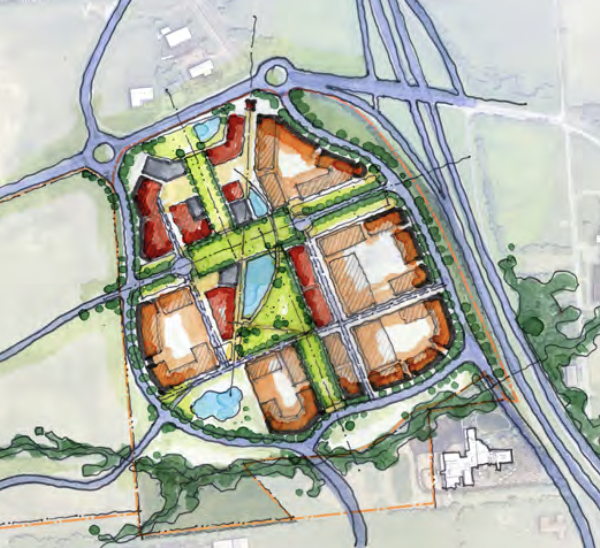
Conceptual Option: Ring Road
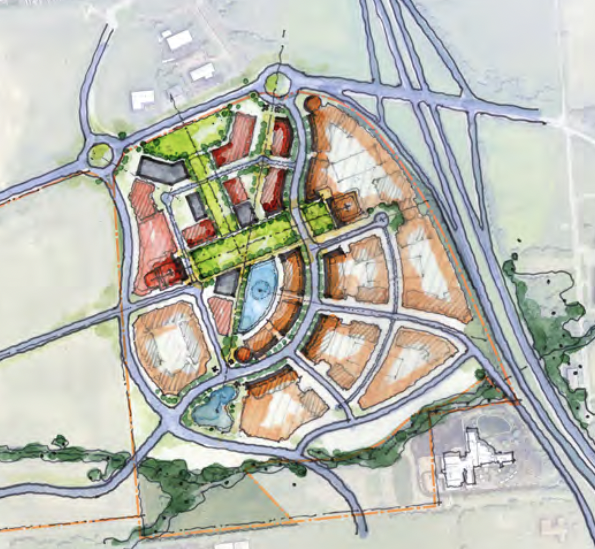
Conceptual Option: Main Street
Steering Committee
- Pamela J. Benoit, Executive Vice President & Provost
- Stephen Golding, Senior Vice President for Strategic Initiatives and Chief Operating Officer of Dublin Campus
- Ken Johnson, Executive Dean Heritage College of Osteopathic Medicine
- Randy Leite, Dean, College of Health Sciences and Professions
- Joe Shields, Vice President of Research & Creative Activity and Dean of the Graduate College
Advisory Committee
- Bill Burke, Heritage College of Osteopathic Medicine
- Brian Thompson, Heritage College of Osteopathic Medicine
- Ginny Valentin, College of Health Sciences and Professions
- Tia Barrett, College of Health Sciences and Professions
- Michelle Ferrier, Scripps College of Communication
- Rachel Cornish, College of Fine Arts
- Phil Taylor, College of Business
- Dennis Irwin, Russ College of Engineering
- Mike Finney, Voinovich College
- Pete Mather, University College
- John Gilliom, College of Arts and Sciences
- Connie Patterson, Patton College of Education
- Jim Smith, Regional Higher Education
- Thomas Raabe, Project Manager, Dublin Campus\
Planning Team
- Ayers Saint Gross, Consultant
- Shawna Bolin, Director of University Planning & Space Management
Partners and Engagement
- City of Dublin
- OhioHealth
- Columbus State Community College
- Facilities Planning Advisory Committee
- College Forums
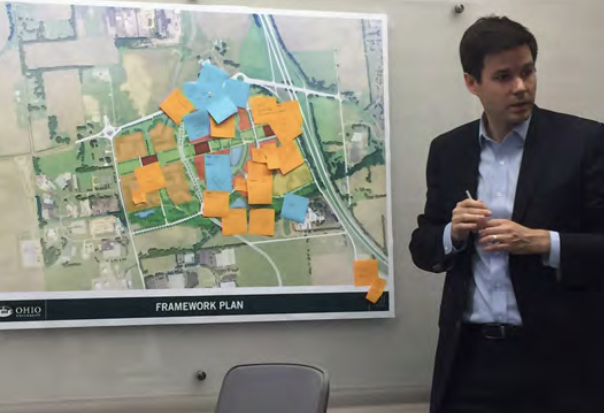
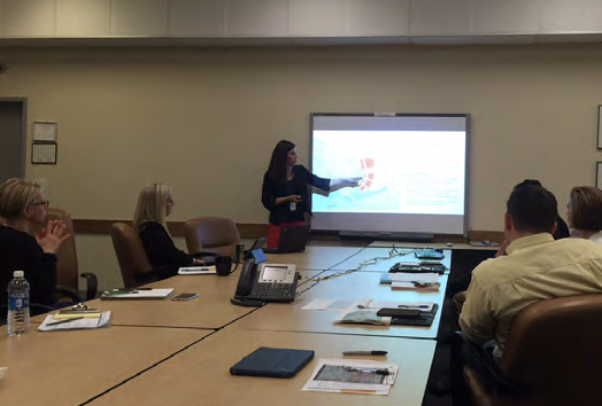
Framework Plan Process Photos
Dublin Framework Plan Goals
Ohio University and the City of Dublin planning committees established the following goals for the Framework Plan:
Ohio University:
- Elucidate high level planning considerations and a
framework for future campus development - Complete the planning requirement specified by the
economic development agreement - Include flexibility and various opportunity sets
- Enable near term projects within the context of the
broader plan - Provide a resource to help make choices so that individual projects are considered as part of the whole
- Use the location as an opportunity to reach students we have not been able to reach in the past
- Expand educational opportunities to new categories of learners, such as working professionals and alumni
- Foster and support robust partnerships that are not
currently available to us - Enable progress on University initiatives
- Establish the OHIO feel at this new location
- Position this campus as an asset
- Enable diverse opportunities to benefit our students and the institution
- Provide Dublin residents with a sense that they are better off because OHIO came to the community
- Provide opportunities for OHIO to be a stronger and more competitive 21st century institution



City of Dublin:
- Have a plan in place so that future projects can more easily go through the City approval process
- Understand where different programmatic elements
would go within their district plan - Maintain flexibility as part of the plan
- Provide opportunities for Ohio University to be well
integrated into their community - Be a catalyst for long term positive impact on the City
- Build partnerships and enable additional economic
development opportunities - Understand the infrastructure needs that the City
provides to forecast and plan their future projects - Enable a comfortable environment for biking/
pedestrians and transit - Understand existing regulations that may need to be
modified for a University setting within the district
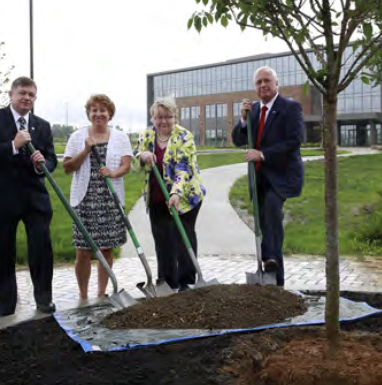

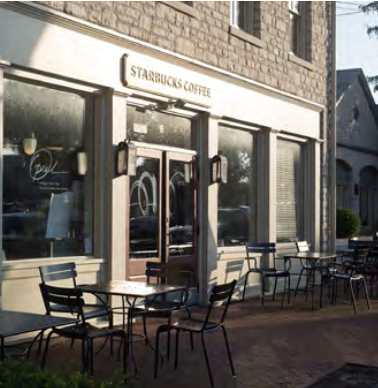
History of the Dublin Campus and Current Condition
In 2012, the University acquired property in the City of Dublin to establish a new location with the Heritage College of Medicine (HCOM) as the primary academic unit. Shortly thereafter, OHIO entered into an economic development agreement with the City of Dublin to acquire the their publically owned property surrounding the site. The agreement divided approximately 96.5 acres of land into three subareas. The University acquired Subarea 1 (45 acres) with the original purchase. The University will acquire Subarea 2 (25 acres) when this Framework Plan is complete and it is intended for Subarea 3 (25 acres) to be jointly developed with the City.
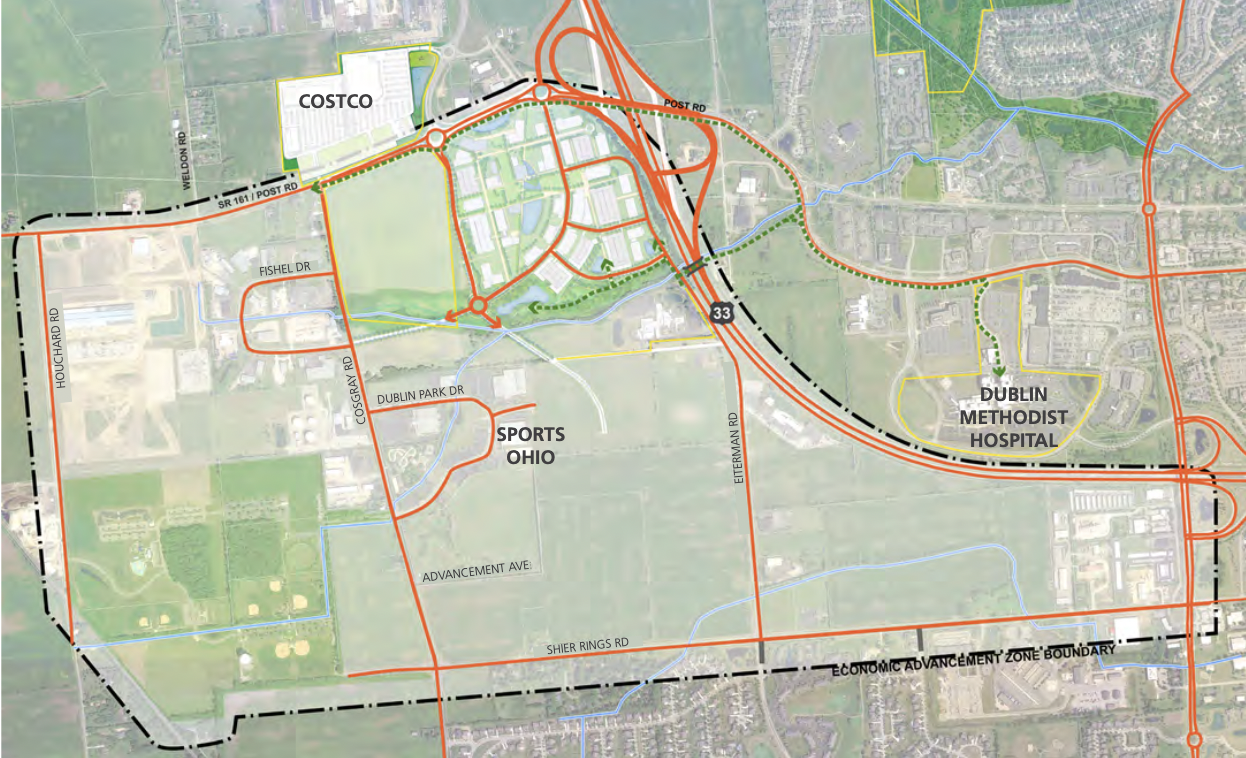
West Innovation District Context
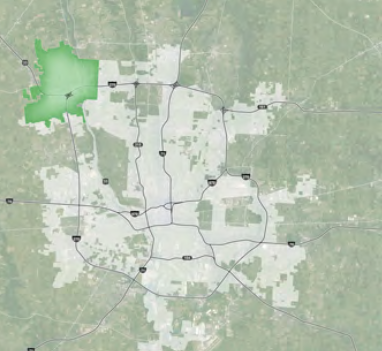
City of Dublin
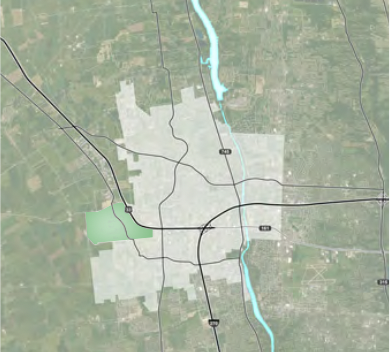
West Innovation District
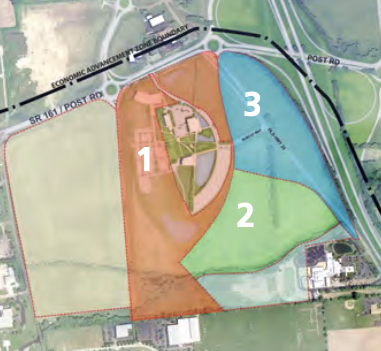
Existing Subareas
Campus Timeline:
April, 2011
- The Heritage College of Osteopathic Medicine (HCOM) was gifted $105 million from the Osteopathic Heritage Foundation.
November, 2011
- After several sites were considered, HCOM chose Dublin as their central Ohio extension campus location. The parcel of land purchased consists of approximately 14.8 acres and has three existing building structures, presently addressed 6775,6785 & 6795 Bobcat Way.
June, 2012
- OU and the City of Dublin entered into an Economic Development Agreement (EDA) whereby the University can acquire approximately 97 additional acres of land owned by City of Dublin surrounding the site.
July, 2012
- OU was conveyed Subarea 1 (45.4 acres) of the EDA.
May 2013
- The Robert Weiler Company completed a market feasibility study for a potential hotel/conference center that concluded with favorable conditions.
June, 2013
- HCOM began renovations on the three existing buildings.
October, 2013
- OU selected Daimler as the project developer for the construction of the Dublin Integrated Education Center (DIEC).
July, 2014
- HCOM opened.
April, 2015
- Completion of DIEC. The buildings anchor tenant is the College of Health Sciences and Professions (CHSP) which includes the Physician Assistant (PA) program as well as Columbus State Community College.
October, 2015
- Temporary signage installed on campus.
- Completion of a 230 space parking lot addition
January, 2016
- Master Plan Initiated
Summer 2016
- College of Fine Arts and Design (CFAD) theater program partners with City opens Tantrum Theater
Existing Campus Today:
Ohio University’s Dublin Campus is within the West Innovation District of the City of Dublin. The existingcampus has four buildings that total 194,000 GSF. The campus is also home to:
- Osteopathic Heritage Medical College: 50 student cohort
- College of Health Sciences and Professions: Physician’s Assistance Program
- Tantrum Theater
- Columbus State Community College
- Voinovich School of Leadership and Public Affairs
- College of Business
When the University acquired the property in 2012 the campus consisted of three office buildings, clusteredaround ponds and open space and ringed with surface parking. The buildings were renovated to classrooms, learning labs, a learning resource renter, clinical training and assessment center and offices for the Heritage College of Osteopathic Medicine
In 2015 the 86,000-square-foot Integrated Education Center was completed. The building accommodates several programs by the College of Health Sciences
and Professions and academic partnerships with Columbus State Community College. The futurethe building is envisioned to house other Ohio University programs from various schools and accommodate new partnerships with Central Ohio
colleges, universities and high schools. Ohio University also has a presence within the community of Dublin. The Tantrum Theater held its first season in summer 2016 with 3 productions and
OHIO for Ohio and Dublin Vision
External forces currently have and will continue to have a profound influence on higher education and OHIO’s business model in the coming years. There is both an increasing competition for students and a decline
in funding per student needed to sustain the quality of higher education. Technologies affect how we engagestudents, while expanding our reach to new populations. We are responding to the need for an educated citizenry and workforce demands. We also
assist in solving significant social problems in partnership with industry and government.
To address these forces and remain true to its historical role and mission in the services of the citizens of the
state, it is essential that OHIO design a business model that will allow it to compete successfully in the 21stcentury. This reality significantly influenced the University leadership’s efforts over the last eighteen months in crafting OHIO’s Innovation Strategy ( www.ohio.edu/research/innovationstrategy.cfm
). This strategy recognizes that the University must be increasingly innovative to remain relevant to the region, state, and nation.
The roots of OHIO’s Innovation Strategy originate in Southeast Ohio. In this area, the University is
a powerful engine for innovation, promoting the vibrant communities essential to attracting individuals
and businesses that create economic opportunity. By building a network of strategic regional and statewide
partnerships, OHIO University has become a local and national leader in recruiting high quality students,
pre-eminent faculty and expert staff in support of its mission of teaching, research and service in Ohio and
beyond.
To successfully implement the Innovation Strategy and insure OHIO’s competitive advantage, the University
seeks to use its statewide influence to build bridges between industry, government and academia. To doso, OHIO will evaluate enabling a mixed-use campus that integrates laboratories, commercial spaces,
college classrooms, clinical facilities, residential living, retail amenities, and recreational and cultural activities. The goal is to create a replicable model that reinforces and supports each campus by assembling the advantages for programs and students.
OHIO’s Dublin Extension Campus plans to work collaboratively with Athens and Regional Higher Education to evaluate the possibility of leveraging
existing college resources to deliver complementary innovative academic programs and research that are not offered elsewhere within the system. These academic programs aim to generate new revenue streams that support program investment and
revenue diversification with the goal of mitigating downside risks to existing programs. The plan should include an assessment process to ensure that all new programs and initiatives are economically sustainable with clearly articulated business plans. Opportunities for appropriate ground leases with third party investments and Public-Private Partnerships may also be explored where appropriate.
The plan for OHIO’s new Dublin campus is designed to unify the powers of industry, government and academia and set a state and national standard for mixed-use campuses. It aims to become a national leader
of innovation in healthcare and wellness where faculty collaborate with corporate, governmental andinstitutional partners on real-world solutions. Simultaneously, it plans to offer innovative programs with our academic partners that train the next
generation of Ohio’s workforce and
OHIO is a major engine of innovation in its community, the region and the state.
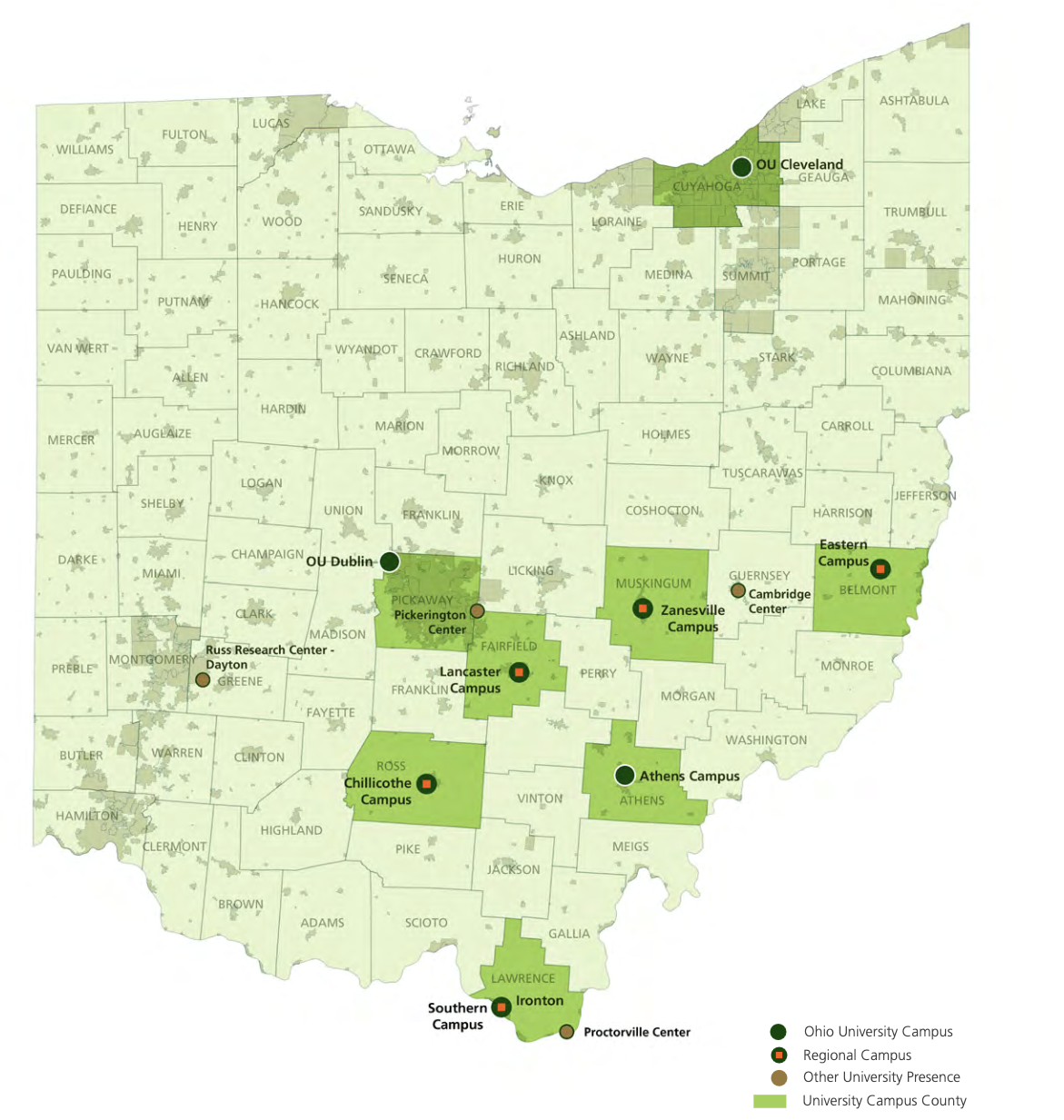
2 - Innovation District & Dublin Campus
While OHIO’s roots will always be in Southeast Ohio, the emerging partnership between the City of Dublin and the University is directly aligned with
the Innovation Strategy. OHIO’s Dublin campus is located in one of the state’s fastest growing cities, strategically located at the juncture of US 33 and
I-270. Today Dublin has a population of almost 44,000 people and over 3,000 businesses. Dublin is part of the Columbus metropolitan area that has a
population of over 1.9 million and is home to one of the nation’s strongest and most diverse economies. Surrounding the campus is Dublin’s West Innovation
District, a critical component of Dublin’s business core. This District is specifically targeted for future technology related development and is the home of the Dublin Entrepreneurial Center (DEC), an incubator and start-up facility which is an important driver of future economic growth in Central Ohio.
West Innovation District
In 2011 the Dublin City Council adopted the West Innovation District (Economic Advancement Zone) Plan. The plan defined a district between Avery Road, Houchard Road, Shier Rings Road, and State Route 161/Post Road, consisting of approximately 1,100 acres of land. The goal of the district was to encourage development of corporate office, research, laboratory and clean manufacturing and higher education leveraging some of the largest contiguous tracts of prime commercial land in the Columbus region.
The plan envisioned a modern enterprise campus with freeway visibility and access, open spaces, and a mix of contemporary architecture and natural landscapes. To encourage development, the area is zoned to streamline the approval process, and infrastructure has been budgeted and engineered to support the vision.
The West Innovation District is designed to become a key economic corridor with OHIO University and its Heritage College of Osteopathic Medicine as key anchors supporting future development. It represents a unique resource in a strategic geographic location offering significant opportunities that cannot be replicated at other Ohio University locations.
Parallel to the University’s Dublin Framework Plan process the City of Dublin is updating the West Innovation District Plan. The update is intended to:
- Integrate with University’s planning
- To reevaluate the geographical boundaries of the Innovation Districts
- Review the land uses with each district to ensure that we are accomplishing the appropriate mix of compatible (and supportive) land uses
- Evaluate the development standards of each districts to ensure we are accomplishing the desired layout and form for development pattern
The Dublin Framework Plan builds on the West Innovation District (Economic Advancement Zone) Plan and aims to create an environment that integrateslearning, research, and industry and government partnerships to foster innovation and collaboration.
Advancing the future of ideas and entrepreneurial spirit in Central Ohio.
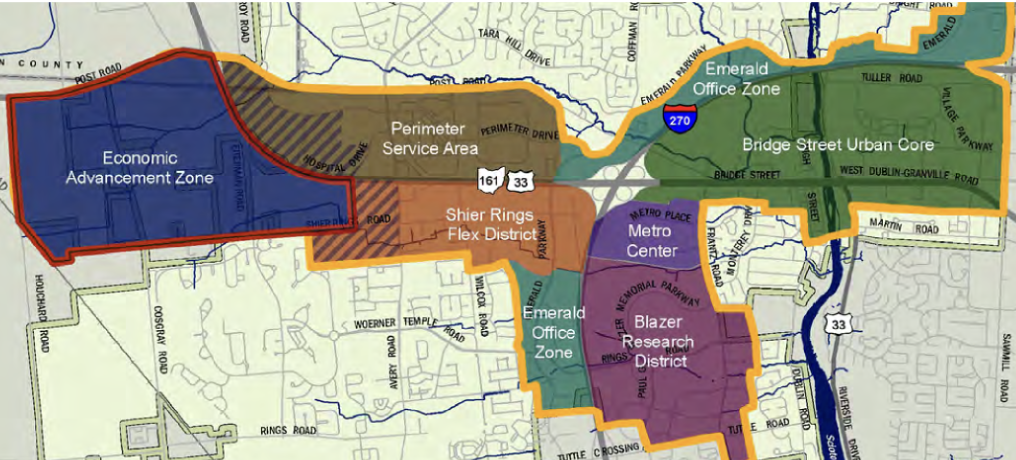
City of Dublin Innovation Corridor
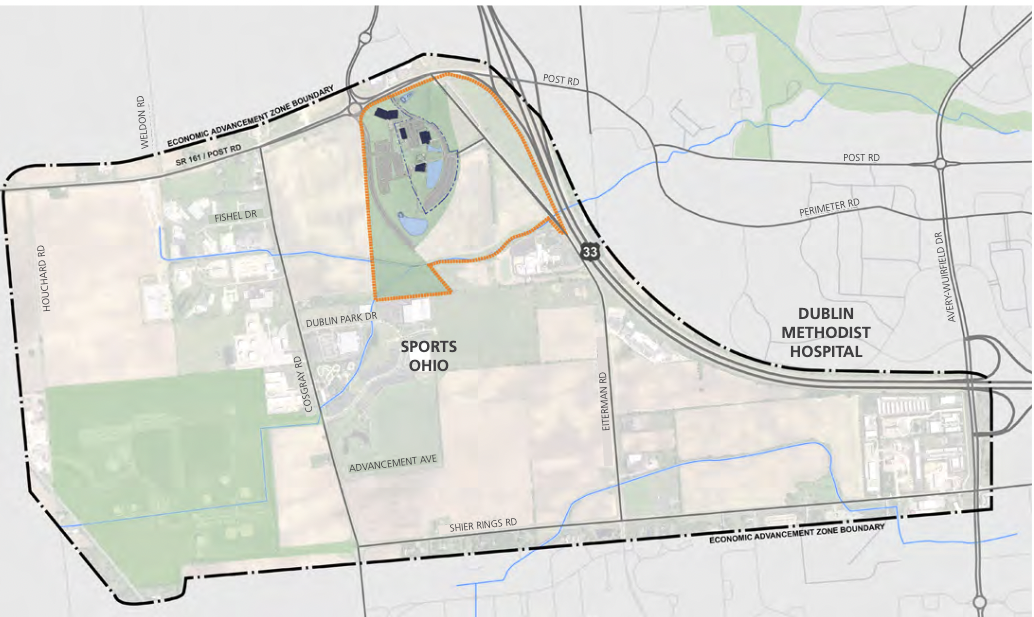
Economic Advancement Zone Existing Conditions
Keys to a Successful Innovation Campus
Innovation Districts are vibrant, mixed-use environments that foster creative
collaboration, establish a sense of community, and attract a talent pool
of knowledge. They combine flexible research spaces, lab and classroom
spaces, maker spaces, co-working spaces, incubators, and collaborative
office space with places to live and play. This includes housing, hotels
and campus serving amenities and retail. A well-designed public realm
– streets, parks, plazas, and other common areas – serves to connect
everything and accommodates the social gathering and programming
that generates community cohesion and creative collisions.
For much of the previous century, research and business was performed
in single-use, closed-off, and auto-dependent ‘parks’ in the suburbs.
Today, data and information flow more freely, technological progress
is frequently crowd-sourced, and discovery is most common at the
intersection of disciplines and organizations. A parallel trend - the
preference of millennials, empty-nesters, and others to live, work, learn,
and play in 24/7 mixed-use areas – is further influencing the evolution of
Innovation Districts as walkable, urban communities.
With Ohio University as an anchor within the district, the West Innovation
District is positioned for success. The Framework Plan considers thepossibility of including the following elements of a successful innovation
district:
- Mix of Use Environment (academic, workplace, hospitality, public amenity, housing)
- Integrate academic, corporate, and public partners
- Proximity - Connected and Walkable
- Place Making - Streets and Public Space
- Access - Parking and Transit
An Article by Bruce Katz and Julie Wagner, The Rise of Innovation Districts: A New Geography of Innovation in America, describes the components of successful of innovation districts.
An Article by Nancy Mann Jackson, Research Parks Redux, describes how partnerships and dynamic innovation environments help respond to decline federal funding and global competition.
One example of such an environment is the Cortex Innovation Community, St. Louis.

Components of a successful Innovation District
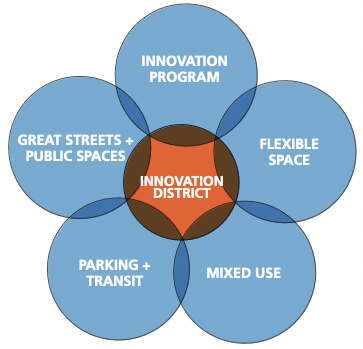
LIVE
LEARN
WORK
PLAY
Create a Knowledge Community where ideas and practice are integrated.
Case Study:
Cortex Innovation Community
St. Louis, MO
In 2002, a consortium of anchor institutions in St. Louis saw an opportunity to change the trajectory of the city. They formed Cortex with a vision to build a new center of innovation – a confluence of great universities and nearly a billion dollars annually in biomedical research. With a $29-million-dollar investment, the institutions set out to transform a decaying area into a vibrant center of research and enterprise. But in 2012, the district was still struggling to take off. It lacked identity. What had been envisioned as an active hub of bioscience and technology innovation was a loose collection of inwardly-focused buildings surrounded by pavement. The district needed a new vision and significant investment in physical place. The lead institutions engaged a developer partner and a planning team to create the Cortex Innovation Community Master Plan, a vision to transform the 200-acre industrial corridor into a vibrant, 24-7, live-work-play-learn innovation community.
Although the master plan is a long-term planning document, it needed to address immediate placemaking challenges. Initial investments focused on establishing a dense core and concentration of activity at the heart of campus. Key developments included the creation of Cortex Commons (the district’s central park), flexible research and lab space in new and renovated buildings around the park, and tree-lined, walkable streets. Prioritizing engagement around a central node—rather than spreading development across the district—enabled people to visualize a true Cortex community. Now, Cortex is working on the next phase of mixed-use development projects, including a mix of renovation and new construction for housing and research.
Cortex is a model for a university-affiliated innovation district that harnesses a single urban location to build a culture of collaboration and discovery. In contrast to past models of research parks as isolated suburban enclaves, the plan for Cortex recognizes the equal importance of function, community, and artistry. Each building, each lobby, each green space, is intentionally designed and choreographed so that people bump into each other, share ideas, and create connections.

Dublin Guiding Principles
OHIO’s Dublin campus represents an unprecedented opportunity for growth and innovation. If successful, OHIO’s Dublin campus will be a national model for how the university can fulfill its mission of teaching future generations of Ohio students, conducting innovative research, and delivering essential services in a cost effective way, while providing the state of Ohio and its citizens with a very positive return on its higher education investment.
The Framework Plan guides the development of a cohesive campus while allowing flexibility to accommodate a variety of programs, partnerships and uses. The following principles ensure a unified vision and will guide decisions on the types of program elements that are approved for the campus:
- New initiatives and programs sited at Dublin should have high impact, be
complementary to the central Ohio community, advance Ohio University interests, and have attributes such that they cannot be accomplished in Athens. - Activities at Dublin should advance “OHIO for Ohio” opportunities to build and strengthen regional partnerships with industry, government, and non-profit organizations to foster innovation.
- Initiatives and programs sited at Dublin should be innovative and uniquely situated for central Ohio.
- Selective investments in support of activities at Dublin must establish financial feasibility and be sustainable.
- Initiatives and programs at Dublin must align with the University and College’s strategic plan and enhance smart growth.
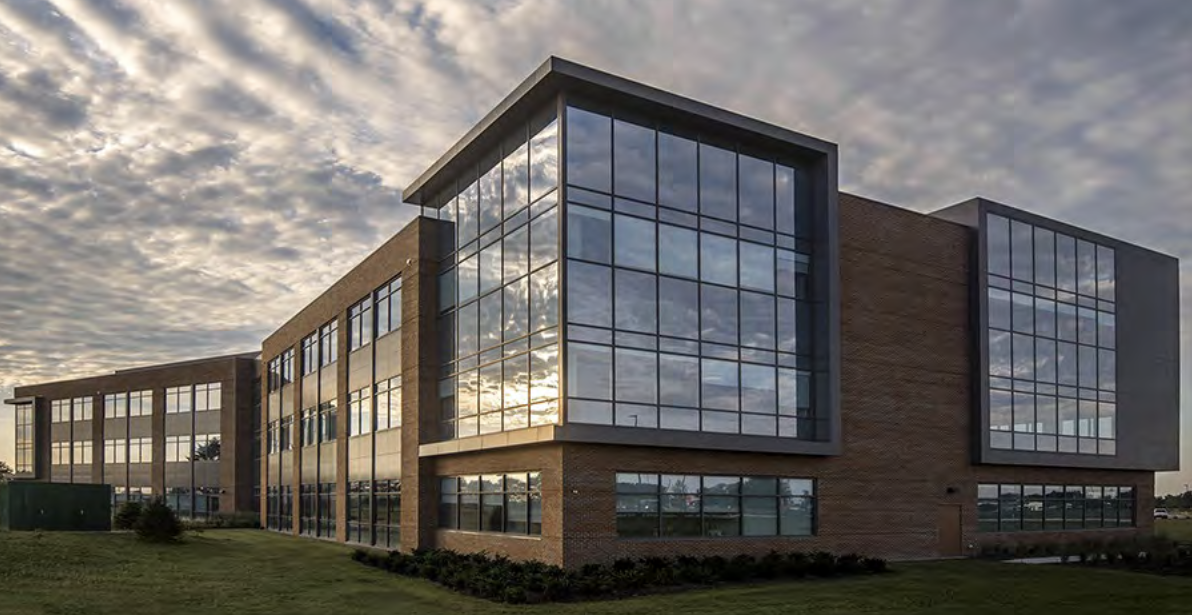
Example Program Elements
Over the past couple of years, OHIO has been reviewing programmatic ideas
that fit within the Dublin guiding principles and support a vibrant knowledge
community. Program ideas were grouped into five overarching themes.
1.University Programs:
Some examples of potential programs to be offered at Dublin include:
Emerging or new programs
- Tantrum Theater
- Adult Degree Programming
- Customer Service Program
- Professional Development
- Communication Studies
- MA in Organizational Communication
- Applied Communication Bachelor Completion
- MA in Info and Tel Systems
- Innovation Leadership Program
Programs that may be offered at Dublin to expand outreach
- Bachelor of Business Administration
- Bachelor of Science in Applied Management
- Masters of Accountancy
- Accountancy Post Bach Program
- Masters of Mgmt Leadership
- Professional MBA
- Executive Education Liaison
- Continuing Education
- Hospitality Program
- Executive MPA
2. Health and Wellness:
Uses that complement and strengthen the existing health and wellness presence
- Wellness Center
- Senior / Aging-in-place Services
- Veteran’s Rehab Center
- Patient Communication
- Collaborative
Health and wellness programs such as:
- CHSP Health Leadership Program
- Pharmacy Programming
- Master of Physician Asst Practice
- Patient Communication Initiative
- Master of Corporate Wellness
- Dietetics Internships
- Nursing: DNP & MSN
- Health Leadership
- Master of Health Education
- Research Space
- Support Services
3. Industry, Government and Healthcare Partners:
City of Dublin, Ohio Health and other Partnership opportunities in Central Ohio
- Innovation Incubator/ Accelerator
- Co-working Space
- Tech Companies
- Public Service Agencies
- Non-Governmental Family Practice
- Clinical Facility
- Professional Office Space (such asOhioHealth)
- Multi-Tenant Corporate Research
4. Academic Partners:
Collaboration with other universities, colleges, and school systems
- Columbus State
- Dublin STEM School
5. Mixed Use:
Uses that may support and provide for a vibrant campus
- Hotel & Conference Center
- Community Meeting Space
- Corporate Training Facility
- Campus Amenities – Restaurant
- Coffee Shop, Bookstore, Market,Art Gallery
- Recreation Programs
- Day Care / Child Care
- Housing options oriented towards
Planning Principles
Key to the success of the campus is creating a vibrant, walkable place that
can support a variety of initiatives. As part of the planning process six physical
planning principles were developed to guide development of the Dublin Campus.
-
ESTABLISH A VIBRANT COMMUNITY
identity, sharing of resources, a central place


2. ENCOURAGE PROXIMITY AND WALKABILITY
compact, pedestrian oriented, smart growth


3. CREATE CONNECTIONS
open spaces, complete streets, integration

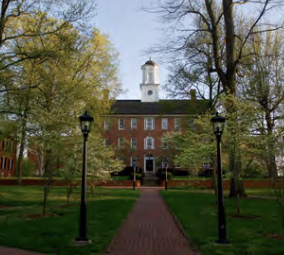
4. ENABLE THE DEVELOPMENT OF A MIXED-USE ENVIRONMENT:


5. FOSTER INNOVATION:
inter-disciplinary interactions, partnerships, economic development


6. ACCOMMODATE VARYING INITIATIVES:
support the University’s Strategic Plan, flexible spaces

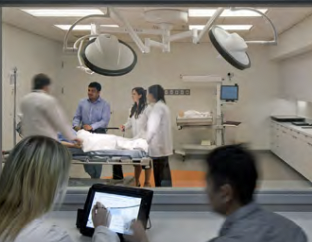
3 - Framework Plan
The Framework Plan is centered on creating a pedestrian-friendly, walkable campus district that can be implemented in a phased approach over time. While it is a flexible framework, there are key elements of the plan that are important to supporting and complementing a vibrant knowledge community. These elements include the street network, open space, land use/capacity,
and potential phasing to guide implementation. Together these elements create a campus district identity by establishing a central place, creating
strong physical connections, supporting a dense mix of uses, and fostering collaboration by providing opportunities for inter-disciplinary interactions and
strategic partnerships.
The physical environment should support community, partnerships and innovation.
Existing Conditions
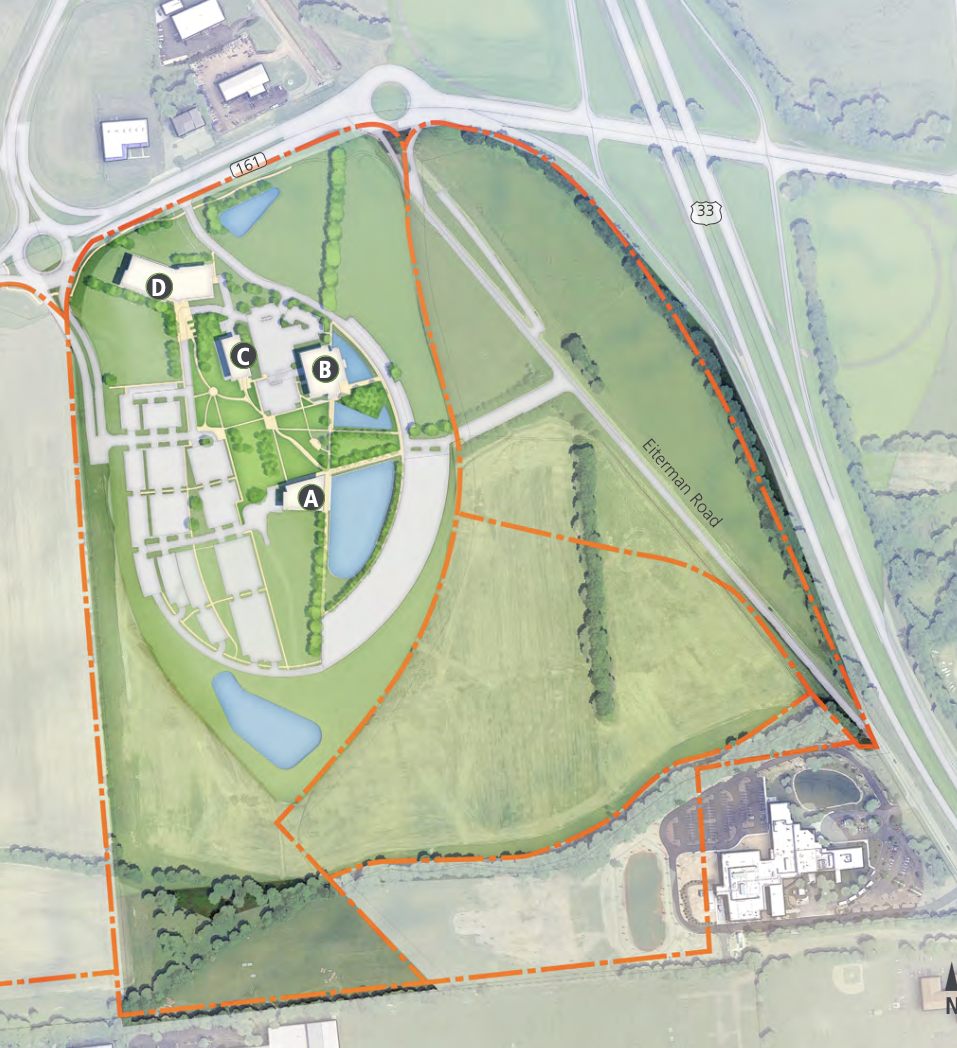
A. OhioHealth Medical Education Building 1 (MEB1)
B. OhioHealth Medical Education Building 2 (MEB2)C. Osteopathic Heritage Foundation Anatomy Laboratory
D. Dublin Integrated Education Center
Proposed Framework Plan
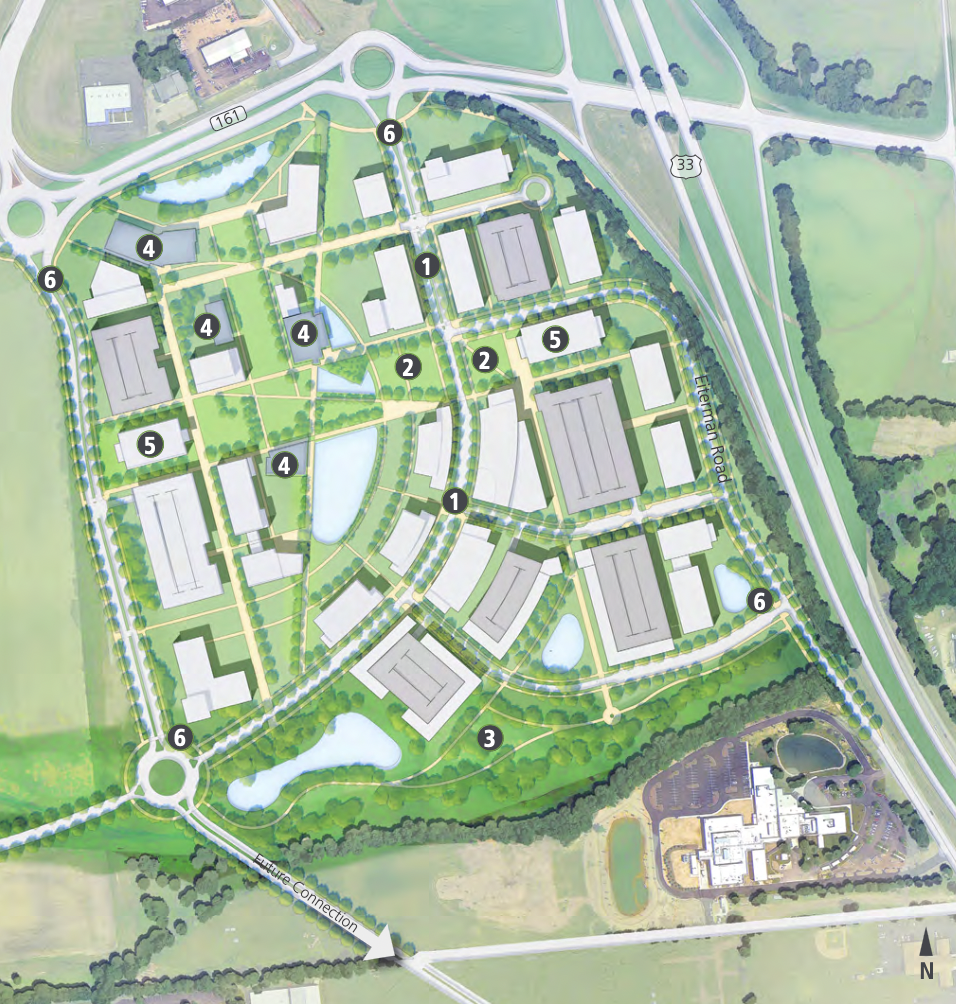
1. Main Street
2. Formal Green
3. Informal/Rec Green
4. Existing Building
5. Signature Building
6. Campus Gateway

View of Proposed Campus Boulevard
Major Street Network
One of the main organizing elements of the Framework Plan is the development of a “Main Street” through the campus district. Main Streets are the traditional center for social, cultural, and economic activity for their communities. The Main Street orients the campus district and is part of creating a sense of place. It is also a pedestrian-friendly street that has a mix of uses. The Main Street is not meant to be a through street, but rather a destination. While the Main Street is an organizing element of the campus district, all streets within this campus district should be complete streets that take into account all uses- not just motor vehicles, including walking, cycling, servicing, parking, etc.
Part of the street network development for this campus district includes north/south connectivity through the site. As development of the West Innovation District grows, connectivity from Route 161/Post Road to the south will be amplified. The Framework Plan proposes the extension of University Boulevard to the south as the main connector for through traffic rather than the Main Street. Beyond the campus district, the proposed University Boulevard extension will eventually connect all the way to Shier Rings Road to the south.
Another important connection is Route 161/Post Road to Eiterman Road. TheFramework Plan proposes rerouting Eiterman Road so that it connects to the north edge of the Main Street, close to Route 161/Post Road, rather than directly intersecting it as it does now. Since the Main Street is the organizing element of the plan, it is important that it have direct access from Route 161/Post Road. All roads through the campus district coordinate with future connections through the West Innovation District Plan. Developing the roadway infrastructure for major campus district streets requires coordination with the City and future projects so that utilities are also incorporated.
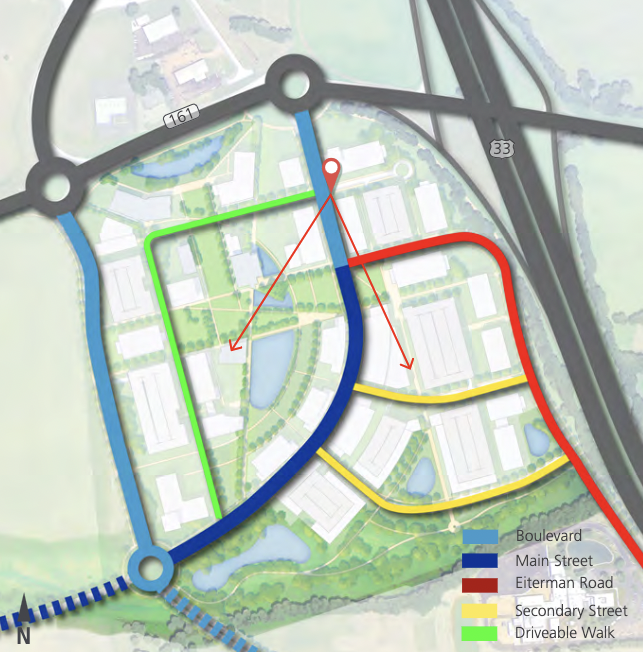
Proposed Street Network
Characteristics of major streets:
University Boulevard:
The Boulevard is a four-lane roadway that supports north/south traffic movement, however it should still feel like it is part of the overall campusdistrict. The street profile includes 11-foot travel lanes, on-street parking, a narrow median, and a multi-modal pathway with bike lanes.
Eiterman Road:
Eiterman Road will be rerouted to connect with the Main Street. The two-lane roadway provides secondary access from Post Road to the southand should have on-street parking to support the campus district.
Boulevard / Main Street-North:
The north end of Main Street creates an inviting entrance and forms a campus district gateway. It starts at the roundabout on Post Road and terminates where Eiterman Road intersects. It should be designed to accommodate a high volume of traffic however it should include pedestrian crossing areas, street parking, planted medians, and 11’ traffic lanes to slow traffic.
Main Street-South:
The centralized area of activity for the campus district should be a two-
lane roadway with on-street parking, bike lanes, and a wide sidewalk to
accommodate an amenity zone serving the ground floor public spaces. When
the Main Street crosses a major open space, it should have special paving
materials to reinforce the pedestrian environment and should not have on-
street parking to maximize the impact and views of the green space.
Secondary Street:
Secondary streets primarily serve the parking garages that are internal to the block structure of the plan and provide alternate connections to Main Street from Eiterman Road. Their roadway profile is similar to Eiterman Road but should be designed to get vehicles and pedestrians to their destination rather than move vehicles through the campus district.
Drivable Walk:
On the northwest side of the Main Street, drivable walks provide vehicularaccess to development without compromising the integrity of the open space. Drivable walks allow for drop-off at building entries, handicap accessibility, fire truck access, and service/loading but they are designed so that the pedestrian is the priority, not the vehicle. They should have very narrow drive lanes and may have special paving materials to distinguish them from regular roadways. During certain times of day, drivable walks may be limited access for vehicles.
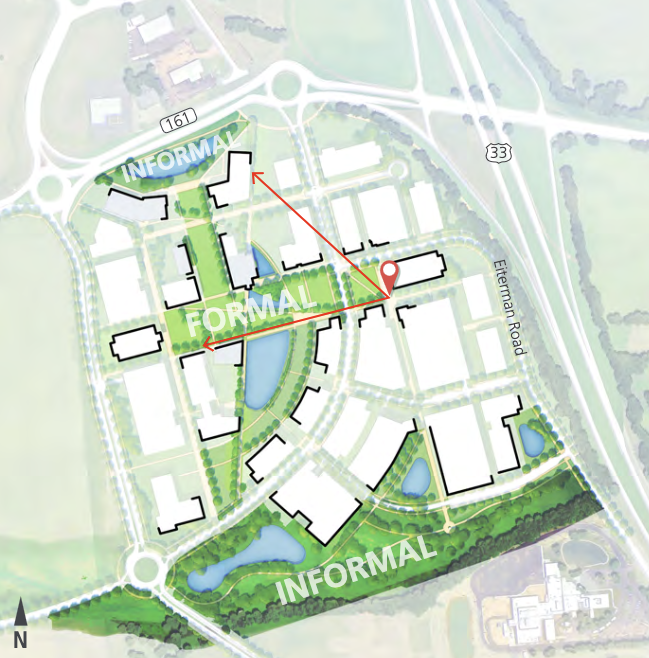
Proposed Open Space Network
Open Space Network
Much of the campus district experience is defined by outdoor spaces. An important part of the Framework Plan is the creation of an open space network that enhances the campus district and creates a sense of place. The plan proposes formal open spaces that respond to and enhance the existing open space and curved lake including an iconic east/west mall, one of the organizing elements of the plan. The curve of the Main Street responds to the curve of the existing pond, linking different areas of the campus district and creating an open space around the pond that facilitates activity and interaction. This area aims to provide a transition from the built environment to the natural landscape. A collegiate-style quad is designed to link the mall to the informal open space along Route 161/Post Road. This passive landscape is designed to create a front door that is recognizable along Route 161/Post Road and provides a visual cue to the campus district. On the south edge of the site
the plan calls for another informal open space that acts as an ecological corridor through the campus district. The Framework plan envisions active
and passive recreational elements in this area to enhance the campus district. Part of this informal open space would be in the flood plain so it is also a natural place for stormwater management. It can be part of a larger regional connection that links the campus district to Sports Ohio and across Route 33 to OhioHealth.
Open space Characteristics:
Informal:
These spaces are less-defined and support outdoor learning, recreation, and passive uses. The open space network proposed as part of the Framework Plan is significant. The major open space in the plan is of a similar scale to the Centennial Campus at North Carolina State. Some of the smaller open spaces in the proposed plan are of a similar scale to West Green at the Athens Campus.
Formal:
These are defining open spaces with simple, rational networks of pedestrian
paths that cross throughout the space to accommodate main circulation routes. They are focal points for the campus and are usually collegiate-style
quadrangles.

View of Campus Central Open Space
The open space network proposed as part of the Framework Plan is significant. The major open space in the plan is of a similar scale to the Centennial Campus at North Carolina State. Some of the smaller open spaces in the proposed plan are of a similar scale to West Green at the Athens Campus.

OHIO UNIVERSITY - DUBLIN CAMPUS
Proposed Master Plan Pedestrian Campus Core:
7 Acres
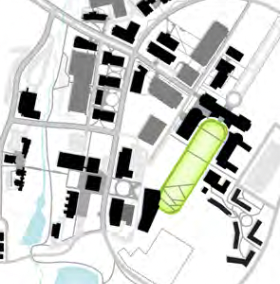
NORTH CAROLINA STATE –
CENTENNIAL CAMPUSCentennial Campus Pedestrian Campus Core:
6 Acres
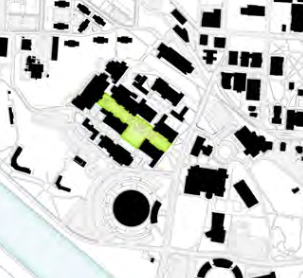
OHIO UNIVERSITY - ATHENS CAMPUS
West Green Pedestrian Campus Core:
3 Acres
Site Typologies
The Framework Plan does not prescribe a rigid development program or allowable uses for each development site. Instead, it allows for flexibility in order to achieve the prime objective of creating a vibrant campus district with a healthy and robust mix of uses. To help guide development, the plan is broken down into five site typologies.
As Part of the Economic Development Agreement the between the City and
University the property was organized into three subarea each with specific
development requirements.
The proposed Framework Plan recommends adjusting the boundaries of the subareas to align with the proposed streets and open spaces. The general location and area of each subarea remains the same.
Subarea Summary:
Core Property : 15.1 acres
Subarea 1 : 45.4 acres
Subarea 2 : 25.9 acres
Subarea 3 : 25.2 acres*
* Ohio University and City of Dublin agree to work cooperatively.
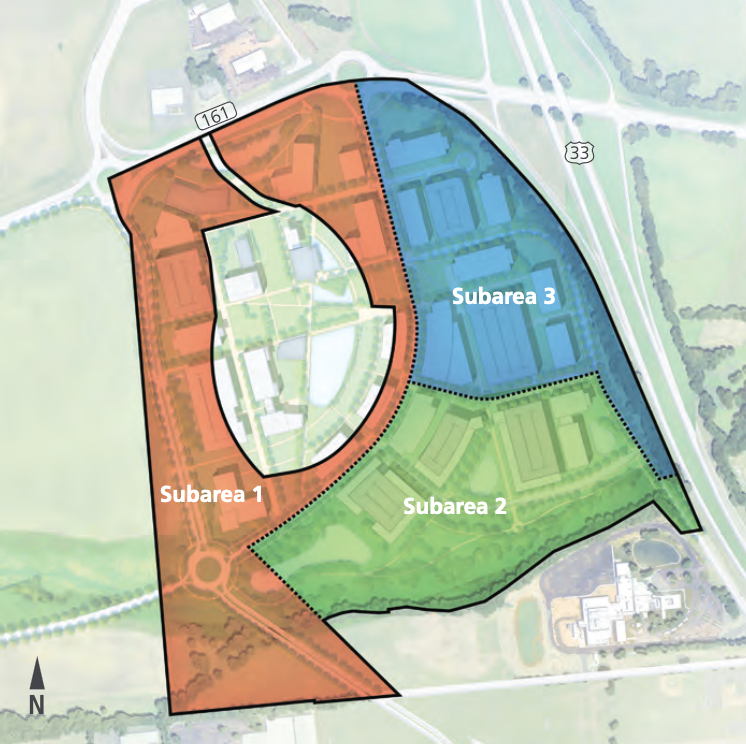
Potential Updated Subarea Map
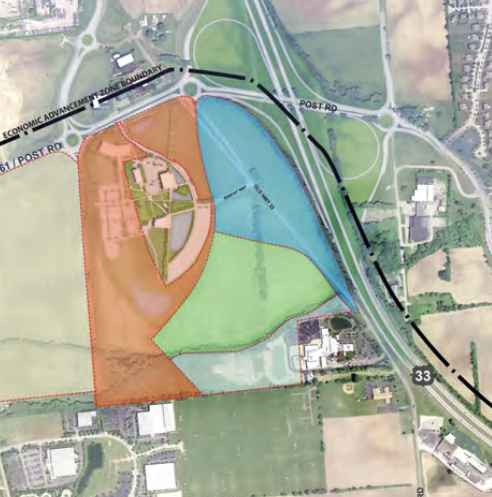
Current Subarea Map
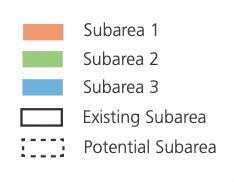
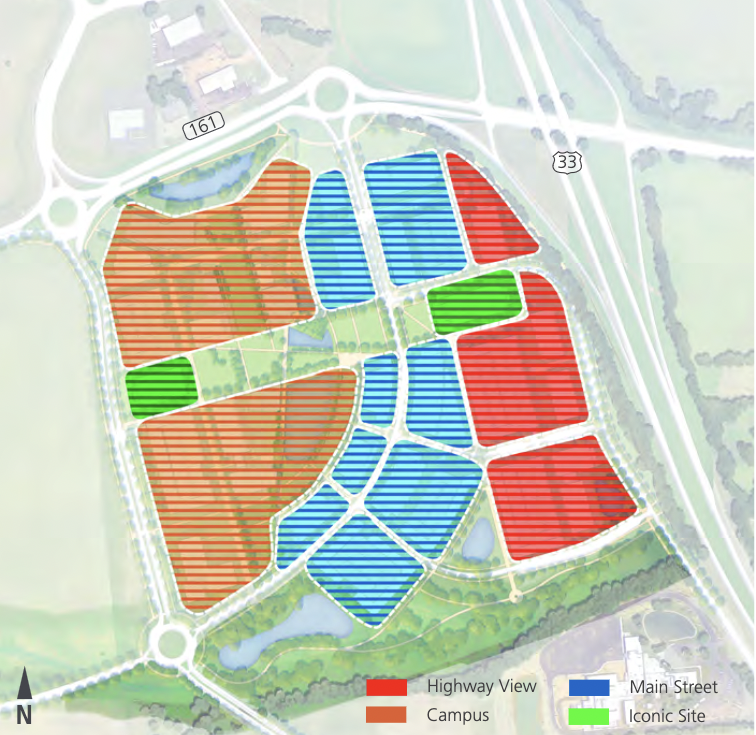
Campus Site Typologies
Main Street Sites:
These sites are part of a vibrant public and amenity setting that complement
the academic mission of OU. They have a clear sense of address on the Main Street and direct access to parking. Buildings along Main Street should have active ground-floor uses to engage the street. Examples of appropriate uses include bookstores, coffee shops, and convenience retail, as well as, Innovation, art, and cultural spaces. Upper levels could have residential units, office space, or academic functions. Buildings on the west side of Main Street should have dual front doors and embrace the central campus open space.
Parking should be consolidated behind buildings fronting the east side of
Main Street. Buildings in this zone should be 3-4 stories with a 30-foot
setback above the 3rd floor along Main Street to maintain a pedestrian
scale along the street.
Highway View Sites:
These sites have high visibility from Route 33 and have a clear address
because they front on a campus street. The east edge should be designed to
provide dynamic views from Route 33. These sites also have direct access to
parking because the blocks are large enough to accommodate parking
structures internal to the block. The parking should be consolidated and
screened from view of Route 33. Ideal uses for these sites include public
functions that want visibility from Route 33, including hotel, conference,
wellness, research, and corporate partnerships. Residential uses should
not be along the eastern edge facing Route 33. The southern edge should
embrace the open space that it fronts. Buildings in this zone should be 3-4
stories.
Campus Sites:
These sites are more pedestrian-focused in a collegiate setting with a range of visibility and access. The north edge should be designed to provide dynamic views from Route 161. Buildings should be designed so that their edges form well-defined open spaces. They are supported by parking on the edges that front the Boulevard, away from the campus open space. Buildings in this zone can be 1-4 stories, depending on the use. For example, a one story building may be appropriate if it is auditorium-style with a large floor height but academic/research buildings would want to be 3-4 stories.
Iconic Sites:
These sites are organized around the main campus open space and are special sites for buildings as objects in the landscape. The buildings should be
designed to be an orienting element for the pedestrian and enhance the
landscape in which they are located. The ground floor should be porous
through the building and have a community oriented focus. Because
of their iconic nature, these buildings should be 2-4 stories.
Potential Phasing and Site Capacity
The Dublin campus is intended to be built-out over time. Even though a
phasing strategy is suggested, the plan is flexible so that the phasing could beadjusted based on opportunity. Early phases should be focused at the core
of the site and along the Main Street to maximize activity and density as soon as possible. The earliest phases should concentrate development around existing buildings as well as high visibility sites along Route 161 and Route 33 (the northeast corner of the site). It is assumed that as the site gets built out, parking needs will be accommodated but the parking ratio would be reduced over time. To support phasing and ability to prepare for future programmatic opportunities, collaboration with the City to time road re-alignments and installation will be key to campus success.
The existing campus has four buildings that total 194,000 GSF. There are
1,100 cars, which means the parking ratio is 5.7 parking spaces per 1,000
square feet (5.7/1,000). Potential implementation is broken down into three phases.
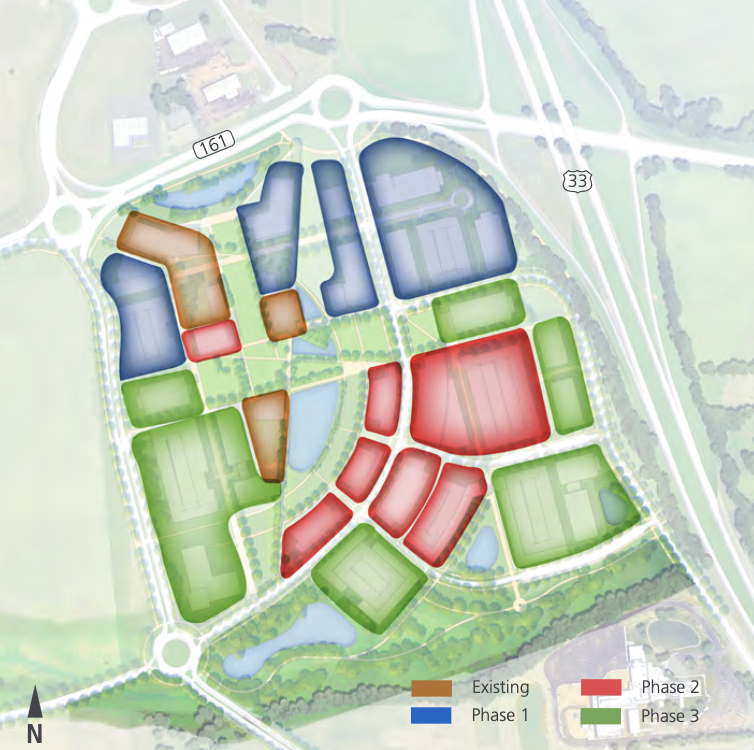
Potential Phasing
Phase 1
Phase 1 incorporates the realignment of Eiterman Road and Main street North, setting up the future Main Street South. This area supports up to six additional buildings to the ones that currently exist. To accommodate the illustrated building capacity, either two parking garages need to be built or a significant portion of the campus district would need to convert to surface parking, eliminating the campus landscape and requiring significant stormwater detention. Phase 1 adds 618,000 GSF across seven buildings and accommodates an additional 2,550 cars. Ideally the additional parking spaces would be mostly accommodated in two garages (approximately 2,000 cars) with and an additional 550 surface parking spaces. After Phase 1 is complete,
the total campus square footage will be 812,000 GSF with 3,650 parking
spaces, assuming a parking ratio of 4.5 spaces/1,000 sf.
Phase 2
Phase 2 incorporates the extension of the Main Street North to connect to the south end of the campus district. Development in this phase should focus around the Main Street to continue to build out this central connecting spine of the campus district. Phase 2 considers the addition of 515,000 GSF across six new buildings and accommodates an additional 2,100 cars in two garagesfor a total of 1,327,000 GSF and 5,450 parking spaces. This assumes a reduced parking ratio of 4.1 spaces/1,000 GSF. The development capacity shown in Phase 2 cannot be accommodated without the addition of parking garages.

Framework Plan Full Buildout
Phase 3
Phase 3 allows for the build out of the campus district with an additional
922,000 GSF and an additional 3,600 cars in three garages. After the completion of Phase 3, the majority of surface parking on the campus wouldneed to be replaced with buildings and open space if we implement the plan
for the total capacity of the district. The total capacity of the campus district is 2,249,000 GSF with 7,700 cars. This assumes a parking ratio of 3.4 cars/1,000 sf. If a higher parking ratio is desired, the total
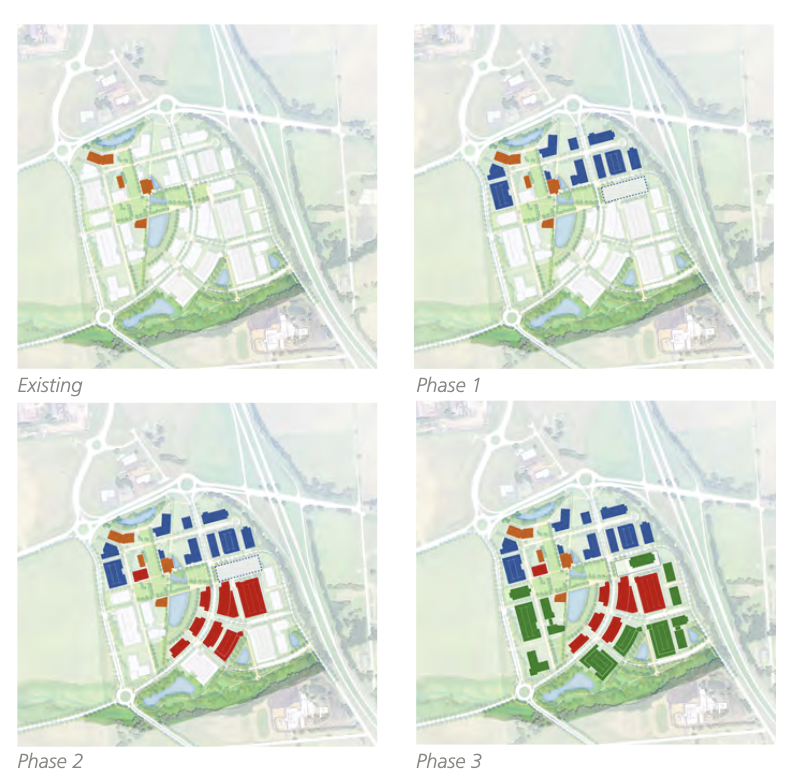
4 - Campus Guidelines
The Campus Guidelines provides a flexible framework for development of the Dublin campus. Good urban design requires the careful arrangement of buildings, open spaces, transportation systems, services, and amenities within a large site.
1. Frontages
2. Service Areas
3. Parking
4. Pedestrian Connections
5. Key Visibility
Create a flexible framework to guide future development.
Frontages
Campus buildings front two types of spaces: streets and open areas. In both situations, buildings form an edge that defines the public realm. Frontages along the Main Street are key to defining its sense of place and should maintain pedestrian interest at the ground level. The open space network on campus is also formed by a series of building frontages that create both grand and intimate spaces. The frontages along Route 33 and Post Road provide an opportunity for both the campus district and individual development sites to take advantage of views from those major roadways.
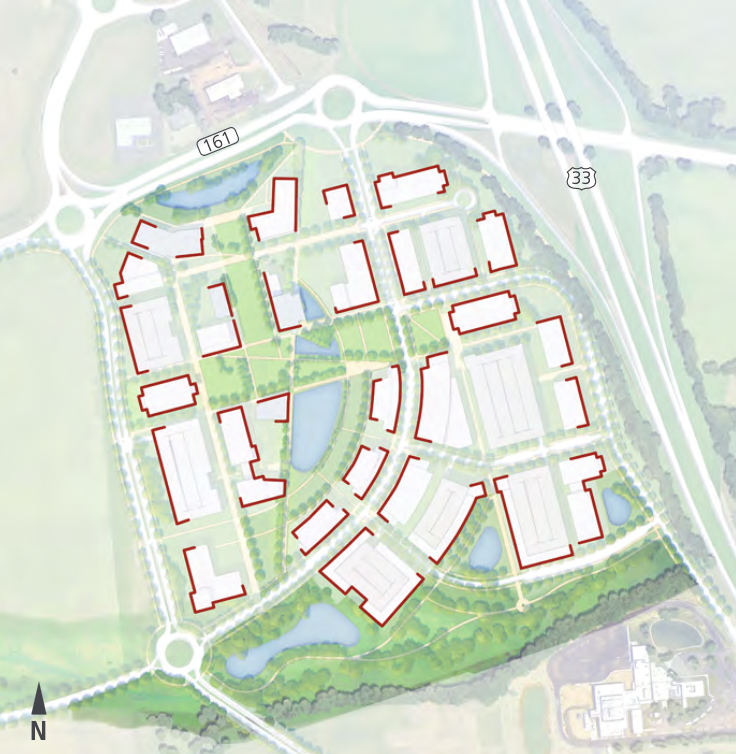
Proposed Building Frontage

Example of Building Frontage in Rockville, MD
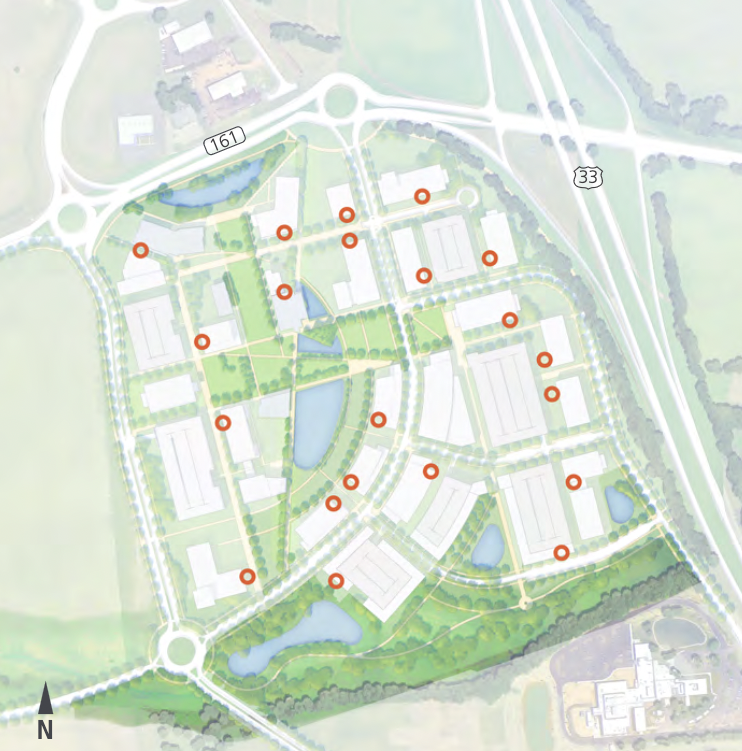
Proposed Service Areas

Consolidated and Screened Service Areas
Service Areas
To support vibrant street life, service and loading areas should be consolidated and screened so that they are out of view of the public realmand away from important streets. Service and loading entries should be clearly signed and carefully located so as not to impact the continuity of the streetscape. Ideally, these elements will face alleys, internal courtyards, or areas within the block where consolidated service and loading is provided for a building or multiple buildings. Service entries should be enclosed and screened with materials and colors that respond to the architectural language of the building.
Parking
Parking is a critical component for any district and most successful when it is sensitively located and consolidated. To accommodate the buildout of the campus, the Framework Plan recommends parking garages to maximize the available programmatic opportunities for the campus. While structured parking is key to maximizing the capacity of the campus, it is anticipated that surfacelots will be built in early phases. Surface lots should be screened from the primary frontages with buildings or landscape elements. Large surface parking lots should not be a long term solution for the campus.
Parking garages can be four stories plus a roof for additional parking but should not be taller than the surrounding buildings. Every effort should be made to integrate vehicular movement into and out of parking areas without impeding the pedestrian experience, ideally on secondary streets. Parking garages should be embedded within the street block and concealed behind a building liner, where possible. When exposed to the public realm, the facades should be well designed and architecturally compatible with their surrounding
context. Elevator towers within parking garages should be designed as prominent features to mark entrances and introduce visual interest. Future
parking signage should be part of an overall campus signage plan and should be developed to help guide visitors, employees, and students to the appropriate locations.
On-street parking would be designed to benefit high activity centers, preferably located on and near the Main Street. It is more convenient and
slows traffic. It also creates a buffer between travel lanes and sidewalks fora safer pedestrian environment. While the Framework Plan accommodates
a parking ratio related to building development, it is still important to encourage alternate modes of transportation to reduce the number of parking spaces required. To that end, the Framework Plan proposes bike lanes and can incorporate future transit opportunities. The City of Dublin should plan to develop and implement a mobility study that seeks to provide multiple modal options for the movement of people throughout the West Innovation District. Future development on the campus should work with the mobility plan, such as consideration for transit stops.
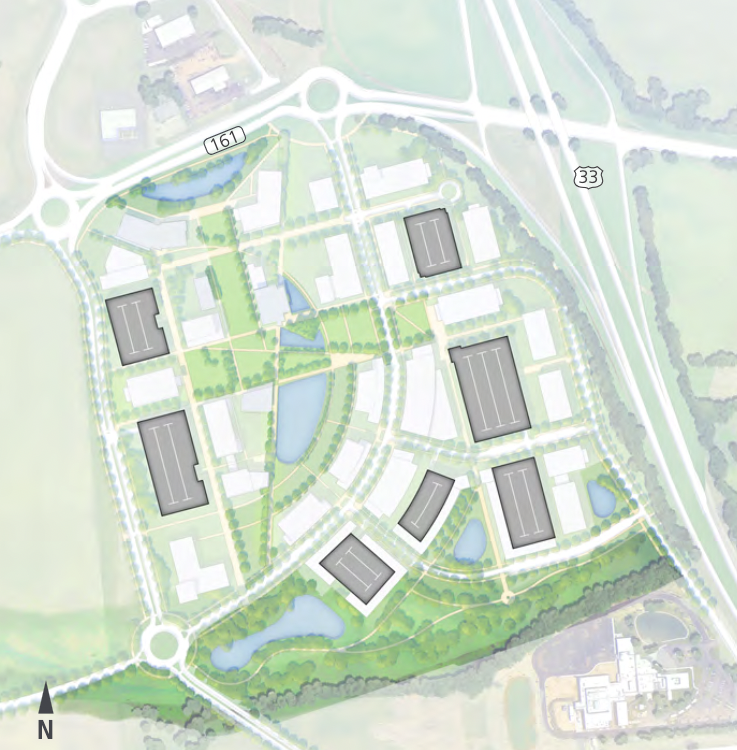
Proposed Off-Street Parking
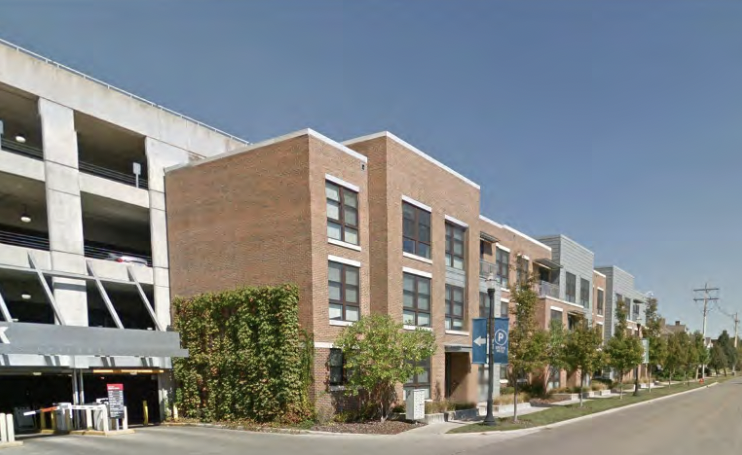
Parking Garage Screened by Single-Loaded Residential – Columbus, Ohio
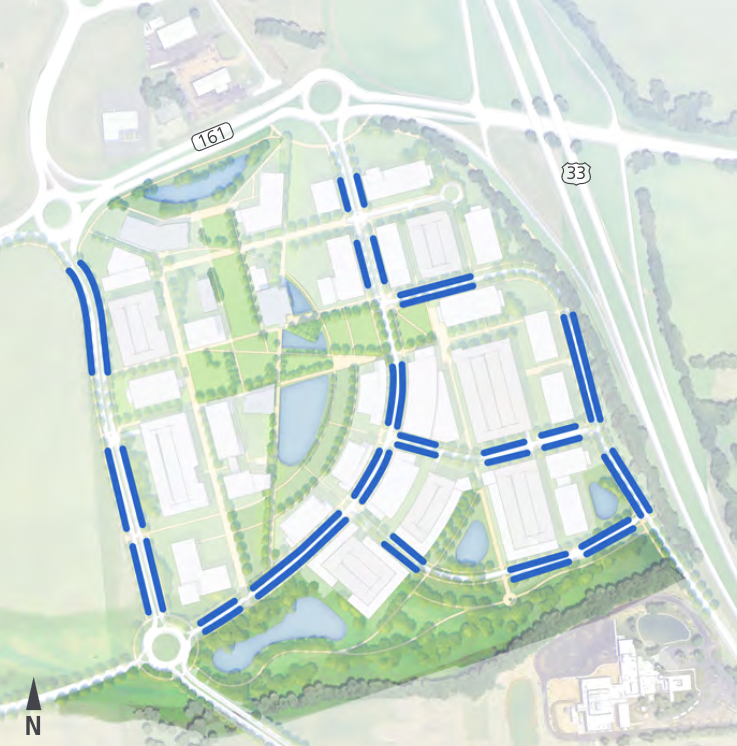
Proposed On-Street Parking
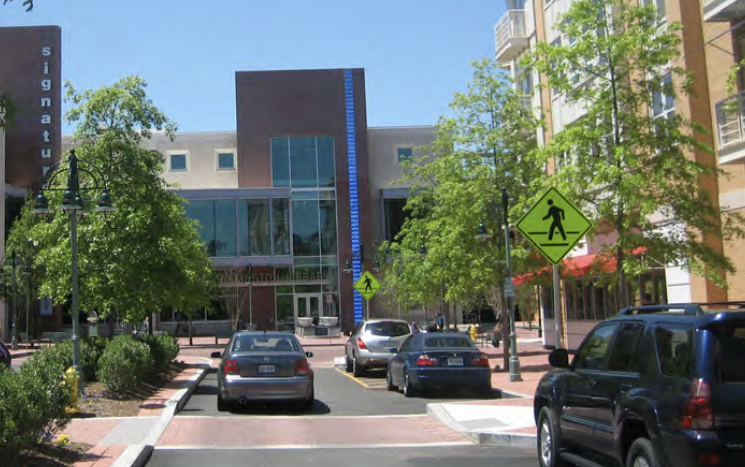
On-street Parking - Shirlington, Virginia
Pedestrian Connections
Pedestrian pathways would be designed to provide reasonably direct, accessible, and convenient connections between buildings and adjacent streets, as well as other parts of the campus district. In the Framework Plan, strong connections would be formed through the open space and street networks. Pedestrian connections also can occur along wide, drivable walkways that allow for drop-off at building entries, handicap accessibility, and service/ loading but are also pedestrian-friendly. Drivable walkways would be streets designed primarily with the interests of pedestrians and cyclists in mind but still available for use by vehicles. The design aims to reduce both thespeed and dominance of motorized transport. Drivable walkways are proposed through the “campus sites” to the west of the Main Street.
Other important pedestrian connections in the design are north/south from the open space that fronts Post Road, through the main open space to the south side of campus. Robust pedestrian connections are an important part of the street network but they can also take the form of drivable walkways that double as service drives and pedestrian connections. Pathways should be
enhanced and marked with lighting, signage, and incorporated protection
from the elements when possible, for example ample tree cover along sidewalks.
Key Visibility
The Dublin Campus has significant visibility from major roadways which makes it a very attractive site for development. The building sites that immediately front Route 33 and Post Road have visual prominence and their design should respond accordingly. Other prominent sites are buildings along the Main Street
and the iconic sites along the main campus open space. Visibility into the
campus from the surrounding major roadways is also important so that the activity happening within it can be seen by those passing by. Being able to see down the Main Street and the Boulevard and across open spaces from the edge of campus is an important way to draw people in. These views into campus are formed by the proposed network of buildings, roads, and open spaces so that there are view corridors from Route 33, Post
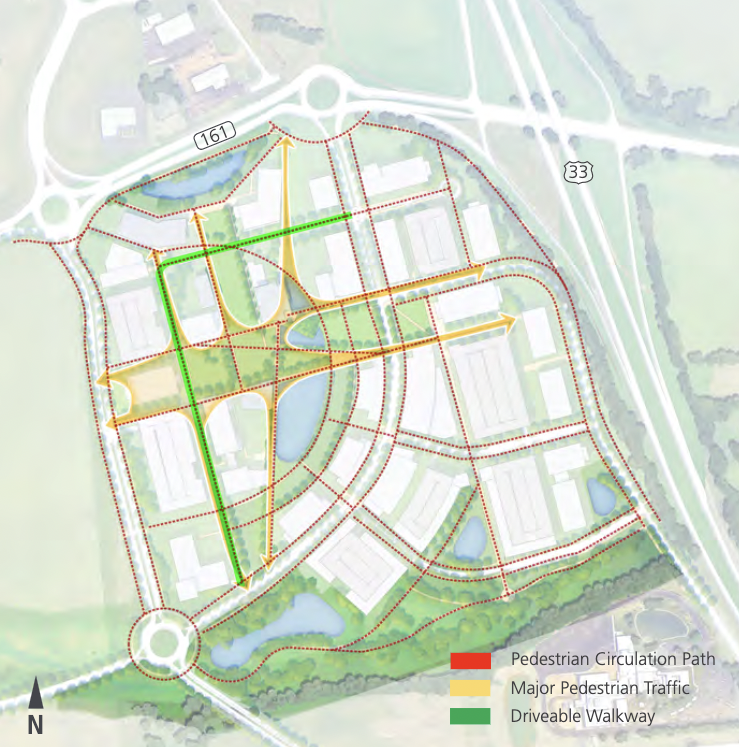
Proposed Pedestrian Pathway Circulation
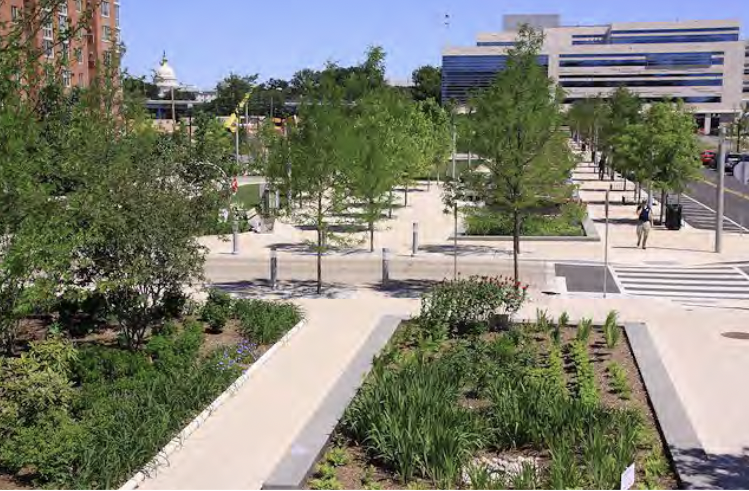
Proposed Pedestrian Pathways Canal Park - Washington, DC
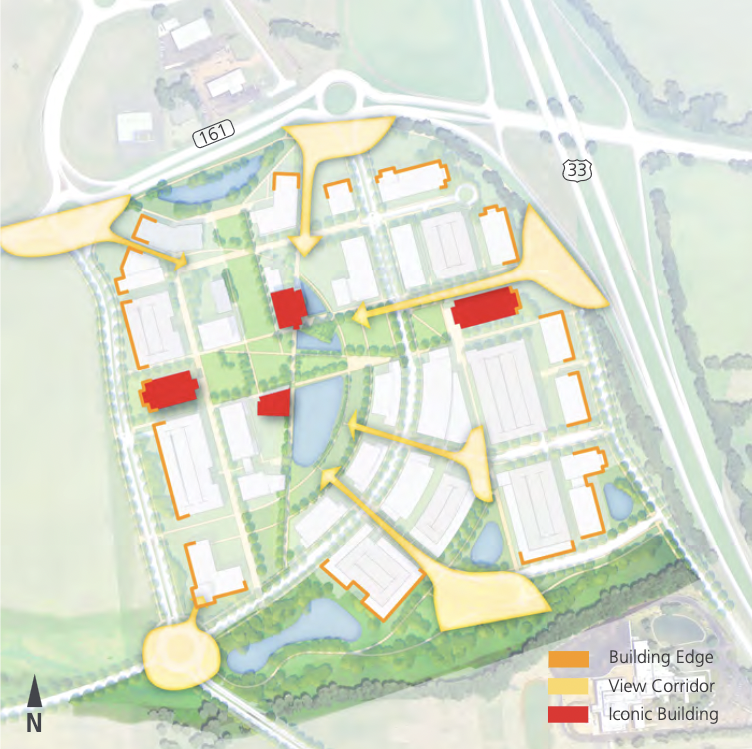
Proposed Key Visibility View Corridor

Example of Gateway Street
5 - Landscape Design Guidelines
Site-wide design principles guide development so that the landscape follows a cohesive and principled development pattern. These guidelines seek to ensure that future development achieves high- quality urban design, enhances the public domain, and contributes to the vitality of the campus district.
1. Conceptual Roadway/Streetscape Types
2. Pathways and Crosswalks3. Site Furnishings
4. Sustainable Landscape Strategies
Conceptual Roadway/Streetscape Types
Main Street Section One: 4 lane Blvd / Campus Gateway:
- Creates an inviting entrance to campus - starts with a Campus Gateway at roundabout and terminates at central green space
- Accommodates high volume traffic
- Hotel/conference center and other types of retail benefit from direct access to high volume traffic road.
- Includes pedestrian crossing areas, street parking, planted medians and 11’ traffic lanes to slow traffic.
Main Street Section Two:
Main Street becomes a two lane street at the Green space.
- Raised and different street paving material to reinforce a pedestrian
environment - No street parking along this section maximize the impact and views of the green space.
Main street Section Three:
- Intimate mixed use street with small shops, campus amenities and potential residential.
- Good highway access and adjacency to naturalized areas
- Provides key location at the southern end of the campus which will tie into the City’s WID plan for a centralized area of activity for the district.
Eiterman Road – 2-lane street
- Eiterman Intersection is before the major green space allowing through traffic to be routed around the campus.
Boulevard
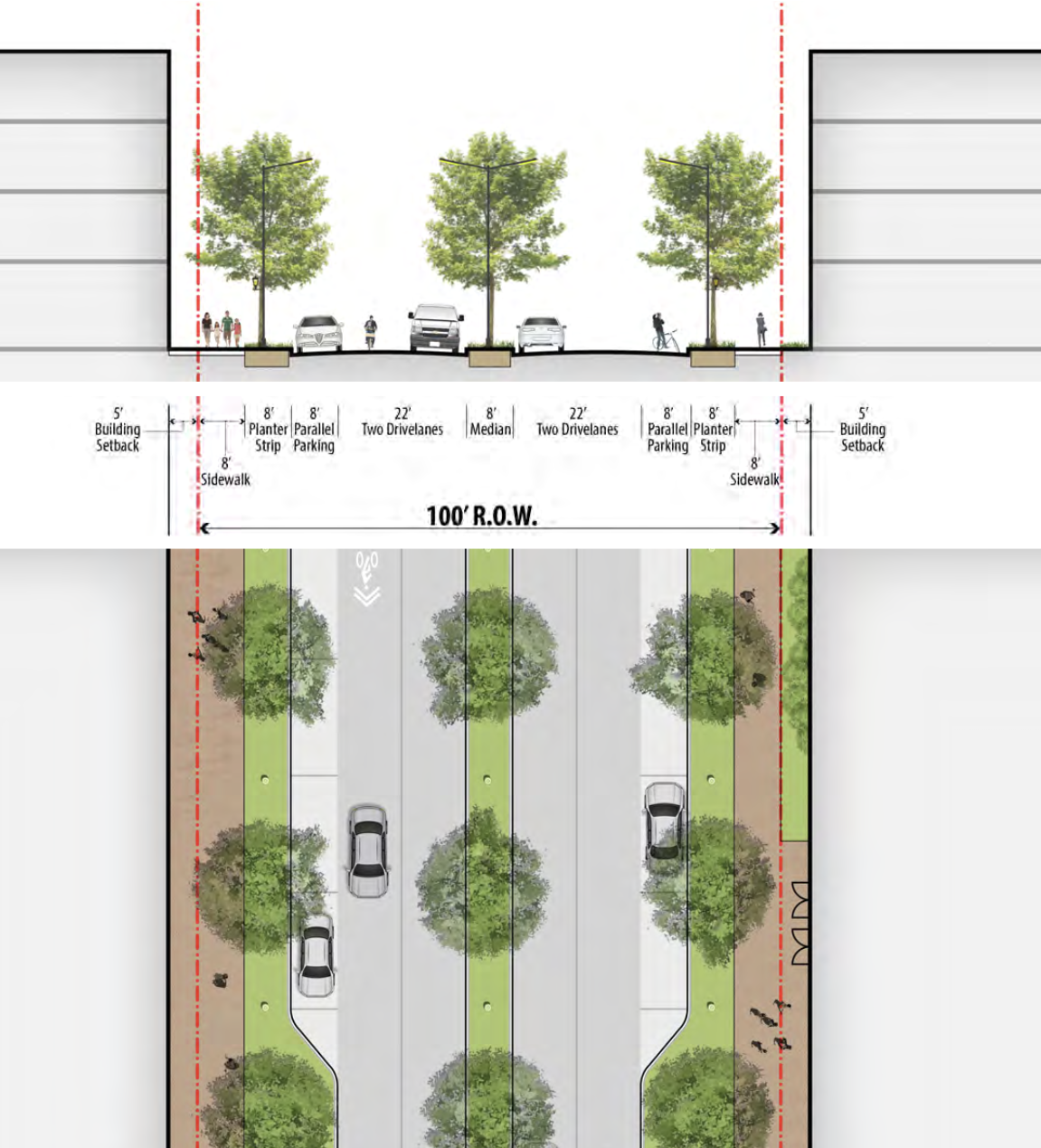
Main Street
- On-Street Parallel Parking
- Curb Walk: Buffer zone adjacent to street parking
- Bike signage
- Planter Strip: Trees and planting,stormwater management, lighting, signage, bike storage
- Sidewalk and Amenity Zone: Defined pedestrian thoroughfare with area for seating, outdoor dining, program spill out
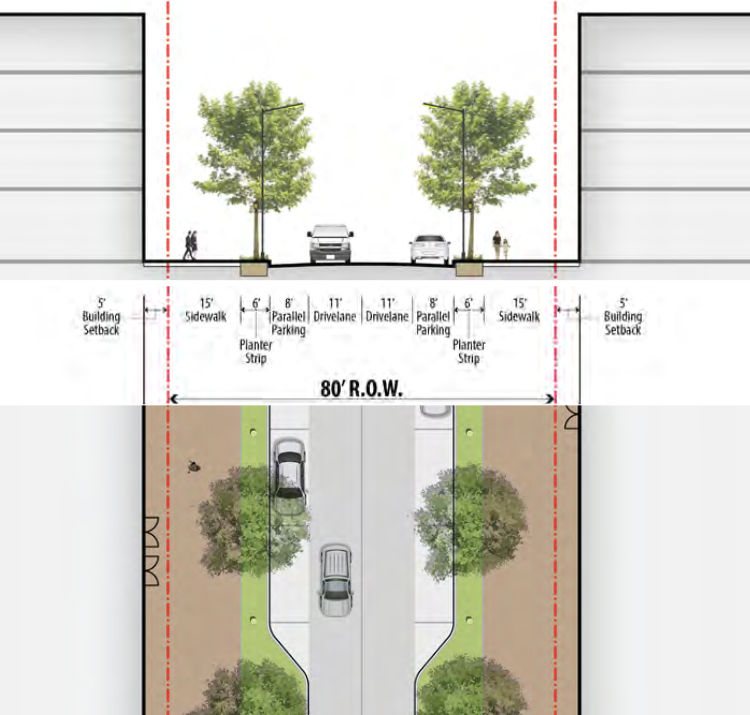
Eiterman Road
- Bike signage
- On-Street Parallel Parking
- Planter Strip: Trees and planting, stormwater management, lighting and signage
- Sidewalk
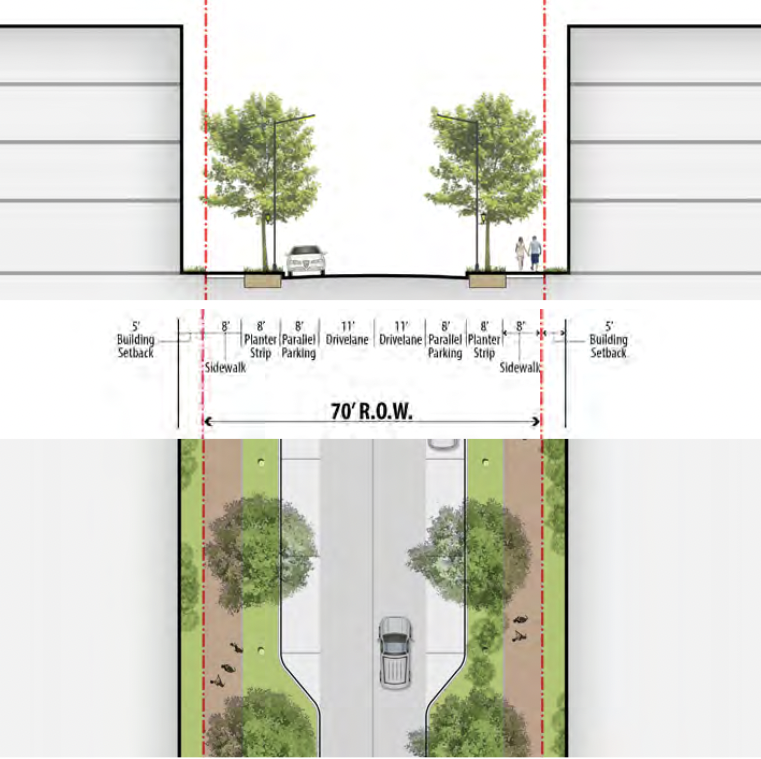
Secondary Street
- Bike signage
- On-Street Parallel Parking
- Planter Strip: Trees and planting, stormwater management, lighting and signage
- Sidewalk
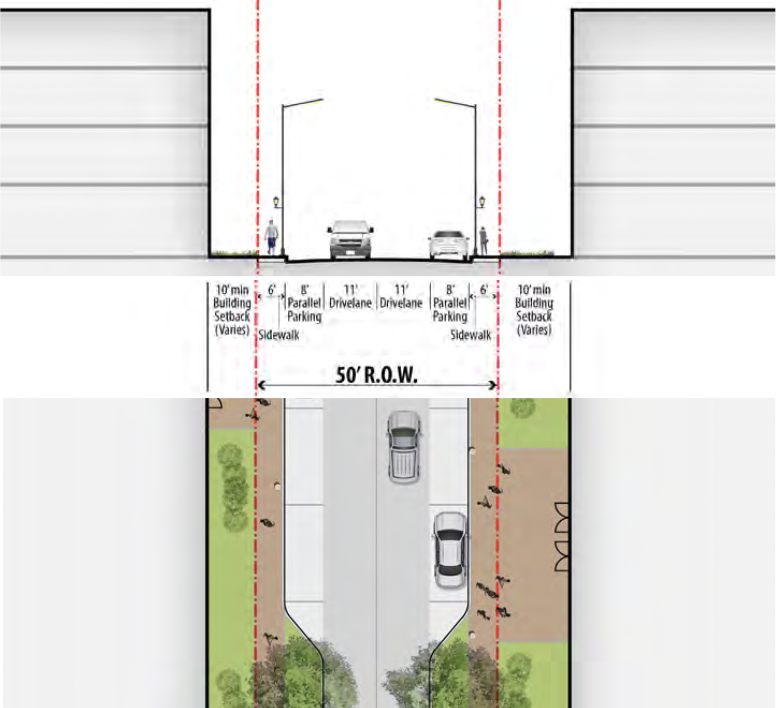
Driveable Walk
- Either provides access to a parking structure or is a driveable and bikeable limited access street for drop-off and service
- Sidewalk varies
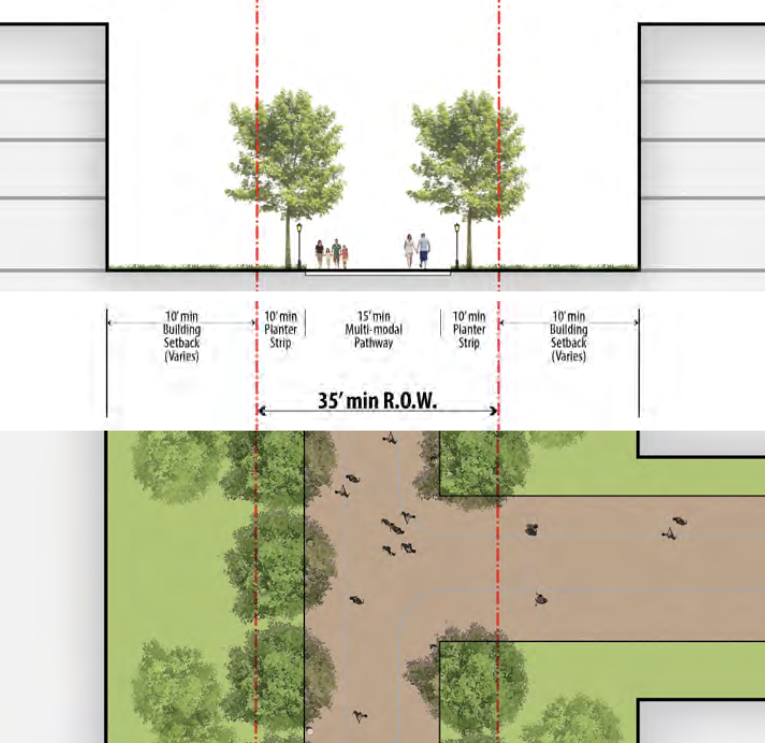
Pathways and Crosswalks
Paved surfaces may consist of concrete paving, brick banding, granite banding, or any combination of these surfaces. Brick banding is common on
the Athens campus of Ohio University and granite has been used in the City
of Dublin in the Bridge Street District.
Pedestrian Pathways: A hierarchy of clear and unobstructed pathways should be established with a flexibility of materials (concrete, brick, and granite banding). These pathways should define, connect, and unify varying scales of open space. Wide, primary pathways should be near main building entries and areas of the highest level of pedestrian movement. Narrower secondary and tertiary pathways may link primary pathways.
Crosswalks: All street intersections should be designed to prevent pedestrian/vehicular conflicts and include crosswalks and curb ramps. In order to establish a unified aesthetic, crosswalks should be of consistent width and materiality. They should also be a different paving material, texture, or color from the street paving.
Site Furnishings
Site furnishings should be uniform and consistent except where they serve a
dual purpose as public art or special branding. Other landscape elements
should be used to create a sense of campus identity, such as banners. Street lights should be selected and placed to create an even rhythm and consistent, safe light levels along streets. Pedestrian-scaled street lights should illuminate the sidewalks to supplement the taller vehicular lights. Proper shielding and directionality should be included in choices of lighting elements in order to minimize wasted energy and light trespass.
Bollards should be used primarily to prevent vehicles from entering the pedestrian-only zone at street intersections with crosswalks, building drop-off areas, or where amenity space abuts the roadway (specifically service streets).
Other sustainable landscape strategies that could be implemented includeconstructed wetlands, design of waterwise garden techniques (xeriscaping), landscape irrigation using gray water, structured soils, rain gardens, and shade trees to reduce heat island effect.

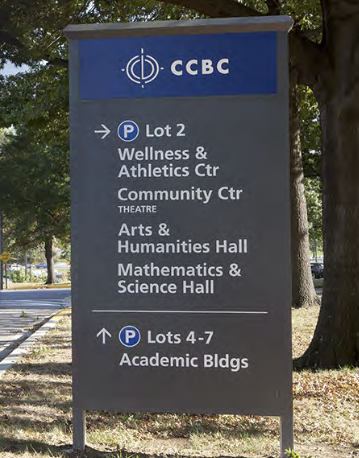
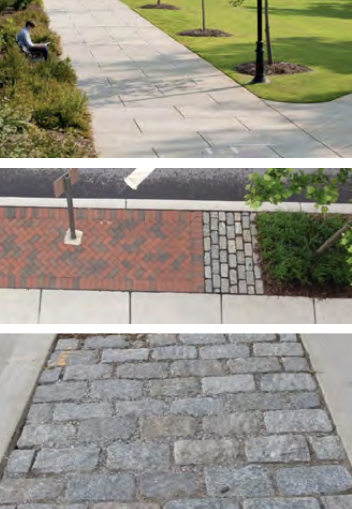
Sustainable Landscape Strategies
A comprehensive approach to stormwater management would be possible through planned sustainable strategies for open spaces as well as streetscapes. For example, the campus landscape should utilize low-impact development techniques and manage water as close to the source as possible. Hardscape areas should incorporate some porous and permeable pavements to absorb rainwater. Green roofs should be incorporated into building design, if possible, and bio-retention features should be placed adjacent to hardscape areas to store and filter stormwater runoff and allow it to infiltrate the site. These strategies, if implemented, would work to harvestand re-use rainwater.
Another sustainable landscape strategy would be the implantation of an urban farm/garden. Urban farms are educational gardens with the goal of creating opportunities for the community to learn how to eat for health. If implemented, an urban farm should be designed to be a living classroom where students, faculty, staff, and the community come together to explore the connectionbetween land, food, and health through hands-on learning.
Other sustainable landscape strategies that could be implemented include
constructed wetlands, design of water-wise garden techniques (xeriscaping),landscape irrigation using gray water, and shade trees to reduce heat island
effect.
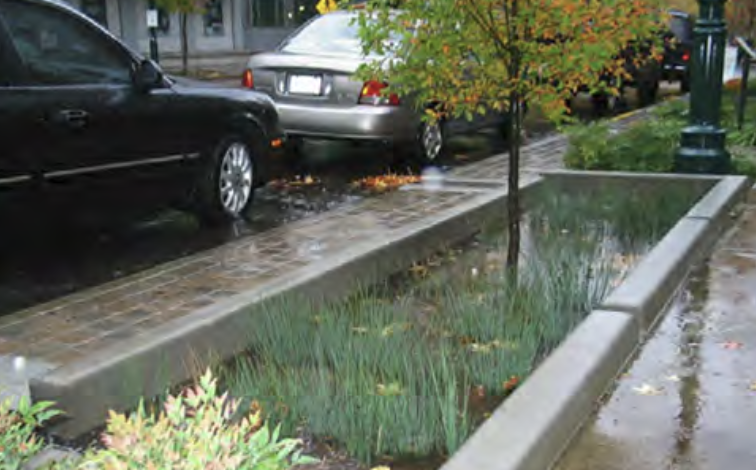

6 - Building Design Guidelines
Similar to landscape design guidelines, the building design guidelines ensure that the quality and relationships within the built environment support the goals of the Framework Plan. The building design guidelines are not meant to prescribe a distinct architectural style but create an identity that complements the location while still maintaining unique attributes that are important to the Ohio University identity.
1. Building Form
2. Green Roofs
3. Signage
4. Street Level Experience
5. Building Elements
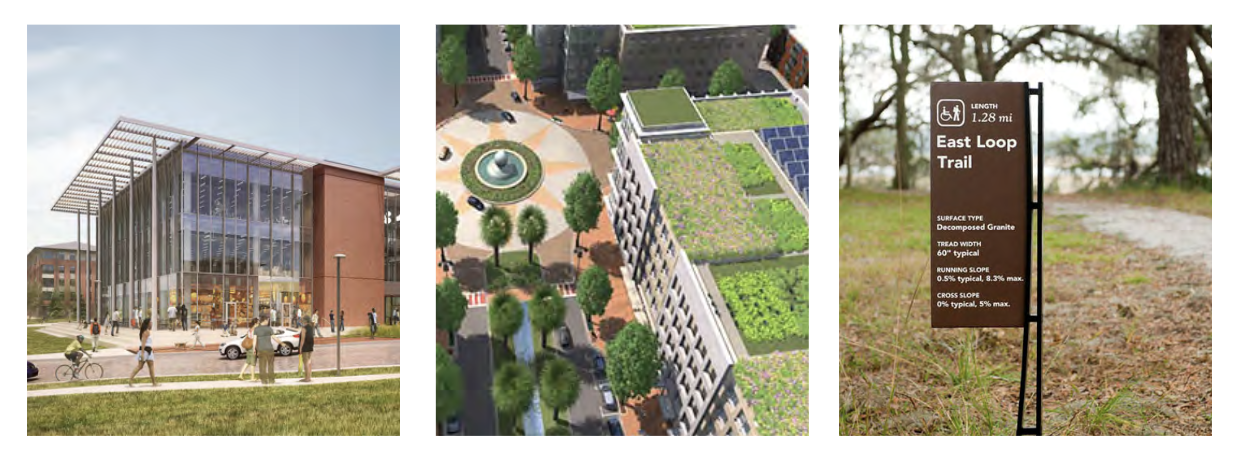
Building Form
A variety of scales and forms within a public district are fundamental to design vibrancy. A mix of high-rise (3-4 stories) and low-rise (1-2 stories) buildings are designed to complement the current density mixture. Larger buildings should be broken downs into multiple vertical and horizontal volumes making them more of a human scale. It is also designed to provide a sense of traditional character, allowing the campus to feel as if it was developed over time. Facades and building elements that terminate prominent streets and view corridors should serve as symbolic gestures and orienting devices in the
urban context and should be treated with architectural significance. These
sites should include the iconic sites along the main east/west open space.
Setbacks:
In order to control building massing and form, upper level setbacks should be used to reduce the bulk of buildings and their appearance on the street. This would allow for a more harmonious streetscape experiences even in the presence of a variety of building scales and sizes.
Public/ collaborative spaces:
The architecture of the campus district should express the ethos of collaboration, invention, and connection. These spaces can be viewed as opportunities to be architecturally expressed both in the buildings massing and at the street level to enliven the streetscape zone.
Green Roofs
Green roofs are a key sustainable building element. They reduce energy costs by helping to mitigate the heat island effect and help reduce the volume of storm water retention. They also provide a habitat for plants and animals, increasing the local biodiversity, and can be a source of additional useable open space. Green roofs are a more aesthetically pleasing roof surface when viewed from taller structures. Green roofs can be linked to bioswales and other at-grade stormwater treatment systems to provide a fully connected,systematic approach to water quality management.
Signage
Campus, directional, and building signage should be complementary and form a brand for the campus. Signage should be integral in all scales of building design as well as pedestrian-oriented in size, placement, material, and color. In designated areas, larger iconic signage can be auto-oriented and designed to be seen from a long distance but should be complementary to other signage. Even though there may be multiple partners on the campus or within buildings, the signage should all be part of an integrated strategy. A master sign plan should be prepared for the campus and approved by the City in order to establish a cohesive wayfinding system that facilitates individual signinstallations.
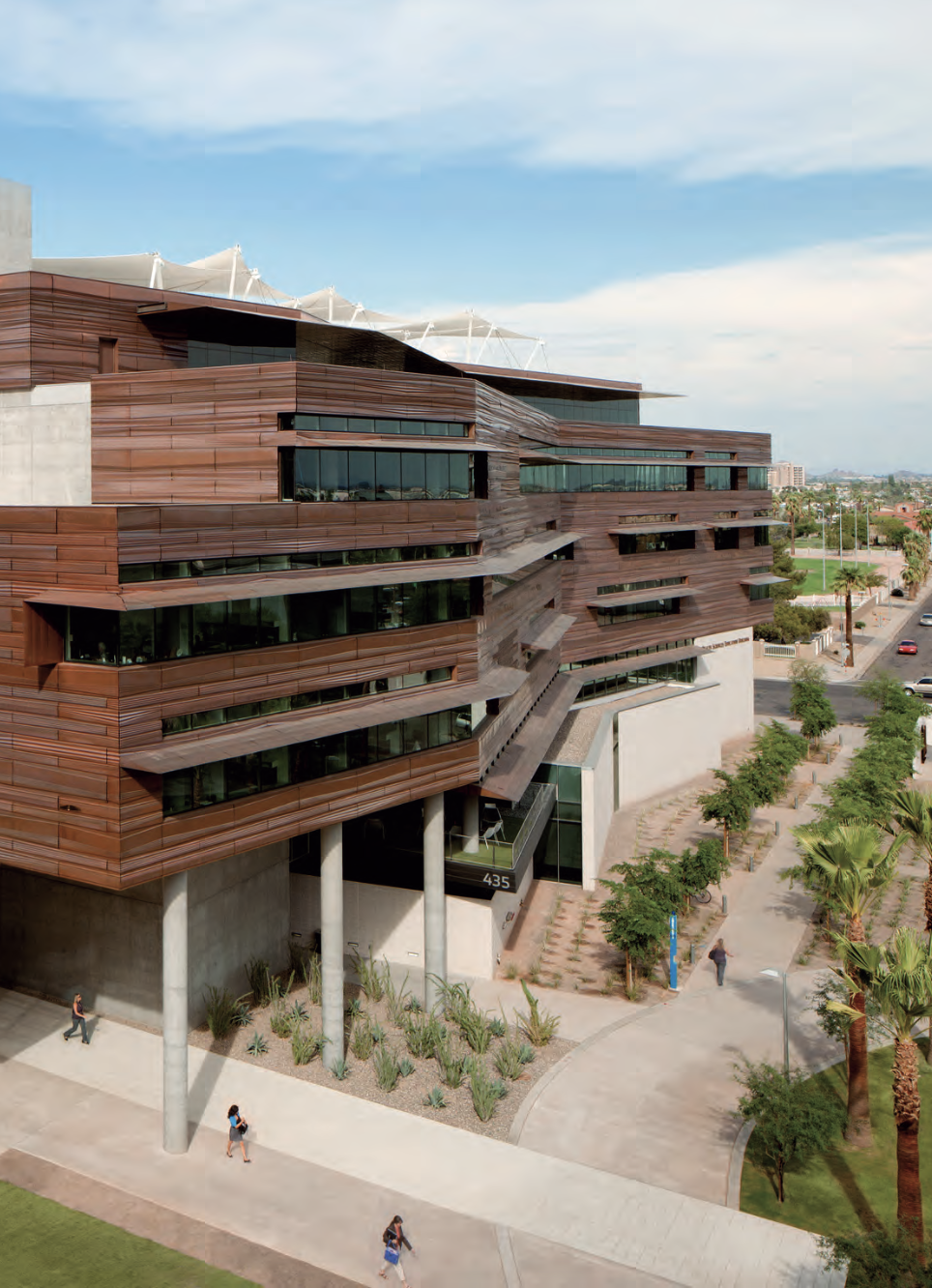
Street Level Experience
Building Entry and Streetfront:
Building entries and streetfronts should be open and transparent, creating a connection to the indoor activity of the building. There should be a minimum 60% transparency at all buildings at the ground floor levels with maximum transparency along active streets. Signage should reinforce building entries and be pedestrian-oriented where appropriate.
Public Storefront:
Buildings along the Main Street should become an extension of the sidewalk.
Storefronts should incorporate and display windows amounting to a minimum of 60 % of the surface area of the entire ground floor façade. The area between 3 feet and 8 feet above grade should reach a minimum of 80 % transparency. Store entrances should be spaced at intervals that encourage active streetscapes, not more than 60 feet apart on average. The zone directly in front of the building should provide space for street furniture, sidewalk dining, or other outdoor gathering areas that reflects the quality and character
of the public space. To maintain accessibility, public floors should match the grade of the sidewalk wherever possible.
Service and Loading:
Service and loading entrances should be limited on or near important streets. These elements should be consolidated and face alleys or internal courtyards where screening should be provided. Sidewalk material should continue across access drives. Street planting can exist but not interfere with loading aisles and right of ways. Fencing, site walls, bollards, and other landscape elements are appropriate materials to screen trash, loading, and service court areas so they remain out of site from the public realm, provided the screening complements the associated building design.
Building Elements
Windows:
All windows should be appropriately sized and proportioned for the building scale and function. Storefront windows should be used frequently to enliven the sidewalks and glass should not be tinted at the ground floor level.
Doors:
Doors should be proportioned to the scale of the building and be aluminum
with storefront glass to provide a high degree of transparency at the lower
levels.
Balconies:
Balconies provide additional, unconditioned floor space to buildings and bring activity from the interior onto the exterior of the building. These can be fully recessed within the architecture of the building or fully projecting, and they should be proportional to the particular architecture language and scale.
Canopies:
Canopies are encouraged at entries to provide weather protection and visual interest to the public realm, to provide another layer to the streetscape, and to introduce variety to the façade. Canopies should be a seamless extension of the building’s architectural language and style.
Penthouse and Mechanical Systems:
These systems should be hidden from the street level and screened to their full height. This is important for aesthetic reasons as well as noise suppression. The mechanical systems should be an extension of the building mass and façade. They should be thoughtful of materiality and placement on the roof. Louvers, vents, and other systems that provide exhaust and ventilation to the mechanical equipment should be architecturally integrated.
Materials:
High-quality construction materials are recommended to ensure building integrity and longevity, including masonry (brick and stone), metal, concrete, tile (ceramic or terracotta), cementitious panels, and glass.
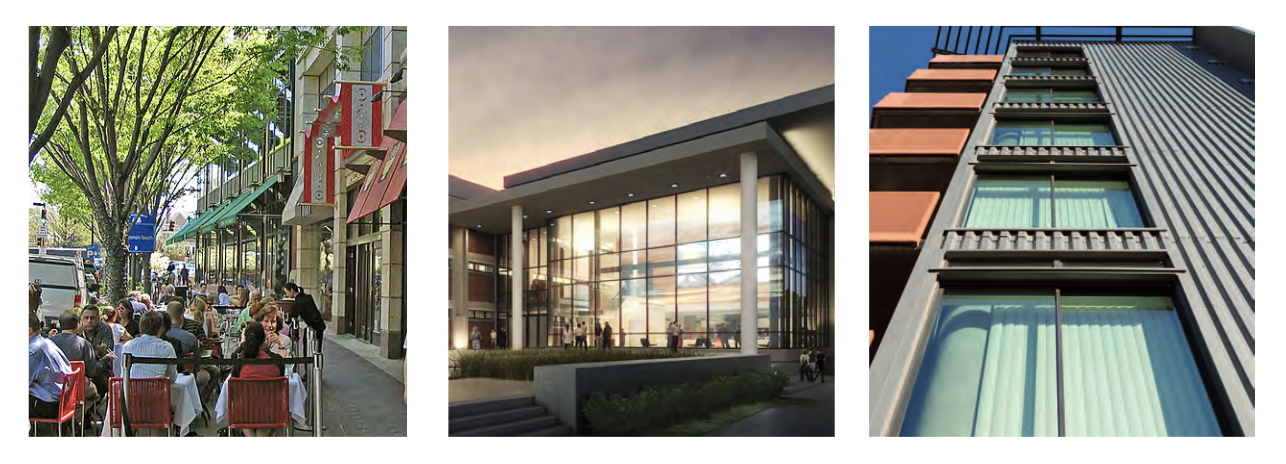

Framework Plan Summary
The Dublin Framework plan is a “vision” plan intended to offer a comprehensive view for how the campus may evolve over time and is intended to guide future development. This plan is designed to allow the City to review the campus in context of the West Innovation District, making approvals of future projects easier. The plan is designed to be a valuable tool to the University to facilitate decisions on future expansion within the context of the bigger picture.
The Framework Plan aims to establish a vibrant community that provides
opportunities for high-impact initiatives and programs that are complementary
to the central Ohio community, advance Ohio University interests, and cannot be accomplished in Athens. It contemplates a mixed-use environment that supports a vibrant knowledge community. It is centered on creating a pedestrian-friendly, walkable campus district that can be implemented in a phased approach over time.
Framework Plan Vision Components:
- Public realm clearly defined by key building frontages
- Interconnected framework of open space
- Vibrant Main Street
- Strong pedestrian connections
- Visibility into and across the campus
- Discreet service areas
- Consolidated parking
The plan aims to create a campus district identity by establishing a central
place, creating strong physical connections, supporting a dense mix of uses,
and fostering collaboration by providing opportunities for inter-disciplinary
interactions and strategic partnerships. It is designed to advance “OHIO for
Ohio” opportunities to build and strengthen regional partnerships with industry, government, and non-profit organizations to foster innovation.
Note: The Framework Plan was developed in conjunction with:
- Economic Development Agreement by and between City of Dublin, Ohio and Ohio University relating to Ohio University Extension Campus
- Economic Advancement Zone, Central Ohio Innovation Corridor
- OHIO’s Innovation Strategy ( www.ohio.edu/researchinnovationstrategy.cfm )
